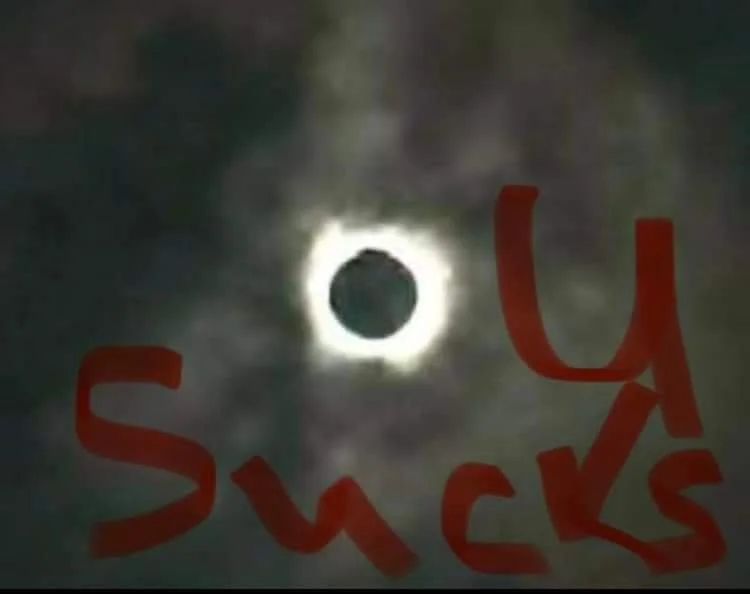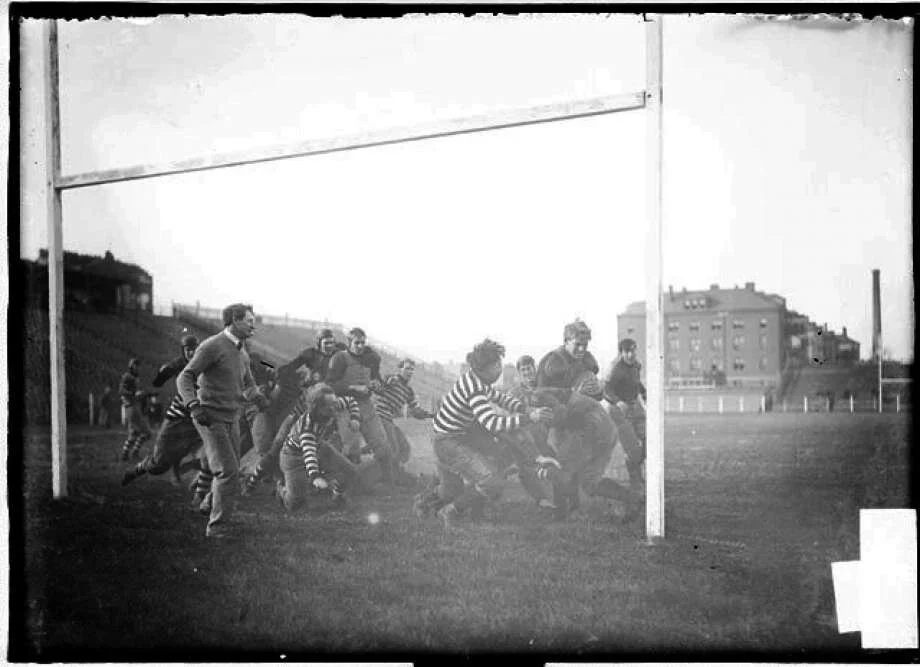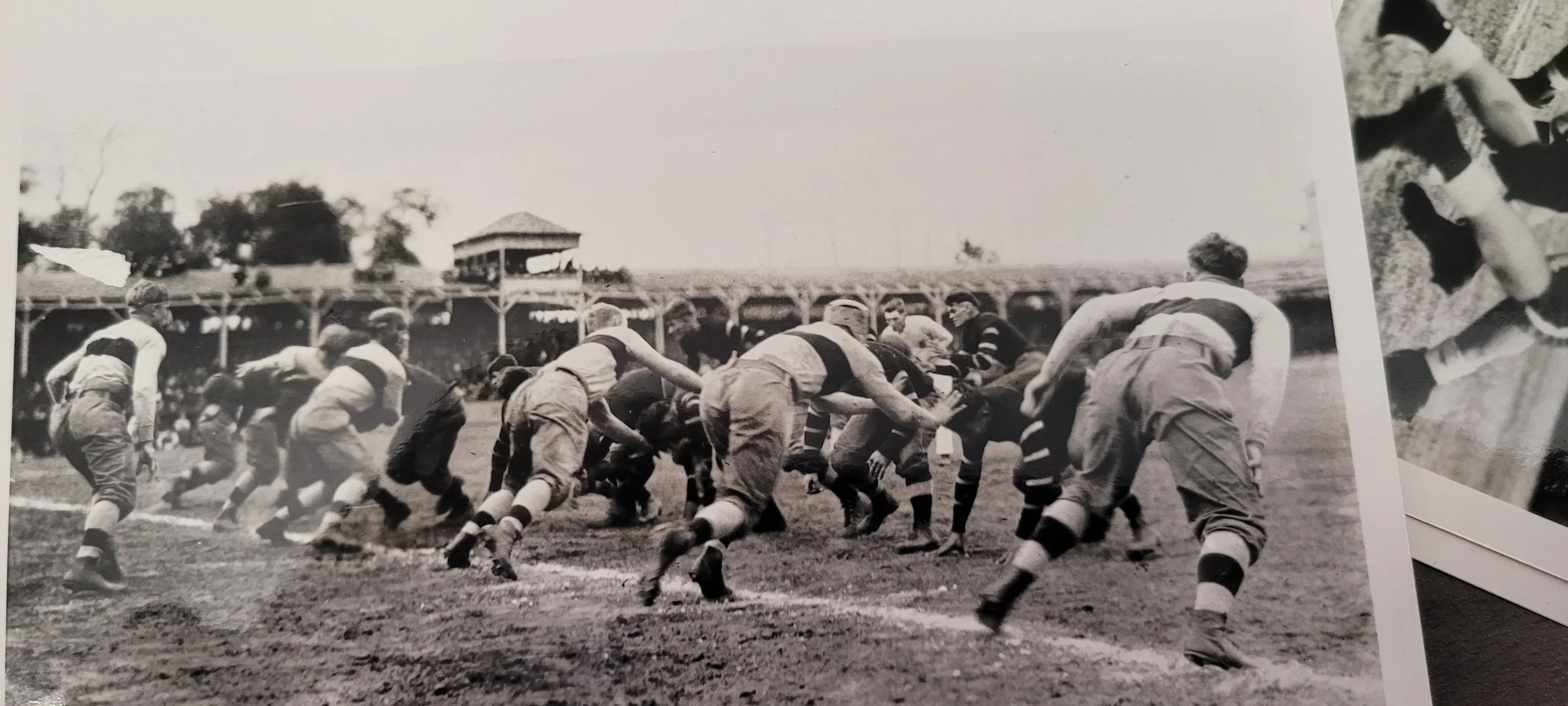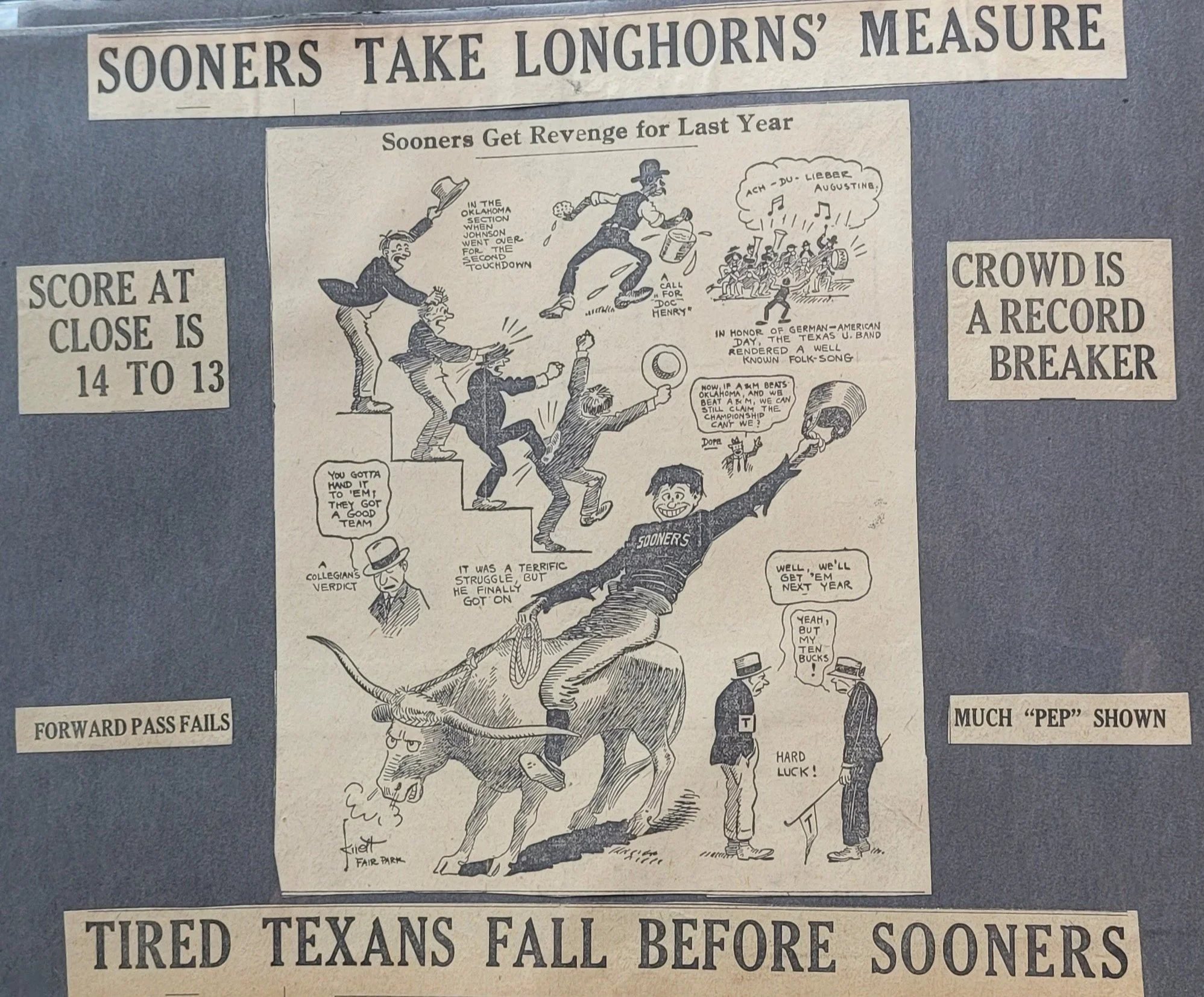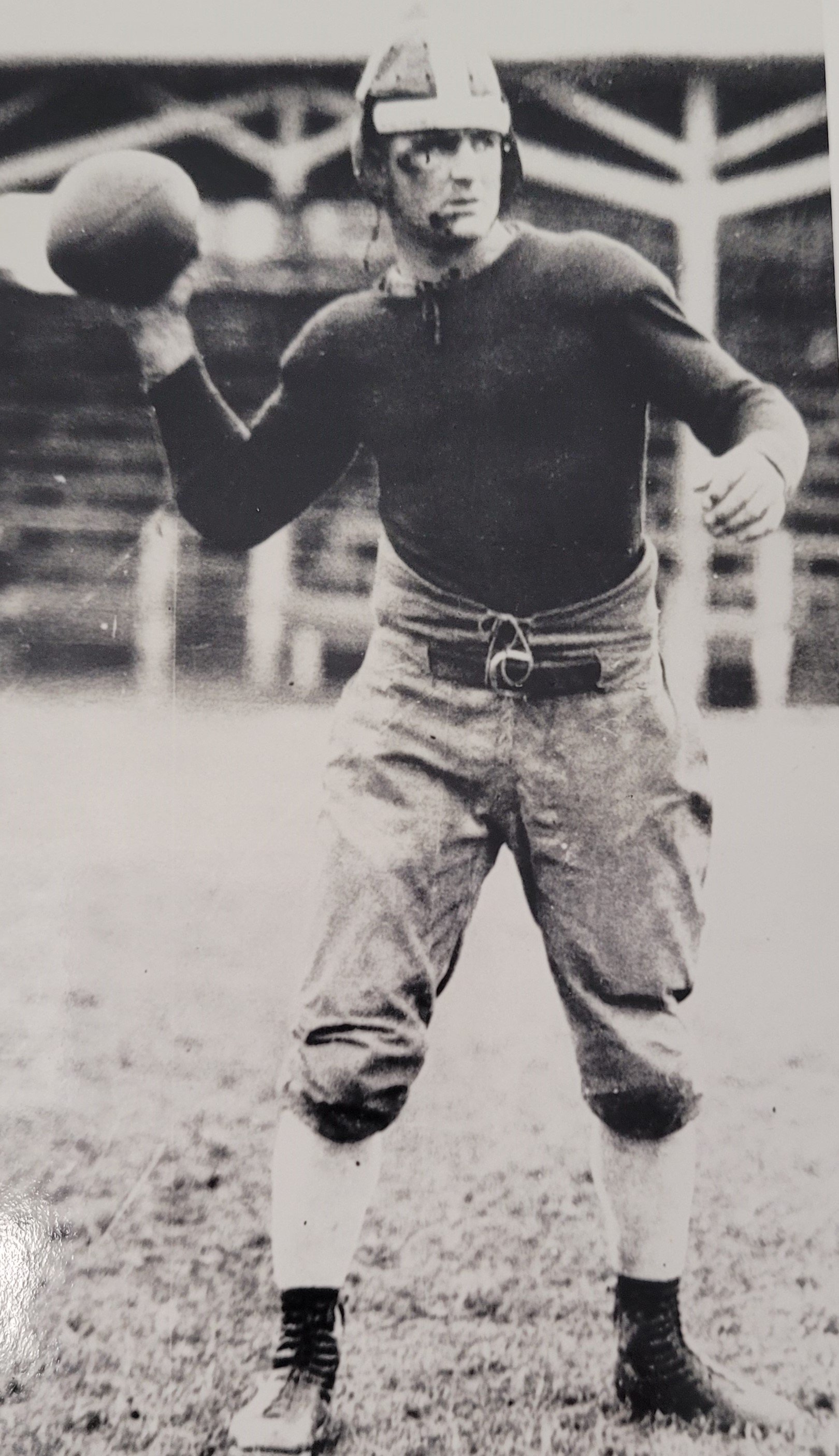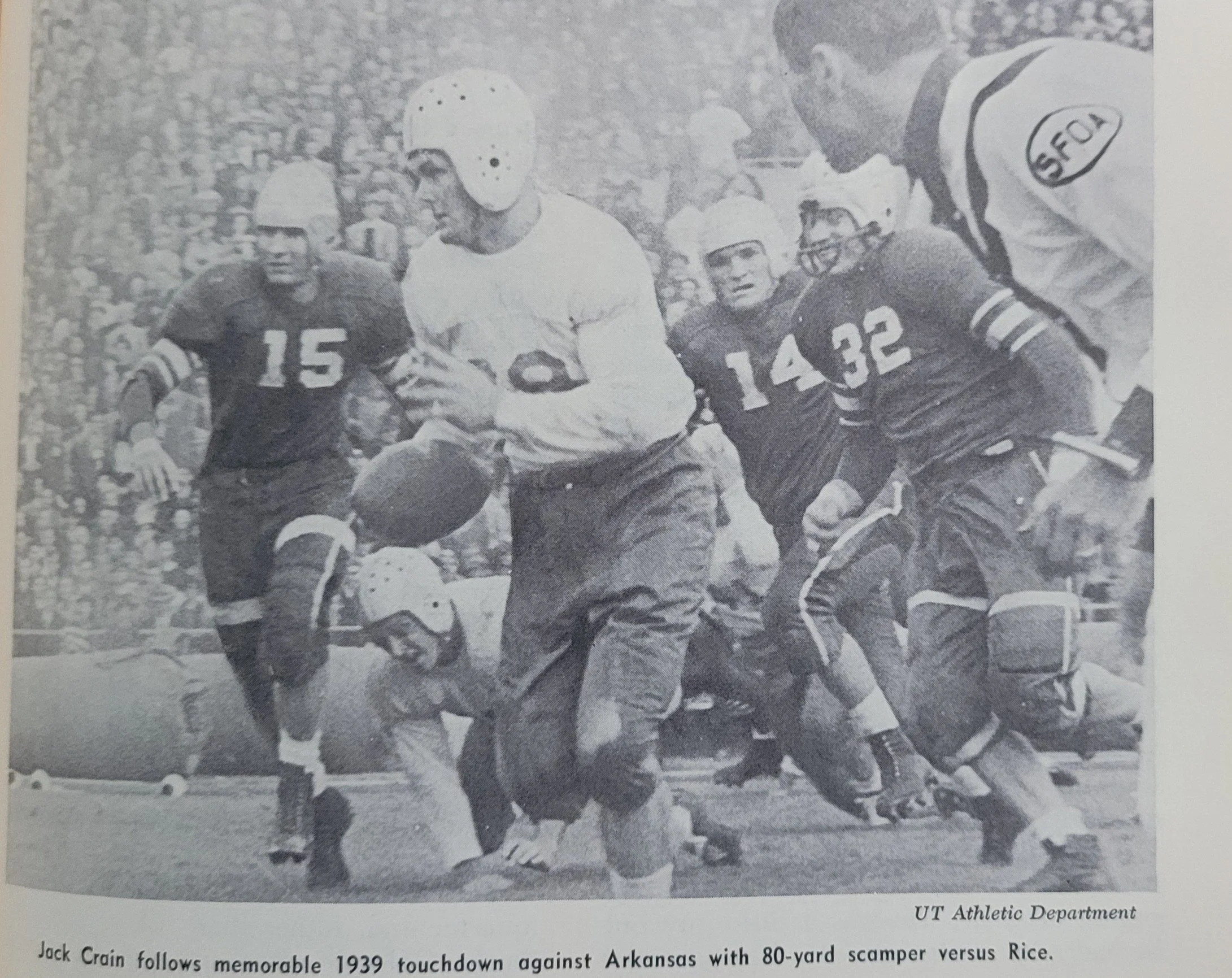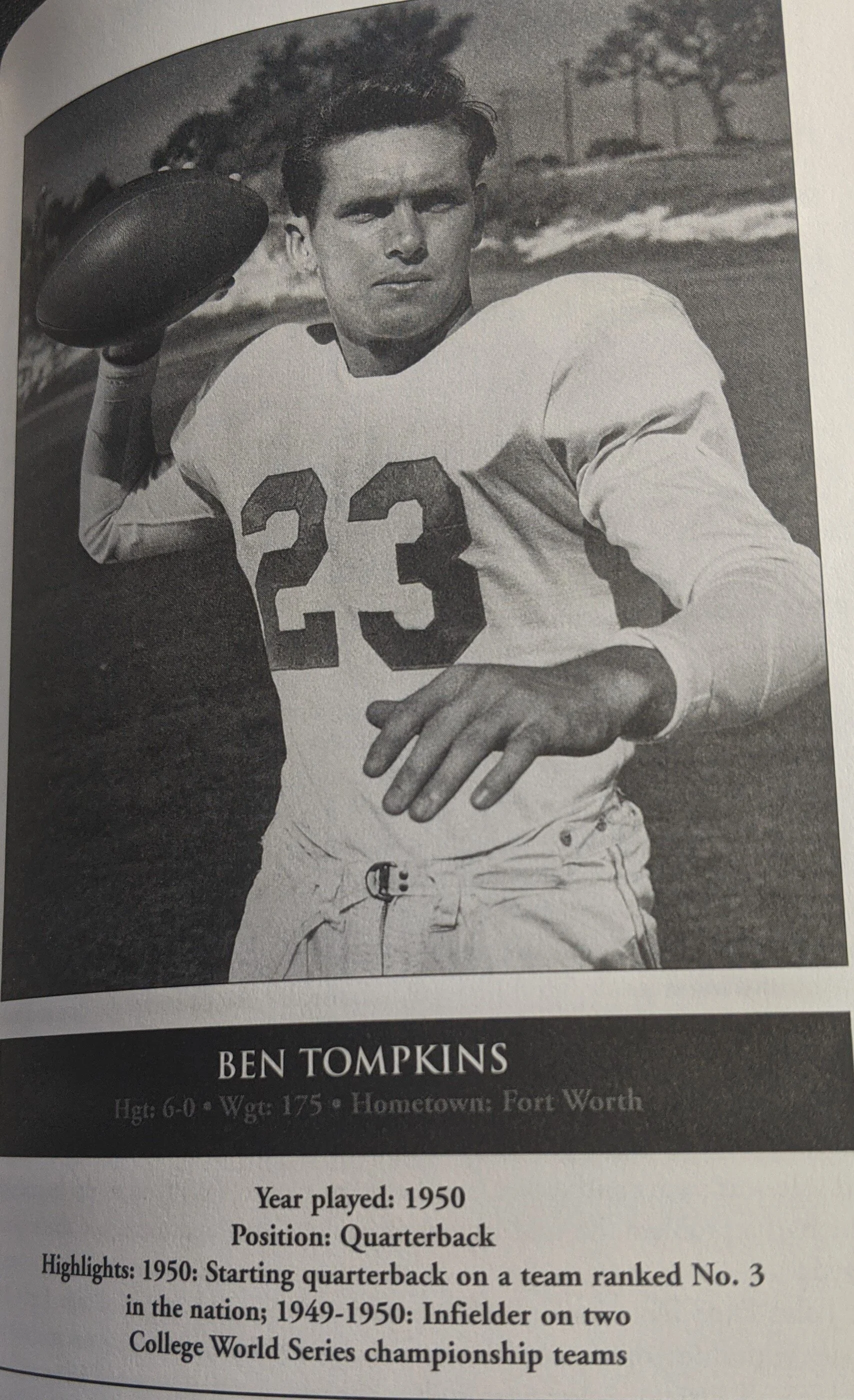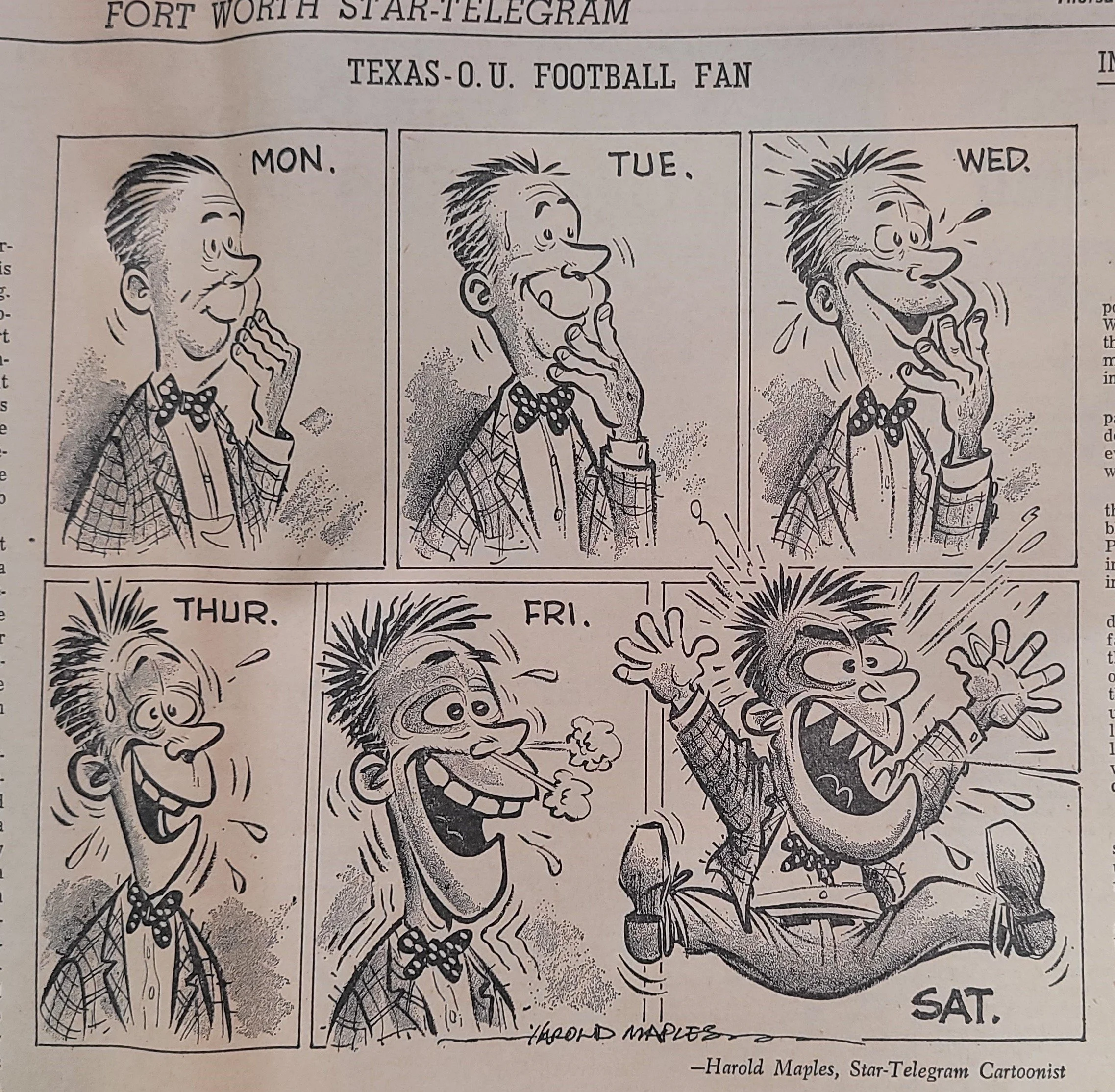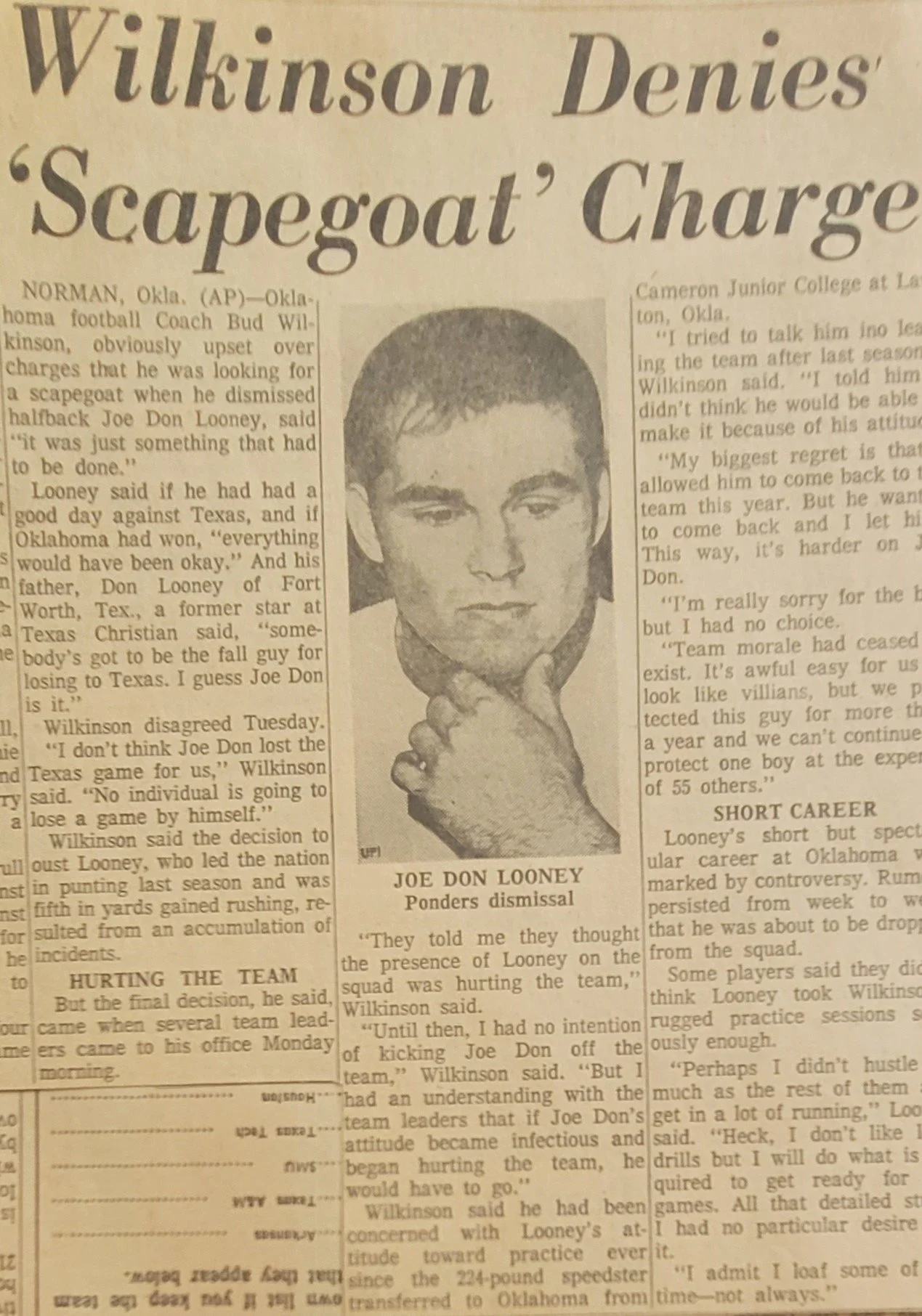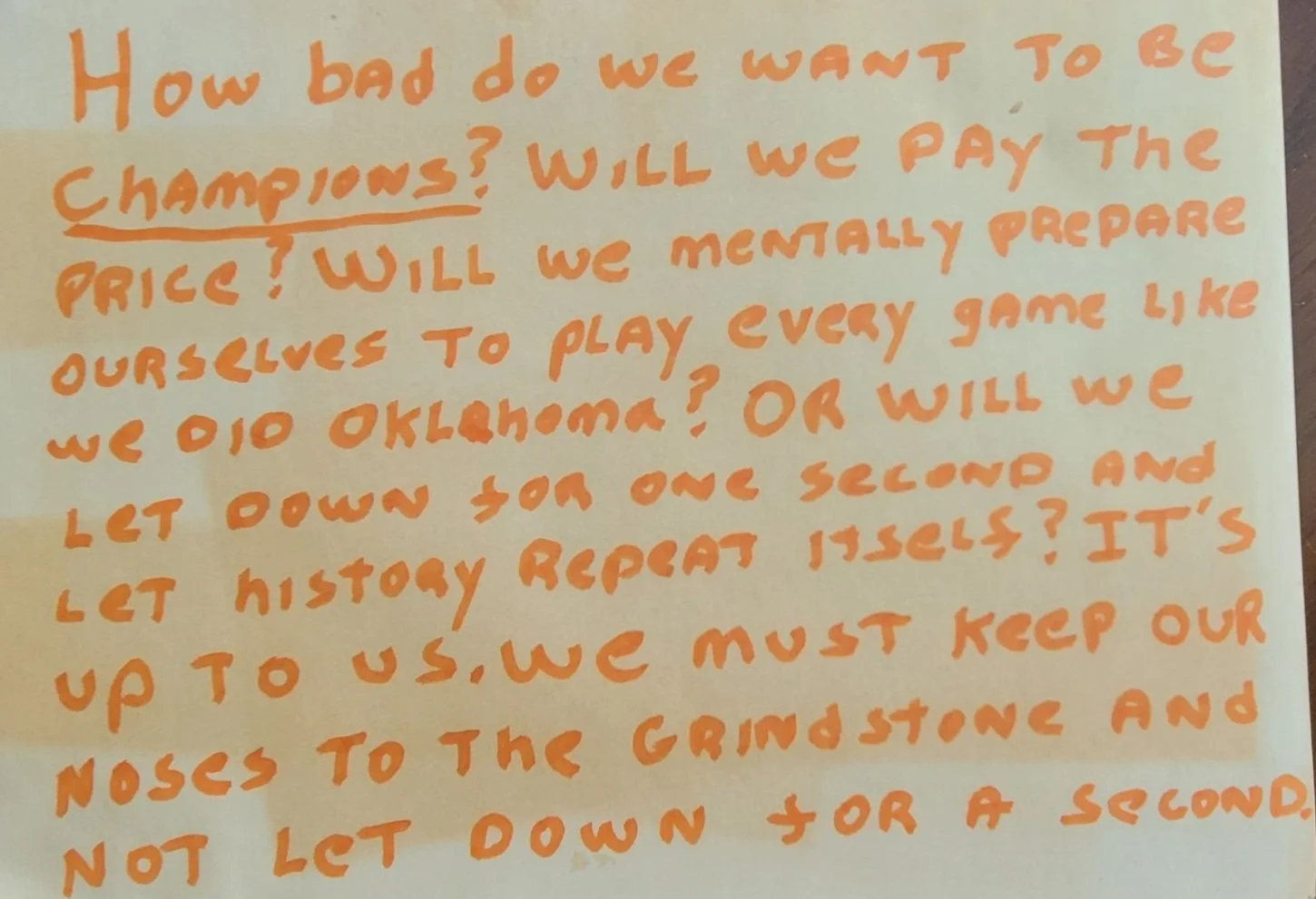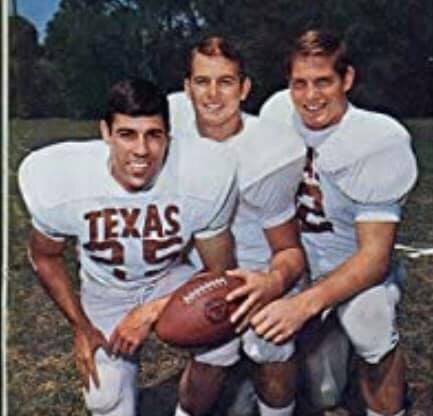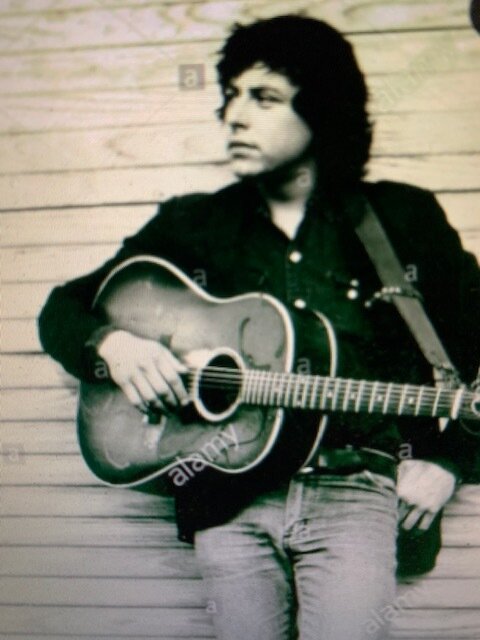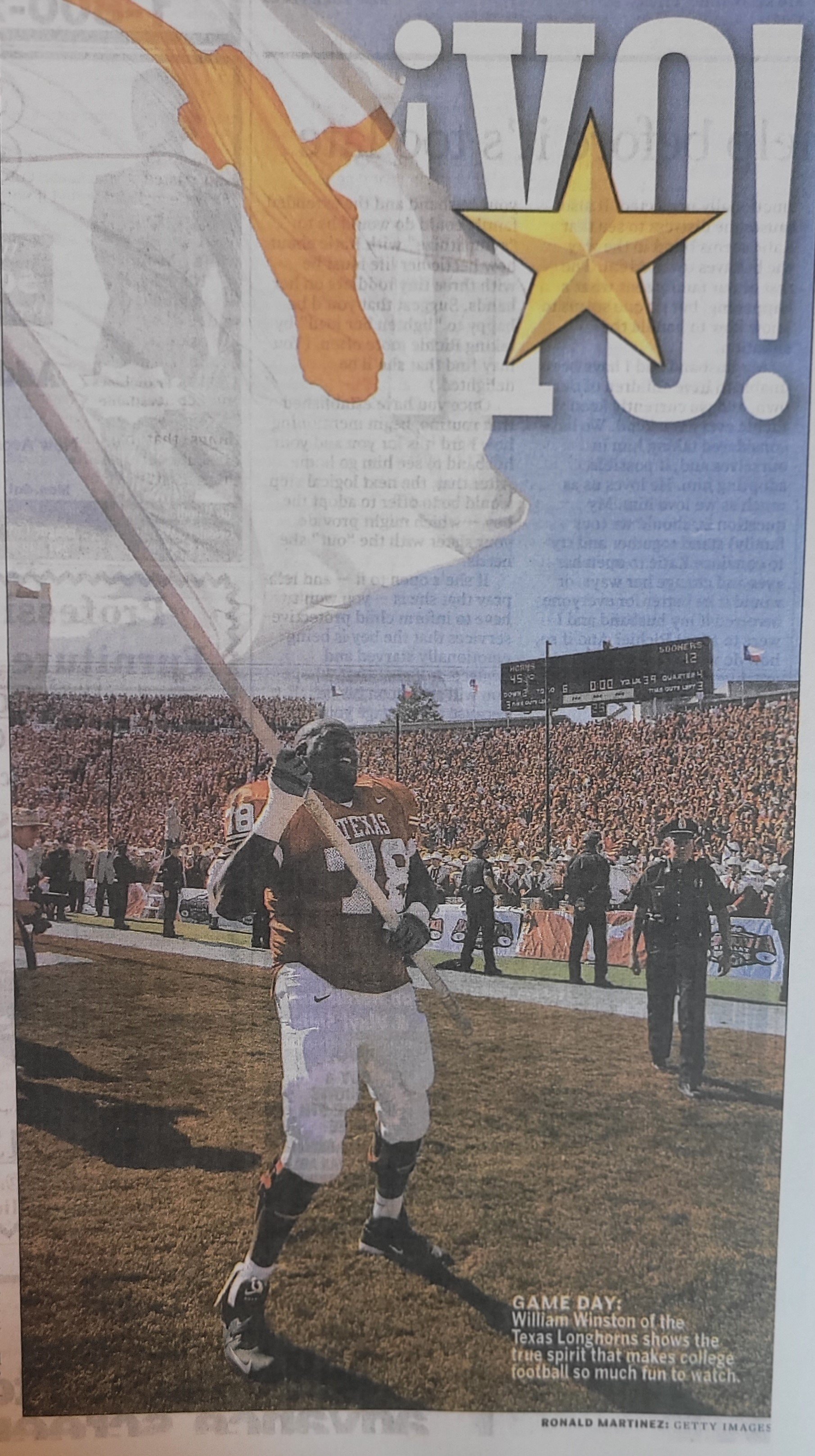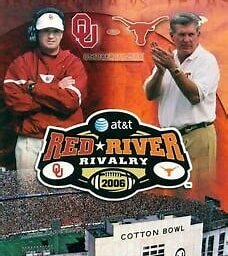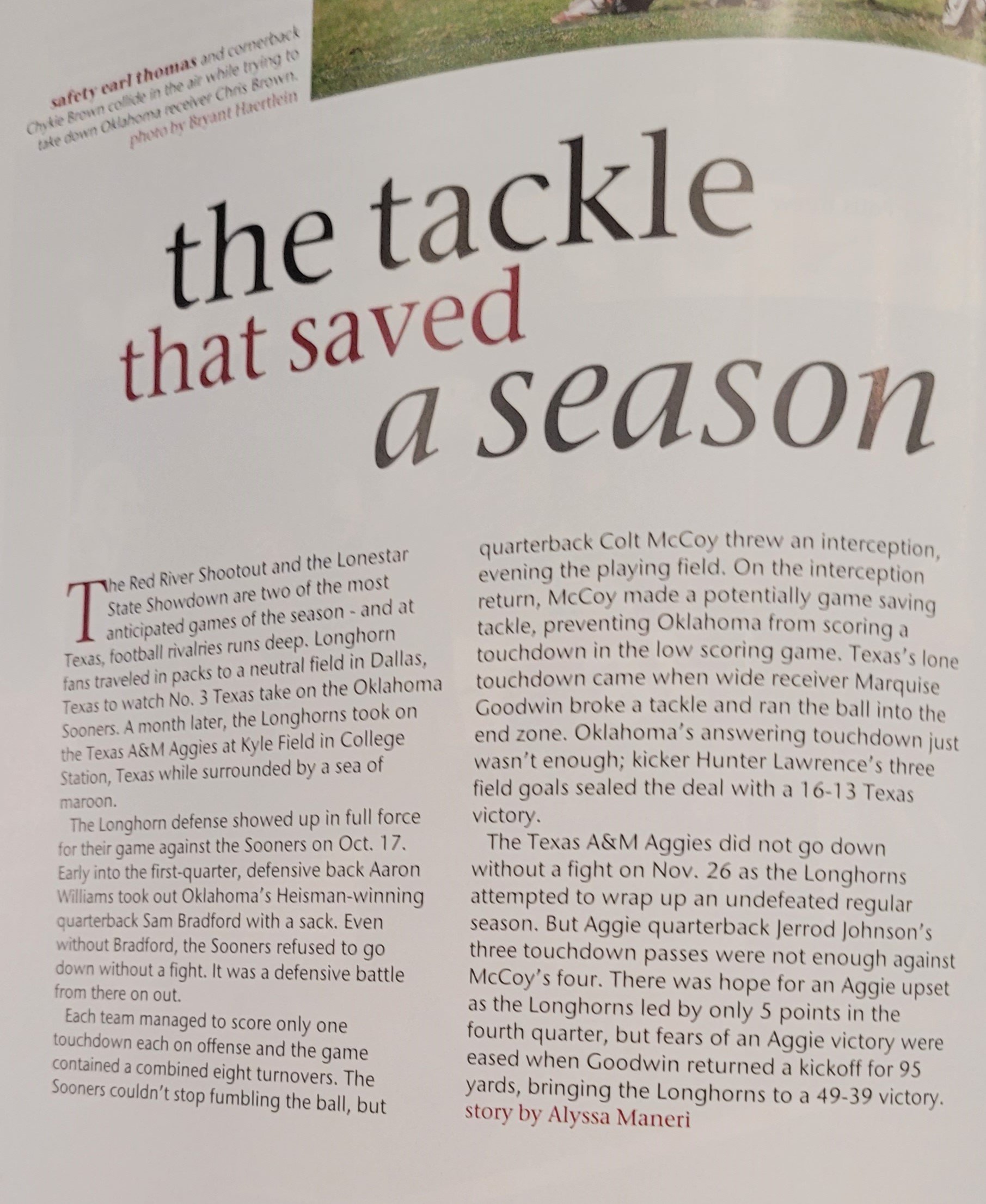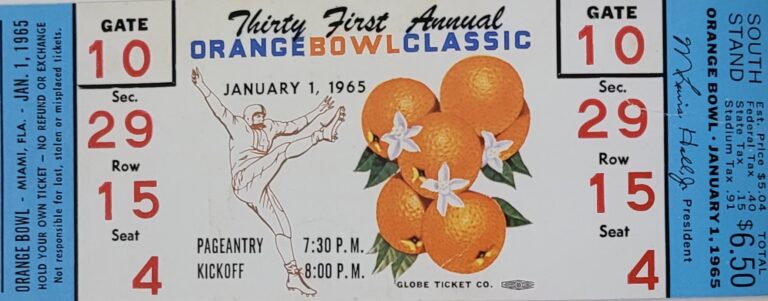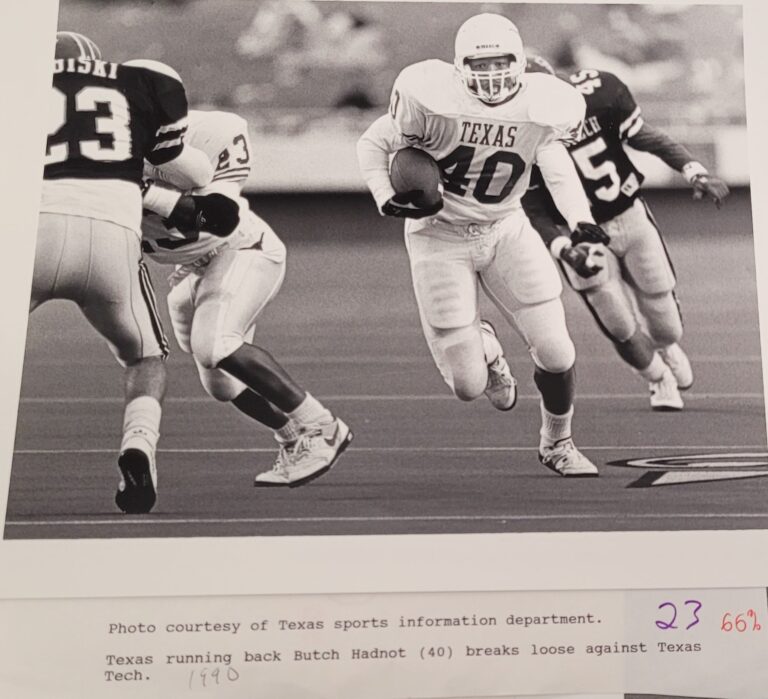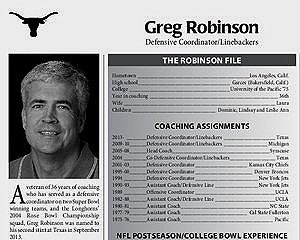Texas-OU Red Rivalry and a River Runs through it
Longhorns have eclipsed OU in the race for total national champions for all sports. O.U is not even close to the Longhorns as a champion,
And a River Runs Through It.
Norman Fitzroy Maclean (December 23, 1902 – August 2, 1990) was an American author and scholar noted for his book “A River Runs Through It.” In the movie rendition of his book, there is a profound statement about how rivers reveal the history of time.
Watching the movie, my thoughts focused on the essence of time as told by the Red River. The movie quote goes:
“Eventually, all things merge into one, and a river runs through it. The river was cut by the world’s great flood and runs over rocks from the basement of time. On some of the rocks are timeless raindrops. Under the rocks are the words….” (AND OU STILL SUCKS).
In the book by Pete Davis, “I Hate Oklahoma, and I Love Texas,” the author makes a valid point that is part of Sooner football. Pete Davis says,
“The Oklahoma Sooners cheat. …. It is in their nature. Heck, it’s even in their very name!. “ Sooners were settlers who cheated to claim the good land. “The O.U. football team has been caught more times thant the Hamburglar. The first official reprimand from the NCAA came all the way back in 1955. Seems some players were getting their bills paid by the school…… It didn;t stop at the players, either. Their families were getting money, too. Oklahoma received probation for the infractions.
The NCAA came visiting again in 1960. This time investigating A slush fund for players. And athletics department official tried to slow down the probe but the NCAA still discovered that OU staffers were running the fund. The team was placed on indefinite suspension until they could prove the fine no longer existed.
In 1973 in Oklahoma assistant played fast and loose with the facts on the players transcript to make sure that he would be eligible to play. Boosters were also caught giving cars recruits at that time period the NBC AA tends to frown on this so they ban the centers from playing in a bowl game or even on TV.
Throughout the 1980s and coach Barry switzer’s regime ohh you players openly flaunted their expensive cars and clothes. Some even wrote about it in their autobiographies. But in 1988 the chicken came home to roost and to talk to the NCAA. So the school administration set up their own investigation and shockingly found nothing amiss. The NCAA’s investigation however revealed that assistant coaches had paid bills provided rides and stuff on blocks with cash for recruits. Players had also been selling their game tickets. What was worse for all you the players were talking. So the college investigated a second time. Surprise surprise as gomer Pyle would say once again they found no wrongdoing. If all you officials had been in charge of the watergate investigation richard nixon would still be president
but the NCAA disagreed and the Sooners got hit with a three-year probation and a one year bowl game ban. Ohh yeah and i almost forgot coach switzer was canned. The boys and norman laid low for a decade or two after that debacle. In 2006 before the season two players were asked to leave the team including quarterback Rhett bowmar. Seems they had been working at a car dealership. Nothing wrong there right well when I say working I mean that they were collecting a paycheck but never actually showing up to work. Anyone who has ever watched The Sopranos knows how this works. The NCAA nicely asked ohh you to forfeit all their games from the 2005 season and to lose 2 scholarships for two years ohh you should probably look down and shuffled his feet around a while before saying OK.
The whole story of the Texas-OU rivalry from 1900 to 2009 is chronicled at https://www.texaslsn.org/texasou-games
Texas-O.U. is full of winning streaks and losses. Coach Royal said, “That streak ends when one team gets tired of hearing about it and is good enough to do something about it.”
To make the point, here you go:
1940-47: Texas wins eight straight.
1948-57: Oklahoma wins 9 of 10, including six straight.
1958-70: Texas wins 12 of 13, including eight straight.
1971-75: Oklahoma wins five straight.
1976-84: Texas is unbeaten in 7 of 9 (including two ties).
1985-88: Oklahoma wins four straight.
1989-99: In 11 years, Oklahoma wins only two games as Texas is 8-2-1, including four straight (’89-’92).
2000-04: Oklahoma wins five straight.
2005-09: Texas wins 4 of 5 games.
2010-12: Oklahoma has won 3 straight.
When these two teams meet, the team with the most passion wins the game. It doesn’t matter what the critics, fans, or coaches think.
1900 Texas 28- Oklahoma 6
O.U. players, known as the Rough Riders, were coached by Vern Parrington, a Harvard graduate and a Pulitzer Prize winner who took his team by train to Austin, arriving the morning of the game. The Sooners were dominated by an experienced Texas team that chose to rest most of the starters for a showdown against Vanderbilt three days later.
Neither of these teams has lost the game and then won the national championship.
1901 Texas 12 and Oklahoma 6
Texas wins on a touchdown run by Bill McMahon with 56 seconds to play.
1901 Texas 11 and Oklahoma 0
O.U. professor James Buchannan hosted a postgame reception for the visiting Texas team.
1902 Texas 22- Oklahoma 6
En route back to Norman, the Rough Riders lost 11-5 to a Dallas city team and hired former U.T. player Mark McMahon. Traitor Mark took the coaching job to help pay off student loans he had incurred as a law student at Texas. McMahon is credited for introducing the first tackling dummy at Oklahoma.
1903 Teams played twice this year.
Texas 6 – Oklahoma 6 and Oklahoma 11 -Texas 5
Coach McMahon instructed the Sooner players not to drink coffee or eat cake as they prepared for the game to improve their stamina. As a result, O.U., for the first time, beat Texas.
Under the rules of the time, a punt that bounced into the end zone was a live ball and could be recovered for a touchdown or touchback. On one such kick, Bill Robinson of Texas and Byron McCreary of O.U. raced for a ball that rolled underneath a horse hitched to a buggy beyond the goal line. McCreary ran around the horse, and Robinson dived between its hooves to recover the ball. Since there was no end line, the ball was in play, and Texas was awarded a touchdown.
In another bizarre play that will never occur again, the rule was that if a team had their punt blocked but recovered the punt, they could punt the ball again. Howard Marsh from Oklahoma blocked the Longhorn punt three times, and the Horns recovered the ball each time. Unfortunately for the Horns, the third punt recovery was in the end zone, and O.U. got a safety.
1904 Texas 40, Oklahoma 10
This was the first year that Texas and O.U. played at the Texas State Fair of Dallas.
Texas outscored the Rough Riders 23-0 in the second half.

1905 • Oklahoma 2, Texas 0
The Horns lost to Oklahoma 2 to 0 when a crooked referee called a touchback a safety. We were hooted and jeered from the field. I remember a fellow was leading the mob wearing an overcoat that fitted closely at the waist. He was the son of the governor of the Lieutenant governor of Oklahoma. He came too close to Brody Hamilton, our center who was gritty as they make them. There may have been mourning in the House of the Oklahoma official had not an elderly man stepped up and caught his arm. His fists relaxed, and a grin overspread his face as he extended his hand in greeting to his father, who had traveled some 200 miles to see his boy play football.
A family portrait of the Ramsdell’s
The Ramsdell family was blessed with athletic talent. The first Ramsdell was Bob, a 175-pound tackle. Fred became a brilliant halfback and sprinter at Texas and Penn State, and Marshall, the youngest, was a crack lineman for the Horns. Marshall Ramsdell, brother of the world-famous sprinter Tex Ramsdell, was the football captain.
In its first season under O.U. coach Bennie Owen, Texas visited the rough Riders in Oklahoma City. The Rough Riders won in the final minutes when OU center Bob Severin tackled Don Robinson of Texas for a safety. Texas tried to protest the safety call but The Oklahoma fans went on the field and refused to leave, suspending play. The Austin American Statesman was livid and said that Texas should choose a site that arrangements could be made before the game. They chose Dallas as the “neutral” site. Coach Owen wrote the “Boomer Sooner” song.
1906 • Texas 10, Oklahoma 9
The 1906 team had two sets of backs. This was one of the best teams since 1900. Even though many of Texas’s best players were hurt and did not play against Oklahoma, McMahon, the quarterback, used a criss-cross trick play to win the O.U. game.
In the game, a disputed play went the Longhorns’ way. Punts were still free balls beyond the line of scrimmage, and Henry Fink recovered an “onside punt” by Ballard Coldwell of the Longhorns for a tying touchdown in the final minutes. O.U. fans claimed Fink had gone out of bounds to get the ball, but the touchdown stood.
1907 Texas 29- Oklahoma 10
Owen coached OU despite losing his right arm in a hunting accident earlier in the season. At one point, he tried unsuccessfully to argue a call with the referee, only to learn the official was a deaf-mute.
Winston McMahon throws The First Touchdown Pass In Texas Football History To Bowie Duncan from Egypt, Texas, but Winston’s abilities were suspect. He had never played quarterback nor had any instruction at the position. Winston lost his first game 45 – 0 with only one first down in the game, which was highlighted by him getting knocked out. Two games later, he beats O.U. 10-9 by kicking two field goals and one extra point.
1908- Texas 0- Oklahoma 50
The game was played in Norman on the coldest day in a decade.
OU’s Charley Wantland scored four TDs, including a 90-yard punt return, and the Sooners ran for 778 yards. Longhorn Coach Metzenthin was shocked that OU’s big tackles were faster than the Texas backs and said “ When big tackles …. run my fastest backs down from behind, I give up.” Metzenthin was so upset that the O.U. tackles could catch his fastest backs he pulled his team off the field with 7 minutes left in the game.
1909 Texas 30, Oklahoma 0
80-point turnaround from 1908 using a hurry-up offense.
1910 • Oklahoma 3, Texas 0
O.U. was close to being the Texas game on Thanksgiving instead of the Aggies.
Texas lost the Thanksgiving game in Austin. Three-times the Horns got to the OU 1 yard line but were stopped with no points.
Fred Capshaw’s 37-yard field goal was the only score, and Claude Reeds, OU’s first All-American, had a 107-yard punt.
1911 • Oklahoma 6, Texas 3
Oklahoma’s Capshaw again got the game-winner on a one-yard run. Oklahoma was undefeated going into the game winning with a touchdown in the a second quarter.
Bill Little commentary: The kaleidoscope (A story about the Red River Rivalry)
Oct. 7, 2011
Bill Little, Texas Media Relations
DALLAS – A kaleidoscope is an optical instrument with varying symmetrical colorful patterns being displayed on rotation. It is ever-changing in beauty and form, and yet somehow always the same. So it is with the Texas-Oklahoma game. It is a montage of sights, sounds,s and smells. It is a corny dog, a roller coaster ride, a tour of new cars, and a livestock show on the Fairgrounds. It is a stadium split down the middle, with burnt orange and red.
At the south end is “The Tunnel.” Much has been made through the years of the moment when the two teams, prepared for battle, walk together down the ramp, ready to burst into the arena.
The dynamic of the game, like the turning colors, changes regularly. For years, when the Longhorns were in the Southwest Conference and Oklahoma was in the Big 8, the game was unique in that nowhere in the country did such an intense rivalry exist which did not involve a battle for a conference championship, nor match two teams from the same state.
The game, and the series, survives and thrives on momentum. Like no other game, this one is about the ebb and flow of emotion. David McWilliams, who played on the Longhorns’ 1963 National Championship team and later served as UT’s head coach, put it best. “It is important not to get too high in the high times, or too low in the low times. Because it will change,” he said………….
There are many things in life that grow old, perhaps stale, and out of style – and that has never happened with this game.
The reason for that doesn’t lie in the arena, or on the Fairgrounds, or even the tunnel. Coaches battle each other, locked in a game of wits. The bands play for the show, and for the pride. The fans come, some because they always have, and others because they are locked in on something new for them.
1912 • Oklahoma 21, Texas 6
The first Dallas game in the series was played at Gaston Park, near the present-day fairgrounds. The Horns had a lot of freshmen this year that could not help win this game but in the years to follow all contributed to a beating the Sooners in 1913 and 1914.
1913 • Texas 14, Oklahoma 6
Sooner, Claude Reeds punted the ball 102 yards against the Horns.
Texas wins the first time in 4 years. It was the only Houston game in the Red River Rivalry series that was played Nov. 10, 1913, as part of the Not-Su-Oh Festival. Both Texas TDs came on passes from quarterback Len Barrell to end Charlie Turner, ending OU’s three-year win streak. Texas won the game passing.
An unidentified Chronicle writer described the action like this: the writer’s quote, “Back to the fastness of Norman, Okla., the defeated Sooners traveled Monday night. Twice tossed high in the air by the infuriated Longhorns, he was in no mood to converse in a jocular vein. Besides the bumps and bruises received, there were memories of a 14 to 6 walloping to make him feel sick at heart.”
1914 • Texas 32, Oklahoma 7
7500 showed up at Gaston Field for the Texas-OU game
Hap Johnson from OU runs a kick-off 85 yards for a touchdown. On the ensuing kick-off with Clyde Littlefield at quarterback, All American Louis Jordan said, “Nobody leaves this field until we beat the hell out of them.”
Turner scored three TDs for the Longhorns.
Littlefield bombed the Sooners into submission the second half. The OU coach Bennie Owen said “They got us going with their forward passes.:
1915 • Oklahoma 14, Texas 13
1916 • Texas 21, Oklahoma 7
Longhorns Get Sooners’ Scalp- Fall Before Mighty Rush of the Husky Texas Eleven
OU halfback Mark McCain was hampered by an injured heel, suffered the Monday before the game when Bennie Owen’s bird dog bit him during practice.
1917 • Oklahoma 14, Texas 0
Wallace Abbott, OU’s ambidextrous QB, threw a left-handed TD pass and returned an interception 60 yards for a score. Trabue the starting quarterback for Texas was injured for this game.
1918 game canceled due to Spanish Flu Pandemic
1919 • Oklahoma 12, Texas 7
Rat Watson was marked as ineligible right before the OU game. He was a star during WWI for the Texas Second Regiment football team. The flashy quarterback had attended Texas briefly in 1917. However, he enrolled at Southwestern after Texas, which made it necessary for him to put in a year’s residence as a transfer before playing for Texas. Without Watson, Texas had little success with the huge Sooner line. OU dominated with the help of three punt blocks, a TD run by quarterback Arlo “Skivey” Davis, and a scoring catch by Myron “Little Tub” Tyler.
1920- Texas vs. Oklahoma A & M. 21-0
Oklahoma A & M replaced Oklahoma as the Texas State Fair opponent because the Sooners’ joined the Missouri Valley Conference and were not allowed to play games at a neutral site.
1921- Vanderbilt and Texas played at the Dallas Fairgrounds – Vandy 20 Texas 0
1922 • Texas 32, Oklahoma 7
Passes from Bobby Robertson to Joe Ward led to victory over the Sooners in 1922; Robertson replaced two Longhorn quarterbacks (Stacy and Gardere) who were out of the game with injuries.
Bobby Robertson passed to Joe Ward for victory
Bobby Roberson
FOOTBALL (1921-23, Quarterback)
BASKETBALL (1922-24, Guard)
-
All-SWC back in 1922
-
Led 1922 UT team in scoring (55 points), including nine field goals
-
Quarterbacked 1923 team to unbeaten (8-0-1) record
1923 -Texas 26, Oklahoma 14
Oscar Eckhardt leads the Longhorns to victory in the last game of the series not played in Dallas. Notice the fans in the “bleacher” seats . One is on a telephone poll.
Oscar Eckhardt
Joe Ward
FOOTBALL (1921-23, Tackle)
BASKETBALL (1924, Guard)
BASEBALL (1922, Catcher)
-
All-SWC tackle in 1922
-
Helped UT score its first touchdown at Texas A&M’s Kyle Field (1923)
-
UT football teams were 21-3-2 during his three seasons
-
Member of 1922 SWC championship baseball team
-
Member of unbeaten (23-0) and SWC championship basketball team in 1924
BILLY SCHOTT’S ARTICLE The “tunnel”
Billy Schott, BS ‘83, a former Longhorn placekicker and wide receiver, remembers his final journey through the Cotton Bowl tunnel as a player. Alcalde magazine October 9th, 2014 reprinted his memories of the “Tunnel”.
DKR played in the series as an OU player and the Texas Coach. His comment in the book “Darrell Royal Dance With Who Brung Ya ” by Mike Jones and edited by Dan Jenkins Jones adds even more perspective to Billy’s great article. DKR says, “The thing about the Texas-OU game – then and in all the ones I was involved in – was that both sides went on the field knowing they were going to get their fanny kicked.” “The only question was going to be who won. Win or lose, the players knew they would “get beaten and bruised.”
When you’re given the final word from the TV guy to leave the locker room and head down the short flight of steps to the top of the tunnel, you step out into a surreal, confusing world of childish taunts and many an inverted Hook ’em being hurled from the walkway above. Stadium security personnel in cheap windbreakers and several members of the Dallas Police Department man the long, tarp-covered gate behind you. You recognize a couple of the motorcycle cops that led the police escort through the streets of Dallas a couple of hours ago; an officer smiles as he gives you a quick salute and a Hook ’em. You return the salute and mouth a quick “Thank you” to the officer.
You’re told by the TV guy to wait at the top of the ramp. There’s no breeze—it’s hot.
Someone steps out of a black limo just outside the gate and is quickly escorted by Texas DPS troopers through the gathering and hurried down the ramp. Must be the governor or a senator or Willie—you can’t really see over the glare of all the glistening white helmets shining in the October sunshine.
The smell of diesel fumes, horse crap, and fried food wafts through the air, mingling with the sulfur smell of residue from the RUF/NEKS’ shotguns and Smokey’s pregame cannon shots. You can always smell the State Fair.
The ticketless, orange-clad well-wishers behind the chainlink gate, trying to get a quick look from a player or coach, are the only friendly voices you hear at that end of the Cotton Bowl.
“Get after ’em, Darrell!”
“Go Horns!”
“Anybody got a ticket?!”
“Can I have your chinstrap?”
No “OU Sucks” chants—these are the days before that sentiment became the norm.
Strangely, above the yelling, the dull din of bus engines, police motorcycles, and the screaming siren from a ride over on the midway, you can hear the clicking of the candy-wrapping machines in the saltwater taffy booth just across the walkway beyond the gate.
You’ve been taught to keep your focus, to look toward the light at the bottom of the tunnel as you move slowly downhill. You’re wedged so tightly together that your feet are barely touching the ribbed, dirty concrete below. It’s like you’re slowly floating down the ramp suspended among your fellow team members. You’re in the shade of the tunnel now, beneath the stomping, screaming Sooner fans in the south end of the stadium. It’s cooler, but you’re having trouble catching your breath.
You can’t help but steal a glance at your opponents as they assemble and begin to move down the ramp on the opposite side. You’ve seen them all through pregame warmups, exchanged subdued good luck wishes to a misguided former high school teammate who wandered across the Red River, but suddenly, this instant is etched forever in your mind. The crimson helmets with the white interlocked “OU” really piss you off at this moment, and the bile rises in the back of your throat. You feel like you might lose your steak and scrambled eggs you ate four hours before in the quiet banquet room at the Hilton Inn. You don’t want to puke on your facemask—or on your teammate’s back.
The Tunnel
Instead of letting the remnants of your pregame meal fly, you choke it back and begin to yell out an unintelligible guttural sound. Your teammates join in, and the sound reverberates in your helmet. Your mouth is dry; your chest is pounding. All of a sudden, your uniform is too tight. A huge groundswell of noise engulfs you as you move closer to the light, louder and louder. You’re glad you have your helmet on, not because you think that one of those over-served, jeering Okies will lob a half-eaten Fletcher’s Corny Dog at you, but you feel secure and impervious when you manage to reach your hand up and snap your chinstrap snugly as you move into the sunlight at the bottom of the ramp. You realize then how much you’ve been sweating as the swirling breeze on the floor of the stadium finally gets to the back of your neck and cools you ever so slightly.
The roaring sound echoing in your helmet reaches a crescendo as the TV guy tries to hold back your screaming, snarling teammates. You look around and the sudden reality hits you: This is it. This is the last time you’ll ever experience this feeling as a player in what you have grown up knowing to be the greatest football contest in the universe. You may get a chance to walk the ramp again, but not wearing this uniform, with these guys, against those guys.
Tears well in your eyes, a huge lump rises in your throat as you begin to hear curses hurled at the TV guy to let you go, just let us run out on that crappy turf one more time. You hear the TV guy yell something about the World Series game being nearly over and to hold on for just one more minute, and one of your larger teammates instructs the TV guy to perform a physically impossible task with a baseball.
You and your teammates surge forward, frenzied and frothing. You look toward Coach Royal, who has appeared just to your left—he looks to be alone in his thoughts. His jaw is set. He has to hear the taunts of “Traitor!” directed his way. You feel more contempt for the red-clad fans leering over the tunnel walls as they wave red and white pom-poms at your coach’s face. You wish the woman would fall over the wall as she screams, “Darrell, you ain’t sheeyit!”
He is perturbed at the delay. He gives a simple nod, and the human dam breaks. The TV guy is left to fend for himself. He may have been trampled, but you don’t really care at this point. Smokey sounds out a huge cannon blast; a perfect smoke circle rises above the sweltering field. You imagine a football sailing right through the center of the white smoke circle as you see it emblazoned against the clear, blue North Texas sky. You hear the band playing “Texas Fight” at what seems like an impossibly fast tempo and an ungodly loud volume in your helmet. You run. Your teammates are jumping all over you. You may cry.
You aren’t alone.
The swelling noise is louder than ever, and you get to run out into that sunlight one last time. You’ll never get to feel this way again.
“Run out into that sunlight one last time.”
Billy Schott 2015
Billy Schott’s accomplishments remind all Longhorns that his contributions shape the present and empower the future of Longhorn sports and far beyond.
Click on site below for more on Billy Schott
In the book Game of my Life, Donnie Little shares his experience walking down the tunnel. He said, “Going down the tunnel definitely gives you goosebumps. You’ve got people on one side, screaming and calling you the worse names, and the other half is cheering for you. You definitely want to show up. You didn’t want to have a lackluster performance. If you could play every game with the kind of intensity you have against Oklahoma, you’d be an All-American. …. On a good day, I could have thrown the ball 60 yards. When you come through the tunnel, and you are out there warming up, I could have thrown it 70 yards.”
From What it Means to be a Longhorn by Bill Little, Coach Pat Patterson says to Doug English about the tunnel, “No place for a timid man, is it?”
In 100 Things..…… Jenna McEachern states that Pat Culpepper likened smiling to the cameras during pre-game introductions to “laughing before you land at Iwo Jima.”
At the heart of it, however, are the players. Keith Moreland, who played both football and baseball at Texas and spent 13 years in the Major Leagues, once said of this game, “I have stood at home plate in the World Series, and it was a great moment. But nothing compares to that feeling you have when you run out of that tunnel into that stadium.”
Perhaps that is because the ghosts of games past make that field a hallowed space. More likely, however, it is the showcase of pride and togetherness that only the ultimate definition of the word “team” can produce.
You play games for fun. But there is no greater feeling than playing for and with each other, especially when it translates into accomplishment. And it is in that space where Texas-Oklahoma thrives, not only for today’s events but also for tomorrow’s memories.
1924- 1928 OU was forbidden to play at a neutral site by their conference rules, so Texas and OU did not compete.
1929 • Texas 21, Oklahoma 0
Between 1900 and 1923, Texas played OU in Austin, Norman, Houston and Dallas. Texas and OU did not play each other fro 1924-1928.
The series resumed when Texas athletic director L. Theo Bellmont signed a 10-year agreement with Oklahoma to replace Vanderbilt as Texas’ annual opponent at the Dalla State Fair. “We couldn’t get anybody else,” Bellmont said later.
1930 • Texas 17, Oklahoma 7
O.U.’s lone T.D. was one of just three surrendered by Texas in 1930. The game turned on a shattering tackle by Harrison Stafford, which caused the OU’s quarterback to fumble.
1931• Texas 3, Oklahoma 0
Ox Blanton’s 15-yard field goal was the only score. The game was not that close, with Texas making 15 first downs to OU’s 2.
1932 • Texas 17, Oklahoma 10
Bohn Hilliard scored on a 27-yard flea-flicker from Koy to Stafford to Hillard and a Texas-O.U series record 95-yard punt return.
He showed himself to be one of the best backs in the South during his first season with the Longhorn varsity. In the 1932 game vs. Oklahoma, which was played five days after the birth of his son, Hilliard scored both Texas touchdowns in a 17-10 win, with the second of those touchdowns coming on a 95-yard punt return, which remains the longest punt return in program history. He also intercepted a pass while on defense and recovered a blocked punt in that game.
1933 • Oklahoma 9, Texas 0
The Sooners playing in shorts and knee pads instead of conventional football pants breaks Texas’ six-year winning streak with a safety on a bad punt snap and a T.D. after a fumble by punter Jimmy Hadlock.
1934 • Texas 19, Oklahoma 0
Click on the youtube button to see the video from the 1934 Texas-OU game.
Irvin “Duke” Gilbreath scored all three Texas T.D.s. Bohn Hilliard has a great game but he got a rib torn loose from his sternum bone and missed some important pending games.
1935 • Texas 12, Oklahoma 7
Texas wins the game with a 45 yard kick-off return and a good running game. A pass from Atchison to Duke Gilbreath won the game.
I don’t know if the following story is true. Still, it is articulated by author and former Longhorn football player R.E. Peppy Blount in his book titled Mamas, don’t let your babies grow to play Football.
This “early 1930’s team made an “unknown wager by Texas players” on the Texas-OU game “that would ultimately be the stimulus to provide the winner’s edge for the Longhorns.” Peppy states that the final score was 13-6. There is no 13-6 Texas-OU game in the ’30s, but there is a 12 -7 game in 1935 that Texas won. It is possible that Peppy changed the score and mentioned no names in his story to protect the players’ reputations.
Regardless, the story is told as follows. Peppy states that the student manager’s job at the Texas-OU game was to sell all the Longhorn players tickets in Dallas before the game. The managers did as instructed, but instead of giving the players, their money chose to gamble all the proceeds on Texas winning the game without telling the Longhorn players of their action. At halftime, Texas was down by one touchdown, and the managers were so stressed that they confessed what they did to one of the co-captains. Before the team was to leave the locker room, the captain asked the coaches to leave so the team could have a private meeting. The captain told the group the circumstances, and Blount says, “the first inclination on the team’s part was to kill the student managers. Just as quickly, however, it was decided they had better get out there and play not only to win but to preserve their fortunes”. Texas won. Gilbreath again scored the game-winner as Texas beat the first O.U. team coached by Biff Jones, who had been fired as LSU’s coach. He refused to allow Gov. Huey Long to address the team at halftime.
1936 • Texas 6, Oklahoma 0
Horns had to go to the air to win this game.
>
“Bill Pitzer’s 50-yard pass to Homer Tippen was the only score as the O.U. defense allowed just two yards”
.
1937 • Texas 7, Oklahoma 7
The Longhorns hired coach D.X. Bible before the season for $15,000, almost double the university president H.Y. Benedict’s salary.
Cheerleaders at the Texas OU game.
1938 • No. 14 Oklahoma 13, Texas 0
O.U. held the Longhorns to 97 yards.
1939 • No. 3 Oklahoma 24, Texas 12
O.U. prevailed even though Jack Crain had two 71-yard T.D. runs.
Jack Crain
1940 • Texas 19, Oklahoma 16
Crain ran for 124 yards, including a nine-yard T.D. with three minutes left. A muffed 4th down snap by the Sooners at the 20 cost them the game with 3 minutes remaining.
1941 • Texas 40, Oklahoma 7
For the second year in a row Jack Crain leads the Horns to victory. The victory gave the Horns the first possession of the Bronze Cowboy hat.
Crain had 144 yards on ten carries as Texas won the inaugural Golden Hat trophy.
1942 • Texas 7, Oklahoma 0
Texas beats O.U. 7 – 0 behind the Stan Mauldin and Jack Freeman led the defense. Roy Dale McKay’s 32-yard T.D. pass to Ken Matthews was the only score.
Texas was projected to win in a walk but the Sooners stifled the Horns and the game was close
1943 • Texas 13, Oklahoma 7
Lee, Ellsworth, and by Park cemented the victory.
Make it stand out
Whatever it is, the way you tell your story online can make all the difference.
1944 • Texas 20, Oklahoma 0
Freshman quarterback Bobby Layne threw two T.D. passes to Bechtol and Wayne Bennett, and 4-foot-11 Rooster Andrews threw a two-point conversion pass.
1945 • No. 10 Texas 12, Oklahoma 7
1945 is a turning point for OU football. Oklahomans were tired of the “Okie” image . The O.U. Board of regents chose to emphasize the school’s football team to improve state morale and slef-image. Football was a means to an end. The President of O.U. even said “I want to build a university the football team can be proud of.”
Byron “Puppy” Gillory was 9-of-10 passing for the Longhorns on a bad ankle.
Gillory shared a backfield with Marshall, Texas great Y.A. Tittle, breaking records in 1944.
Joann remembers how things could have been different, but they wound up precisely how her husband wanted. “LSU wanted Y.A. very badly, so they’d do anything to get him, so they worked on Puppy. We’ll get you a scholarship if you get Y.A. to go, but he said I can’t go. I’m only 15 years old. I’m still in high school.”
Back in the ’40s, they played both sides of the ball, so he played offense and defense, and they had to order him new shoes for every game, so he had to be moving very fast and doing some pretty crazy stuff. So he played in the 46 and 47 Cotton Bowl, then the 48 Sugar Bowl and the 49 Orange Bowl, and in the 1940s, those were the only bowls that Texas had the opportunity to play in. So he got to play in every bowl that was a possibility.”
1945- O.U Coach Tatum
In the book “Down and Dirty- The Life and & Crimes of Oklahoma Football” by Charles Thompsons and Allan Sonnenschein, the comment is made that Coach Tatum was the first modern coach at Oklahoma: he liked to take care of his players, although that often meant breaking the rules. He cultivated wealthy boosters and alumni and appointed them as ‘sugar daddies ‘ to his players. He called them ‘sponsors’. “They were allowed to enter the team’s dressing room before and after games, slipping 10 and 20 dollar bills into players’ hands. “ After beating North Carolina State in a bowl game, Tatum offered the option of $150 or a watch. The players chose the money.
1946 • No. 1 Texas 20, Oklahoma 13
The O.U./ Texas game was sold-out this year, and it has been sold out ever since.
Oklahoma hired former North Carolina coach Jim Tatum, who arrived with Bud Wilkinson, his top assistant on a Navy team in Jacksonville, Fla., that Tatum coached during World War II.
Texas was ranked No. 1 by the A.P. but fell to third after its narrow win against O.U. Future Cowboys general manager Tex Schramm covered the game for the Austin American-Statesman.
The game was played before a record crowd of 50,000 fans.
Hub Bechtol tells a sportswriter, “Darrell Royal was by far the best back they had.” Royal was a freshman this year.
1947 • No. 3 Texas 34, No. 15 Oklahoma 14
This is Bud Wilkinson’s first game against Texas.
Darrell Royal intercepts a Bobby Lane pass, but there was a penalty flag on the play, and the interception was negated.
Known as the “Sisco Game” by O.U. fans in honor (or dishonor) of referee Jack Sisco, The game turned on a disputed play as time expired in the first half with the score tied at 7-7.
Texas quarterback Bobby Layne’s handoff to halfback Jimmy Canady bounced to Layne, who pitched it to Randall Clay, who ran for a touchdown. O.U.’s head coach claimed that Clay’s knee touched down, but Referee Sisco disagreed. As Texas pulled away in the second half, O.U. fans threw bottles and cushions onto the field and hanged Sisco in effigy after the game.
Royal said about the bottle throwing by the OU fans, “My first thought was to keep my headgear on and get right smack in the middle of the field. If anybody was gonna hit me with a coke bottle, he was going to have to throw it the furthest distance possible.”
1948 • Oklahoma 20, No. 16 Texas 14
The largest crowd ever (70,000) in the Southwest watched O.U. beat Texas. Darrell Royals punting kept Texas in a hole most of the game. Longhorn Perry Samuels took the kickoff and accelerated but was finally caught by Darrell Royal on the 20-yard line. Tom Landry (future Dallas Cowboys coach) scored a Longhorn touchdown.
Leon Heath ran for 137 yards and a T.D. as O.U. ended an eight-year losing streak. For the first time on WBAP in Fort Worth from the newly expanded Cotton Bowl, the game was televised.
Oklahoma star Buddy Burris said about Paul Campbell, “He’s not any Layne.” “He freezes back there. You couldn’t rush Layne like that.” Some Longhorn fans started calling Coach Cherry and telling him to get rid of Paul Campbell as the starting quarterback.
1949 • No. 3 Oklahoma 20, No. 12 Texas 14
It was the first time in 9 years that O.U beat Texas in front of 75.347 fans. Longhorn assistant Coach Jack Gray says 1949 was one of the greatest Sooner teams in the 11 years he scouted them. O.U.’s winning score was a 17-yard T.D. pass to Jim Owens from quarterback Darrell Royal, who also had a 71-yard punt.
Longhorn Paul Campbell has some success with the Statue of Liberty play.
1950 • No. 3 Oklahoma 14, No. 4 Texas 13
4th ranked Texas led by 6 points with just 4 minutes to play. O.U. recovered a fumble punt and Billy Vessel scored the winning touchdown for O.U.
Byron Townsend says about this game. “We lost it on two weird plays, and the first one was just a really bad, bad call by the official. It happened right before the half when we were on their three, and I got the ball and went in and scored. I know that because I looked down and saw the goal line beneath me, and I had crossed it. “But then the stack got solved back, and someone knocked the ball out of my hands, and an OU player fell on it, and the next thing I know, the ref was hollering, ‘first down, Oklahoma!’ “
Ben Tompkins, the Longhorn starting quarterback, says, “there was some controversy about whether we scored or not, but we wound up with nothing.” Late in the game, Texas dropped a snap on a punt. O.U. recovered and scored the winning touchdown.
Coach Cherry in 1948, 1949, and 1950 posted two top-five finishes, but Longhorn fans criticized his coaching skills after his 3rd straight loss to O.U.
Cherry was so upset at how fans treated him and his family after the Billy Vessels TD run in the 4th quarter that defeated Texas he resigned with three years left on his contract.
1951 • No. 6 Texas 9, Oklahoma 7
Prior to the OU game, Dawson was talking to his father dropped dead with a heart attack. The game was fought on the ground with stubborn defenses stifling the offenses. Billy Vessels for OU had to leave the game with a knee injury.
In a hard-hitting defensive game, Texas linebacker Don Menasco knocked O.U. quarterback Eddie Crowder with such force that the 4-foot by 4-foot standard shattered.
The Longhorns set a series record against the Sooners, allowing -1 passing yards.
1952 • No. 12 Oklahoma 49, Texas 20
Oklahoma beats Texas 49 to 20. OU Coach Wilkinson leaves his first team in the game until the 58th minute of the game. This angers a lot of Horns. OU sports writer John Cronley titles an article for the paper “ The sighs of Texas are upon OU.
O.U. ‘s Billy Vessels wins the Heisman.
The Sooners dominated, and punctuated each score with shotgun blasts from the Ruff-Neks spirit group, that war veteran Harley Sewell told Texas coach Ed Price, “This is worse than Korea.”
1953• No. 16 Oklahoma 19, No. 15 Texas 14
Merrill Green had an 80-yard T.D. punt return for O.U. For the first time T.V. (NBC) broadcast the Texas-OU game on a national basis. Texas fumbled 4 times in the game
1954• No. 1 Oklahoma 14, No. 15 Texas 7
O.U. fans tore down both sets of wooden goalposts with time still left on the clock. Sooner’s commit 5 fumbles and still win the game.
1955• No. 3 Oklahoma 20, Texas 0
O.U. won the 50th meeting of Texas-O.U. Cotton Bowl battles. The Horns were intercepted 5 times with Jerry Tubbs making three of the interceptions. It was the first shut-out for Texas against O.U. in 17 years.
Two Tommy McDonald TDs helped O.U. post the first shutout in the series since 1938 and its first four-year win streak en route to the national championship. Texas Quarterback Joe Clements and Charley Brewer throw 5 interceptions.
In 1955-57 O.U. is put on probation for making improper inducements to high school prospects. OU still was allowed to play and beat Texas .
1956• No. 1 Oklahoma 45, Texas 0
OU’s McDonald accounted for 228 yards, more than the entire Texas team, and scored three T.D.s as O.U. marched toward another national title. It was Texas’ worst defeat by OU since 1908. OU’s victory against Texas enabled the Sooners to tie the modern-era record of 33 straight games. Clendon Thomas had 3 touchdowns. Coach Ed Price was fired after the season and replaced by former O.U. quarterback Darrell Royal.
1957• No. 1 Oklahoma 21, Texas 7
O.U. football: What if Texas coach Darrell Royal had returned to lead the Sooners?
by Berry TramelPublished: Sun, April 26, 2020 7:00 AM Updated: Sun, April 26, 2020 12:10 PM
Former O.U. player turned Texas head coach Darrell Royal, left, holds back any feeling about his Longhorns’ scoring a touchdown with 39 seconds left in a 26-20 win against the Sooners on Oct. 12, 1968, in Dallas. [OKLAHOMAN PHOTO ILLUSTRATION VIA AP PHOTO]▲
Darrell Royal had a downhome manner on the order of Will Rogers. A pitbull competitiveness that was the Southwest equivalent of Woody Hayes. A knack for unorthodox calls at just the right time, which made him a gridiron savant. Hollywood good looks; think Earl Holliman in “Giant” days.
Royal also had shirts with Bevo just above his heart. Change that logo to an interlocking O.U., and my, how college football in this part of the country would be different.
No Barry Switzer in Norman. Maybe no wishbone at O.U. or Texas. Maybe no Longhorn excellence in the late 1960s. Almost surely a quicker road to the Sooner renaissance.
Today, The Oklahoman begins a seven-part series on some great what-ifs in Oklahoma history, starting with Harmon County’s quarterback.
Texas broke its two-year shutout streak, but O.U. still won the sixth straight game against the Longhorns and ninth in 10 years.
1958• No. 16 Texas 15, No. 2 Oklahoma 14
Texas had lost 6 in a row and 9 of the last 10 to the Sooners. Oklahoma was ranked 2nd and Texas 16th this year .
Royal knew O.U.’s winning mindset because he played for them. So, in his early years as the Longhorn coach, he shared his secret to beating O.U.
In 1958, Royal said, “When Texas gets tired of losing to O.U. and is good enough to do something about it,” they will win, and Royal added, The only way anybody’s going to beat Oklahoma is to go out there and whip ’em jaw to jaw.
Royal said when O.U. “gets a yellow dog running downhill, they’ll strap them pretty good. The thing I want to see (from Texas ) is that they (O.U.) earn what they get with bumps and bruises. Texas has to develop a football tradition. It had one once but lost it.” Fortunately, the 1958 team beat O.U. and brought the Longhorn’s winning tradition back. Under Royal, the ghost of the old yellow dog disappears, and Bevo returns.
In the years 2004-2005, it was evident that these two crucial factors mentioned by Royal to beat O.U. were present. According to Rod Wright, who was part of both teams, even though the 2004 team lost to O.U., they made it to the Rose Bowl and ended the season 11-1. This was because Greg Robinson and Dick Tomey reintroduced old-school toughness to Texas. Rod states that both teams were mentally and physically tough. By 2005, Texas was tired of losing to O.U. and good enough to win it. The players had made up their minds to win. A national championship followed.
Lackey’s seven-yard T.D. pass to Bob Bryant #85 and Lackey’s PAT with 3:10 left won the game.
The Texas victory broke O.U.’s six-year stranglehold. The Horns had lost 9 of the last 10 times to the Sooners. Bobby Lackey is the starting quarterback, but Vince Matthews plays a critical role in winning this game.
Fullback Don Allen is the first person in College sport’s history to convert a Two-Point conversion after a touchdown. Texas beat O.U. 15-14.
In `58, Texas fought back for a 15-14 victory on Bobby Lackey`s jump pass to Bobby Bryant for a late touchdown. That began an eight-game UT winning streak. The first six came against Wilkinson, who resigned after the `63 season, and the next two against Gomer Jones, promoted from line coach when Wilkinson left.
”When we came to Dallas in `58, I had no hunch that we would win,”
Royal said. ”I just knew we would play hard. We started our winning drive with a few minutes left, and Vince Matthews (a seldom-used passing
quarterback) became a hero for taking us down the field. Then we got inside the 10 and didn`t move for a couple of plays. Oklahoma was playing a gap-eight defense, and I was scared when I subbed Lackey (the starter) back in at quarterback that they would change it. I knew the jump pass was a good call if they stayed in a gap-eight, and fortunately they did.”
Royal shrugged off rave reviews for a great split-second coaching decision after switching to Lackey for the winning score.
1958 Texas-OU: “Turning It Into a Bloodletting Again.”
By Stephen Ross Oct 6, 2008, 9:15pm CDT
It’s Texas-OU Week. To fully understand the passion this brings to both sides, you have to understand the history involved. I thought I would put up a few posts on what are for me, some of the most significant games of this rivalry.
Begining with the game that happened 50 years ago. Texas had a great run in the late 40’s, as TaylorTRoom pointed out thanks mainly to the incomparble Bobby Layne.
Texas never lost to OU or A&M during Layne’s four years on campus. The Sooners hired Jim Tatum to change that in 1946. Oklahoma went 8-3 in his one and only season in Norman, including a 20-13 loss to Texas. The 8 wins was the 2nd most total in a season for the Sooners in 30 years, but when OU wouldn’t give him a long term contract, he bolted for Maryland. His top assistant, Charles “Bud” Wilkinson, was given the job. OU promptly turned the series around, and the Sooners won in 1948 and 1949 by the identical score of 20-14, with Darrell Royal at quarterback.
Darrell Royal was 2-2 as a player in the Texas-OU series.
Wilkinson went on to win 8 out of 9 against Texas, running Ed Price out of town with back-to-back shutouts in 1955-56. When D.X. Bible went looking for a replacement, he tried to get Bobby Dodd from Georgia Tech. Dodd was interested, but when the talks became public, he backed out. He did mention a young coach who had just finished his first year at Washington for the job.
Why would Bible choose a 32-year old with a 17-13 record as a head coach to take over the Texas program? He thought some young blood was needed, and he wanted to find a coach who could become Athletics Director in time as well. Some of the brightest minds in the game recommended Royal, and Bible was sure that Royal fully understood the depth of passion of the Texas-OU rivalry. Royal, out of Hollis, OK, had entered the Army Air Force in WWII. When he was discharged, he asked a friend who had played freshman ball at Texas to write a letter of recommendation for him to Texas. Nothing came of it, so Royal went home to OU and became an All-American for Wilkinson.
Royal came by his penchant for coaching defense and special teams play naturally. He returned two punts of 73 and 95 yards for touchdowns in 1948, and he still holds the OU career record for interceptions with 17.
While Royal recogized that the Texas job was a dream come true for him, he also knew that it was open for a reason. The program had fallen into disarray, not just on the field. He also knew that his former coach had a monster program in Norman. OU was in the midst of a 47-game win streak. Between 1947-56, the Sooners were 83-8-3.
Coming into the 1958 game, Wilkinson and the Sooners had won 6 in a row over UT.
Royal immediately assured the fans that he knew what was his number one priority at Texas. “We’ll hit,” Royal said. “We’ll find us some guys who want to dance every dance, and we’ll turn that thing up in Dallas into a bloodletting again.”
When he got to Texas, Royal made some quick cosmetic changes, such as getting new turf on the practice and playing fields, and a secretary for himself and his assistants. He designed the T-Lounge, a combination snack bar-study lounge for current players, and a meeting place for alums on game day. He orderd brand new practice equipment, where most schools used old game jerseys.
In 1956 Texas had become the first state school to require entrance examinations for all freshmen. Royal became the first coach to hire a full-time academic counselor, whom Royal called a “Brain Coach.”
Royal oversaw every aspect of the program, from getting nicer hotels for away games, to what players could wear on the road. “Things like that should never be an issue,” Royal said. “All of these things help sustain moral.”
Royal’s first team lost to OU in 1957 21-7.
Texas opened the 1958 season hosting Georgia and it’s new quarterback, Fran Tarkenton. The Horns led 7-0 when Tarkenton took the Bulldogs on a 95-yard scoring drive and then took advantage of a brand new rule, going for two after a touchdown. Tarkenton flipped a short pass for the conversion and an 8-7 lead. Texas came back to win 13-8, but after the game Royal again stated that he didn’t like the new rule, saying that it “let fans go to Vegas and play with somebody else’s money,” and it would be another reason for fans to second guess coaches.
OU came into the 1958 contest with a chip on its shoulder, since the Sooners had started the year out #1, but were dropped to #2 behind Auburn after OU barely beat Oregon 6-0. Texas was also unbeaten going into the game (3-0), but the Horns were still two-touchdown underdogs. Royal hadn’t gotten much out of his first recruiting class, and Texas relied on two juniors — QB Bobby Lackey and HB Rene Ramirez for offensive fireworks.
The game started out as fierce defensive struggle. Royal had made good on his promise of turning the game back into a “bloodletting” at least as far as the hitting was concerned. Neither team made a first down for the first 10 minutes of the contest. Then early in the 2nd quarter, Texas drew first blood. On fourth and 4 from the OU ten yard line, the left-handed Ramirez took a pitch to the left, raised up and hit George Blanch for the touchdown.
Rene Ramirez, nicknamed the “Galloping Gaucho” gave Texas its first score on a trick play.
Royal then decided to use the new rule that he hated. Texas went for two.
Royal said he went for two after the first score because, “it would totally catch them by surprise, and we didn’t think one touchdown would hold up.” After scoring on a trick play, Texas ran the most basic running play in the play book for the two-point conversion.
Royal reasoned that OU would expect some kind of razzle-dazzle, not just an up the middle handoff. He also worked his offense on this play over and over until they had such total confidence in it that they lined up and blew OU off the line for the conversion.
Funny isn’t it? How a coach with such a conservative reputation won so many crucial games with uncharacteristic calls. When folks expect you to keep the rent money in your pocket, rolling the dice is quite a shock.
Texas went into halftime leading 8-0.
OU dominated the 3rd quarter, and finally got on the scoreboard with 4 minutes left. The Sooners went for two, but it failed, and Texas led 8-6. After the kickoff, disaster struck for the Longhorns. Lackey
missed a handoff to Mike Dowdle, and the ball actually ended up on Dowdle’s back, where OU’s Jim Davis picked it up and moved 25 yards for the touchdown. This time the Sooners two-point conversion worked, and OU now led 14-8.
In the middle of the 4th quarter, Texas mounted a 13-play 74-yard drive that started with Royal sending Vince Matthews in at QB. Matthews, the better passer, quickly took the Horns down the field hitting 6 out of 7 passes, including a 4th down and 6 completion. The series ended when Bobby Lackey hit Bob Bryant with a jump pass (believe it or not Tim Tebow did not invent the jump pass), to tie the game. Lackey then kicked the go ahead extra point to give Texas the 15-14 lead. Lackey also ended up intercepting the final OU pass to give Texas the one point win and the first victory over the Sooners in 7 years. Lackey, Matthews and Ramirez combined to hit 12 out of 17 passes for 153 yards and both scores.
Royal had beaten his former coach on his second try. Texas fans tore down both goalposts. When OU President George Cross came to the UT locker room to congratulate Royal and the team he had to wait a minute. It seems Darrell had gone around outside the back to throw up.
Short-term the loss didn’t slow the Sooners down much as OU won out on the regular season, and thumped Syracuse 21-6 in the Orange Bowl to end up the season 10-1. Texas lost three of its last five games to finish 7-3 and rejected bowl feelers from the Gator Bowl.
Long term, however, the win over the Sooners paid huge dividends. Texas also defeated A&M that year, making it the first time since Bobby Layne’s senior year that Texas had beaten both OU and A&M the same season. The success of 1958 could not be underestimated in terms of helping recruiting as well. The 1959 recruiting class would supply 28 sophomores who would be listed among the top 44 players for the 1960 season. That sophomore class would go 26-5-2 on the varsity and set the table National Championship run of 1963.
The 1958 Texas win was the first of 6 in a row for Royal over his former Coach.
It was also the begining of the end for Royal’s mentor. Going into 1958, Wilkinson was 9-2 against the Longhorns, but he would never win another contest in Dallas. Despite ending up with a 145-29-4 mark, with 13 conference and 3 national titles, Wilkinson was out of coaching at the age of 47. Before the 1963 season there were rumors of Wilkinson retiring to run for the U.S. Senate. As he suffered his 6th straight loss to his former player, one politico remarked, “That’s the shortest tenure in the Senate of anyone I know.”
Before the game Royal said, “The only way anybody’s going to beat Oklahoma is to go out there and whimp ’em jaw to jaw. They get a yellow dog running downhill and they’ll strap them pretty good. The thing
I want to see is that they earn what they get with bumps and bruises…Texas has to develop a football tradition. It had one once, but lost it.”
The joy of the 1958 win over OU reached all the way into 1959 when Lackey and the Horns graced the cover of SI.
This game was a major step in bring that tradition back.
1959• No. 4 Texas 19, No. 13 Oklahoma 12
In the spring of 1959 the NCAA reopened the NCAA inquiry into OU’s football program.
Texas rebounded from a 12-0 deficit behind Saxton, Collins, and Cotten slew the Oklahoma dragon for the 2nd straight year.
1960• No. 15 Texas 24, Oklahoma 0
Sooner Coach Wilkinson said, “We played as well as we could. It’s just they’re, that much better than we are,”. “It’s no mystery. They’re tougher, they’re faster, they run better and they tackle better than we do.
OU is once again put on indefinite probation for NCAA violations including no television appearances and no bowl games.
U.T. tackle Eddie Padgett’s rush on Sooner Jimmy Carpenter forces a poor throw toward halfback Billy Meacham (19), which Pat Culpepper (31) intercepted and returned for a 78-yard interception return for Texas. It was a record for a Longhorn against O.U.
1960 Ray Poage against OU. Texas won 24-0 #75 is Dan Petty
1961• No. 4 Texas 28, Oklahoma 7
Texas’ starters played only 20 minutes in the one-sided win.
In January 1961 O.U.’s probation was lifted.
1962• No. 2 Texas 9, Oklahoma 6
Hectic, heart-wrecking football returned to the storied Texas-Oklahoma series with the boot tough Longhorn defense defeating the Sooners. With 4 seconds on the clock a fight breaks out on the field and Royal hollered at his players …”You’ve got four seconds. One play. This is a football game, not a gunfight. Hold your tempers. Don’t spoil winning for us. Win it and get off the field like gentlemen.”
Both defenses dominated, forcing a combined 21 punts. The margin of victory was Tony Crosby’s 26-yard field goal, kicked in the first quarter when officials mistakenly gave Texas a fifth down. In the book Oklahoma vs. Texas by Robert Heard, the author says, “Although it is a fleeting glimpse, it appears the man holding the down marker started to turn the “2” over to show the “3” when something distracted him, and he let the “2” drop back in place.
Lance Rentzel, who hitchhiked to Dallas because there was no room for him on the team plane, scored for O.U. on a 39-yard catch. Perry McWilliams recovered a Sooner fumble for a touchdown.
1963- National champions • No. 2 Texas 28, No. 1 Oklahoma 7
After beating his O.U. Coach Bud Wilkinson 6 years in a row as the Texas coach; Bud retires after the 1963 season.
The only # 1 vs. # 2 game in series history was billed as a showdown between O.U. running back Joe Don Looney and Texas lineman Scott Appleton. Looney gained four yards on six carries, and Appleton had 18 tackles and recovered a fumble as Texas took over the No. 1 spot en route to the national title.
Sportswriter Dan Jenkins’s memory of the 1963 Texas-OU game
The Texas-Oklahoma game is one of the maddest spectacles of sport. This was the 18th consecutive sellout of the series, with 75,504 seats of the stadium crammed with the throatiest, most enthusiastic partisans in football, evenly divided between Texans and Oklahomans. Regardless of the team records, the excitement is there each year; the game matches state against state, school against school, fraternity against fraternity, oil derrick against oil derrick. Some rooters become so emotional that they can see only black on the other side of the field. One who did this year was Fullback Harold Philipp of Texas. Before the game, talking about the Texas boys playing on the Oklahoma team, he said: “Why that’s just like somebody from the United States playing for Nazi Germany.” During the game, an immense roar wafts up from the stadium on every play, and the two large bands play Boomer Sooner, the Oklahoma fight song, and Texas Fight, the Long-horns’ song, an innumerable number of times, always to the accompaniment of a cheering, jeering mob of singers. Occasionally fights break out in the stands.
O.U. wanted their favorite son to return to O.U. as head coach. Darrell considered the offer. O.U was his alma mater. Norman Oklahoma had been his home. Sooner fans wanted desperately to get him back, and at OU he wouldn’t have to contend with the strict academic standards in place at Texas
When O.U. offered Royal the Sooner head coaching job, the leadership at Texas the wealthy donors offered Royal a Slush fund full of money. Still, he declined the offers and chose to maintain a salary commensurate with top-level professors. Royal chose to accept U.T.’s offer of a full professorship of education and a $24,000 yearly salary. The full professorship meant he had a job with the university for life. In effect, Royal was protected for life from the the the vicissitudes of a head coaching job.
Many in the faculty opposed Royal because he was not an educator in a traditional sense. Royal said, “It doesn’t matter how much football knowledge a coach has, It’s how much he is able to impart to his players that matters.” Royal was a teacher and deserved his professorship. In 1963 his team had a higher grade point average than the student body as a whole.
Below is a slide show of the 1963 Sooner game.
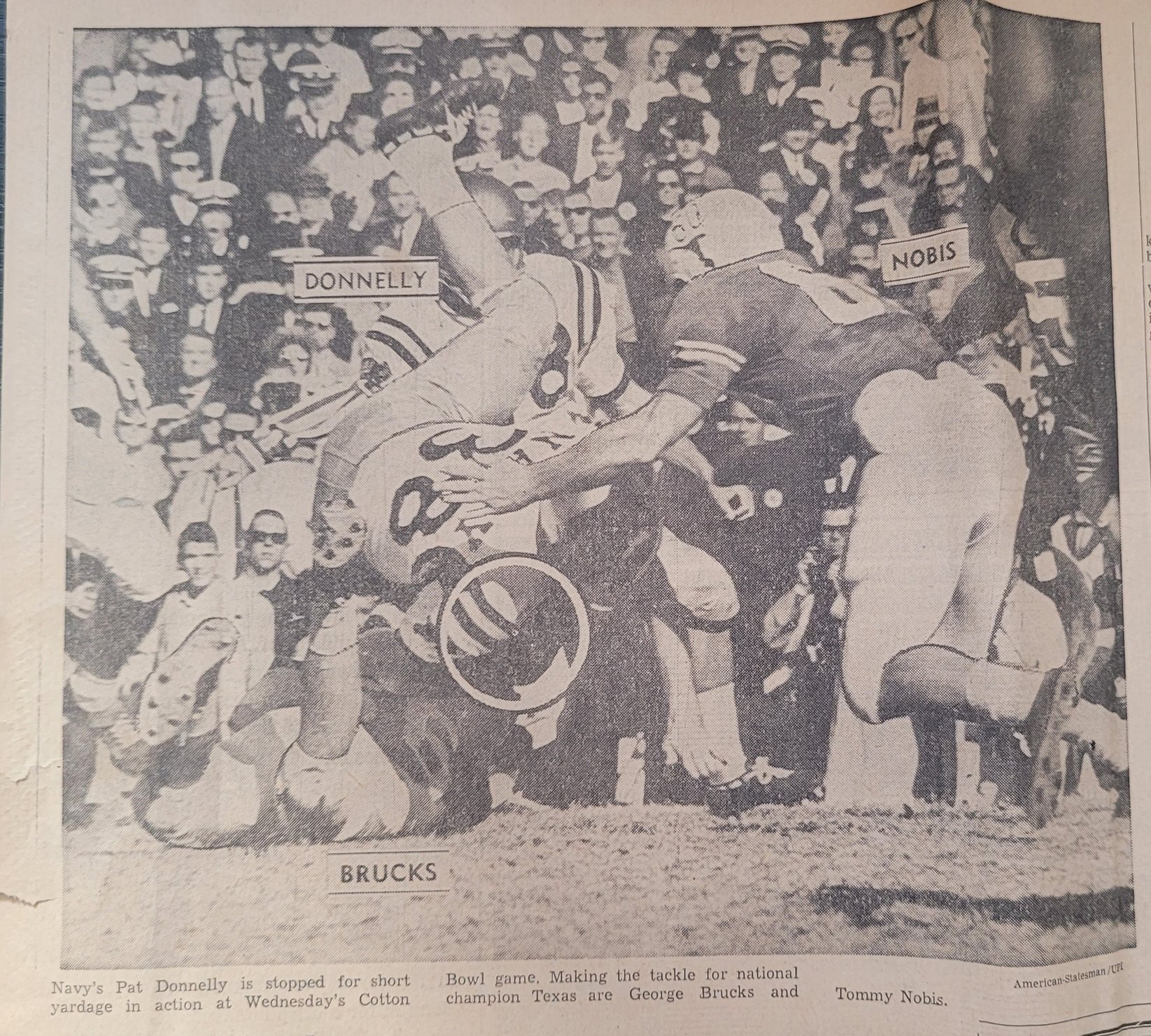
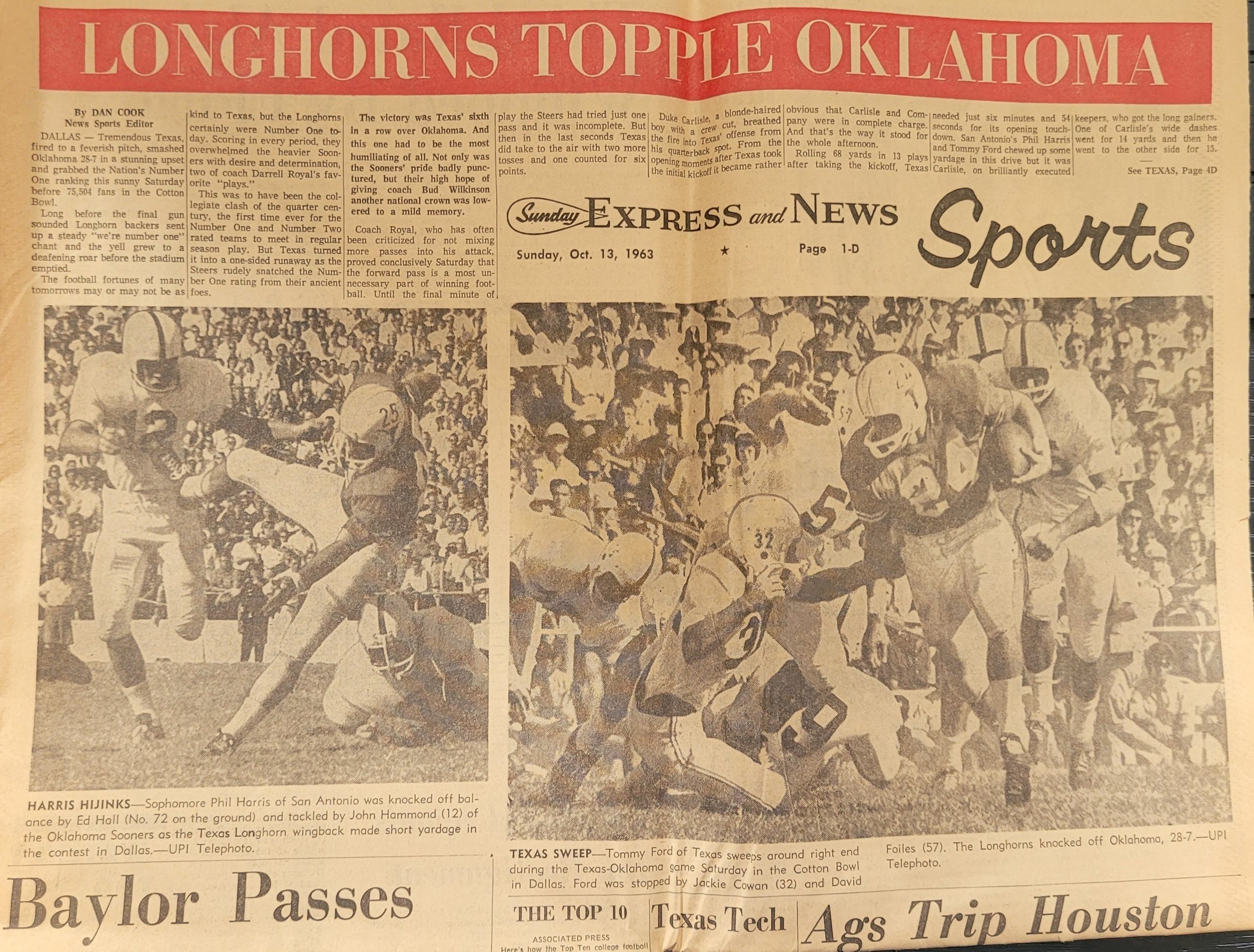
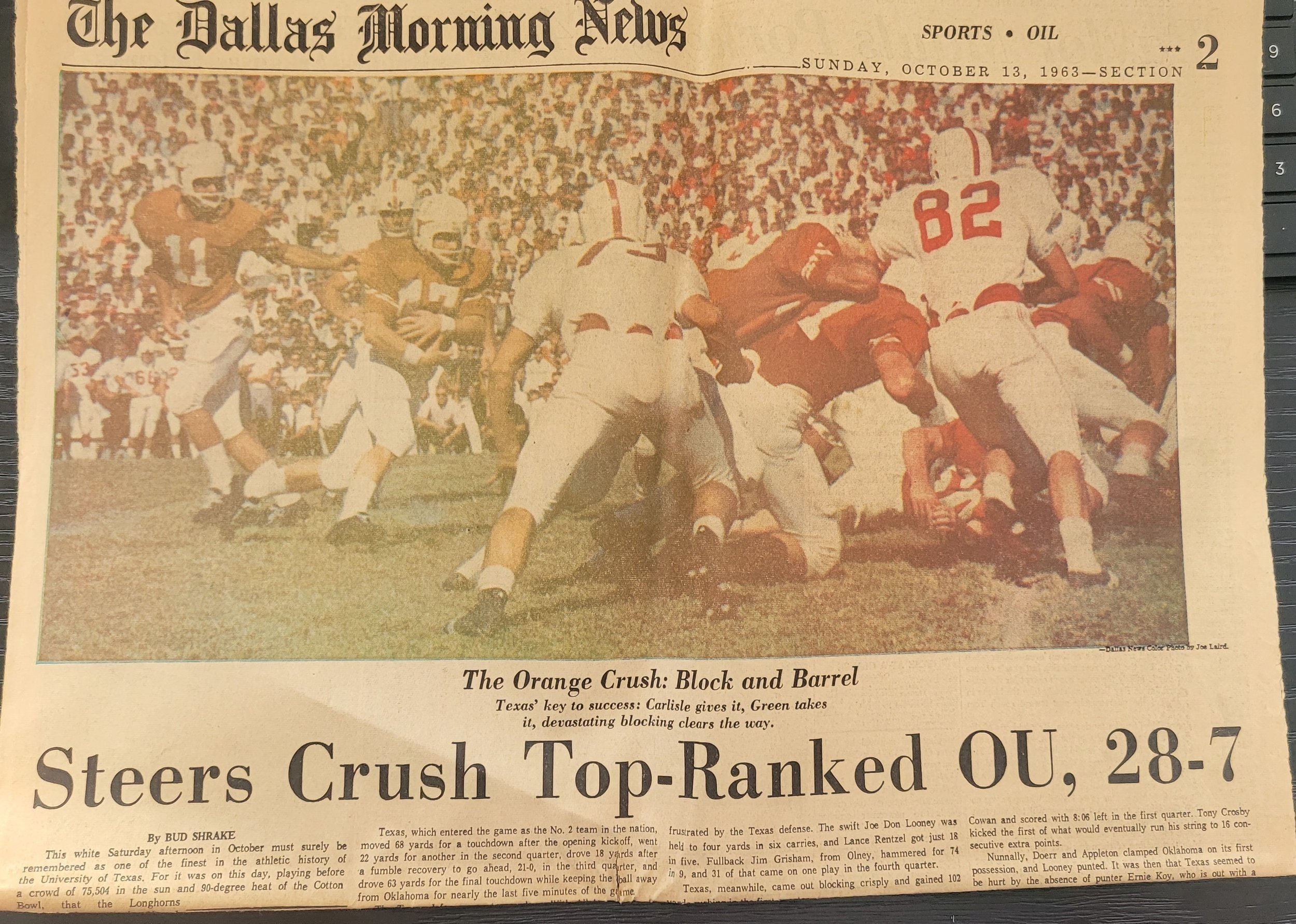
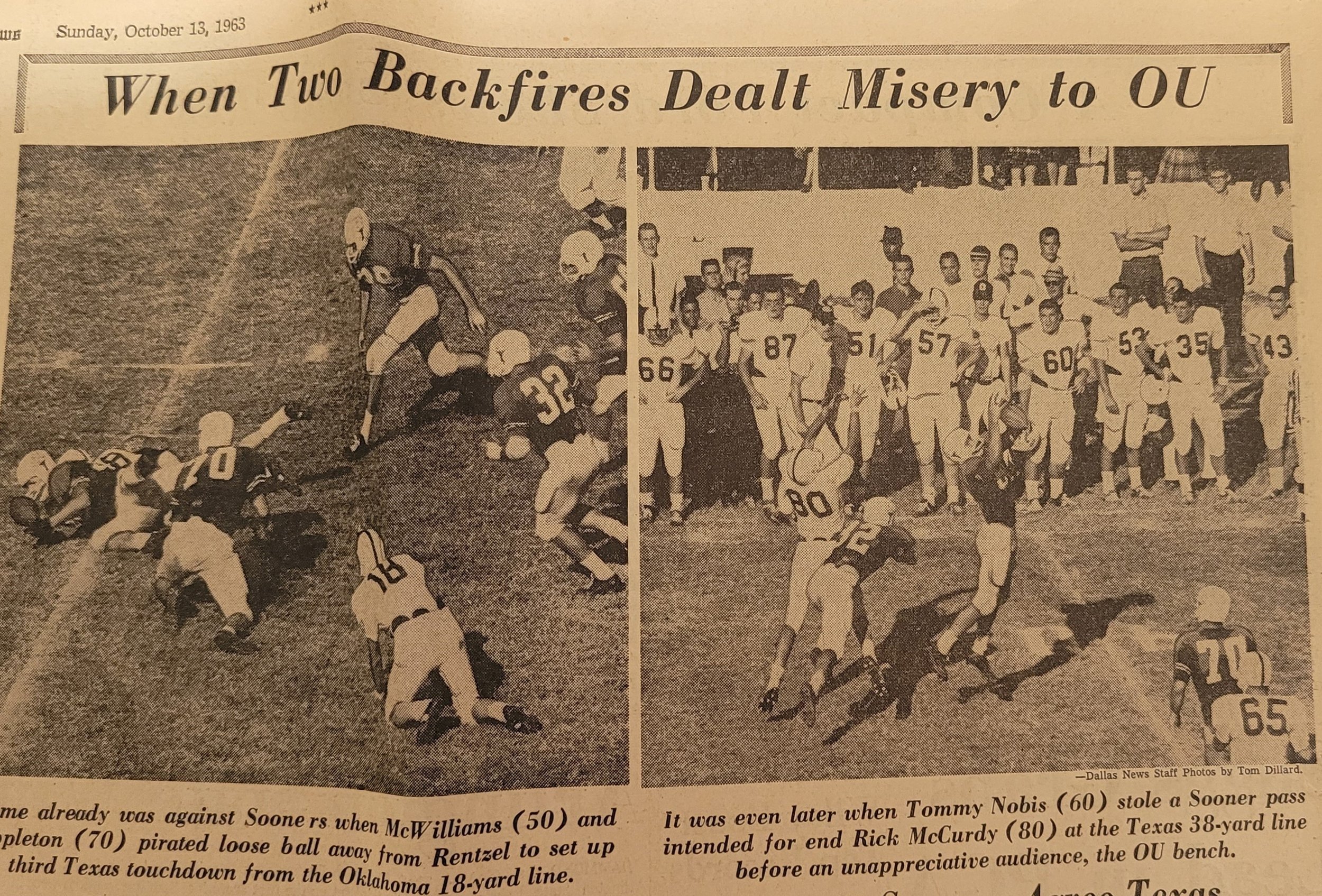
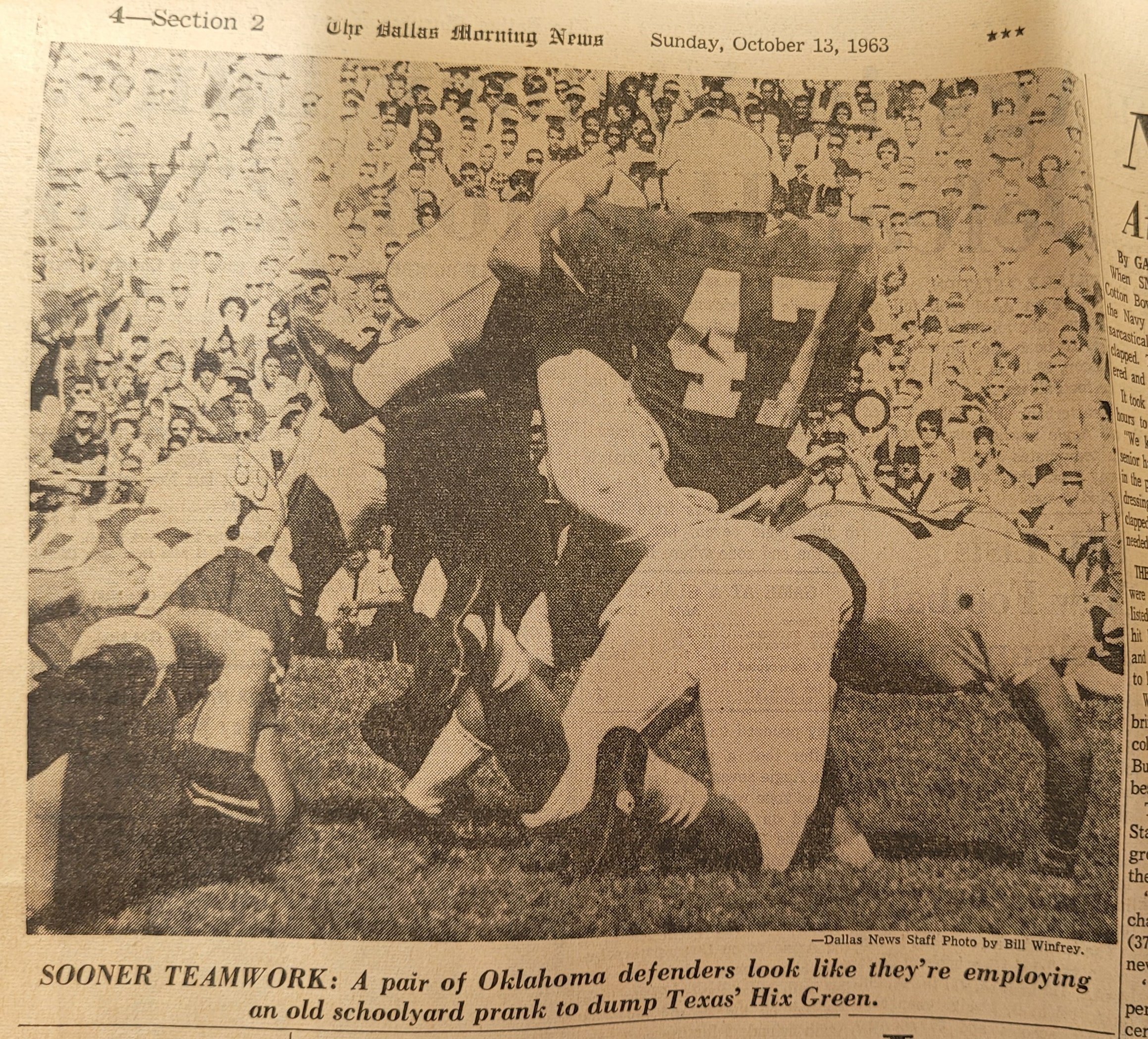
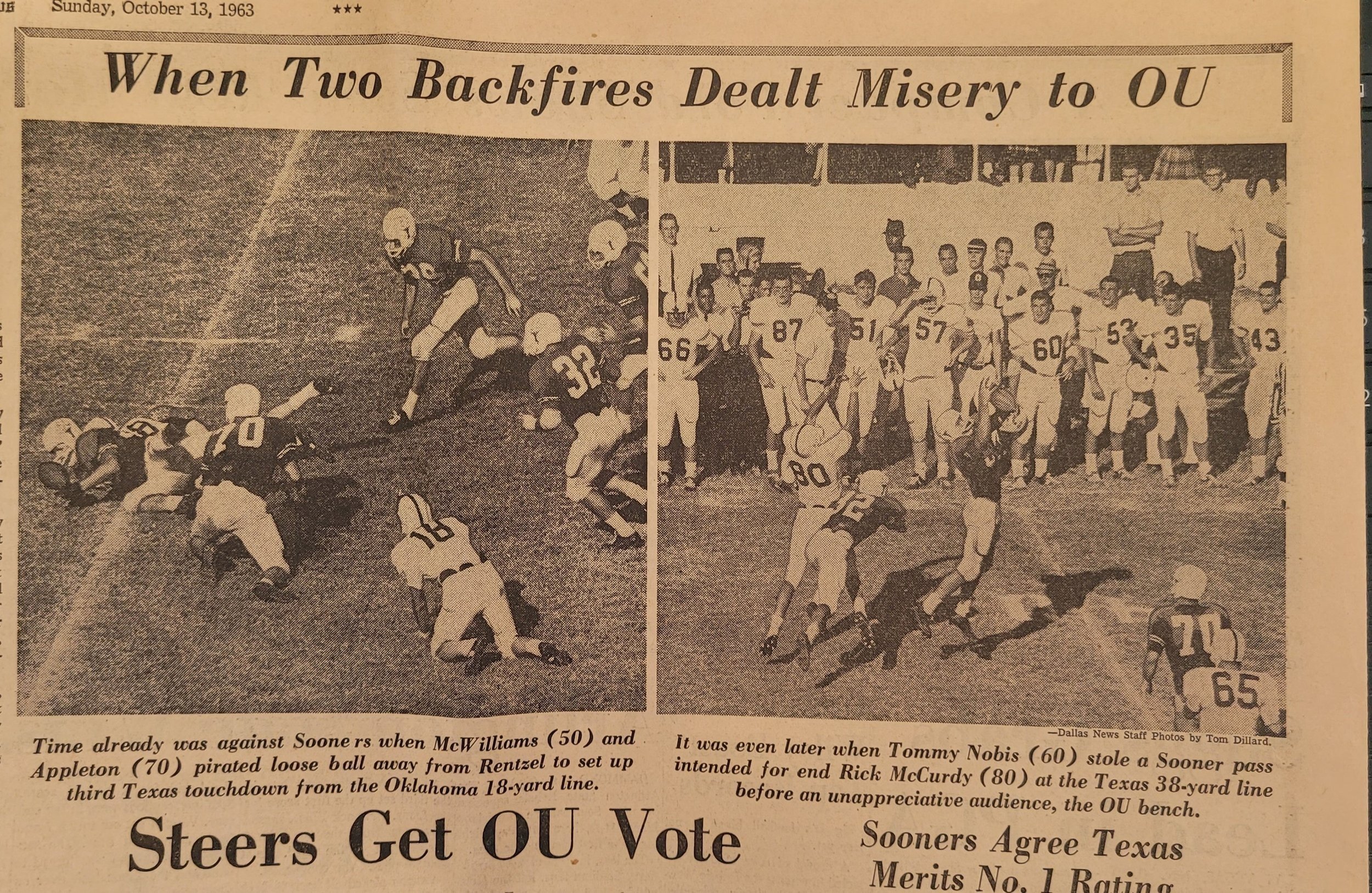
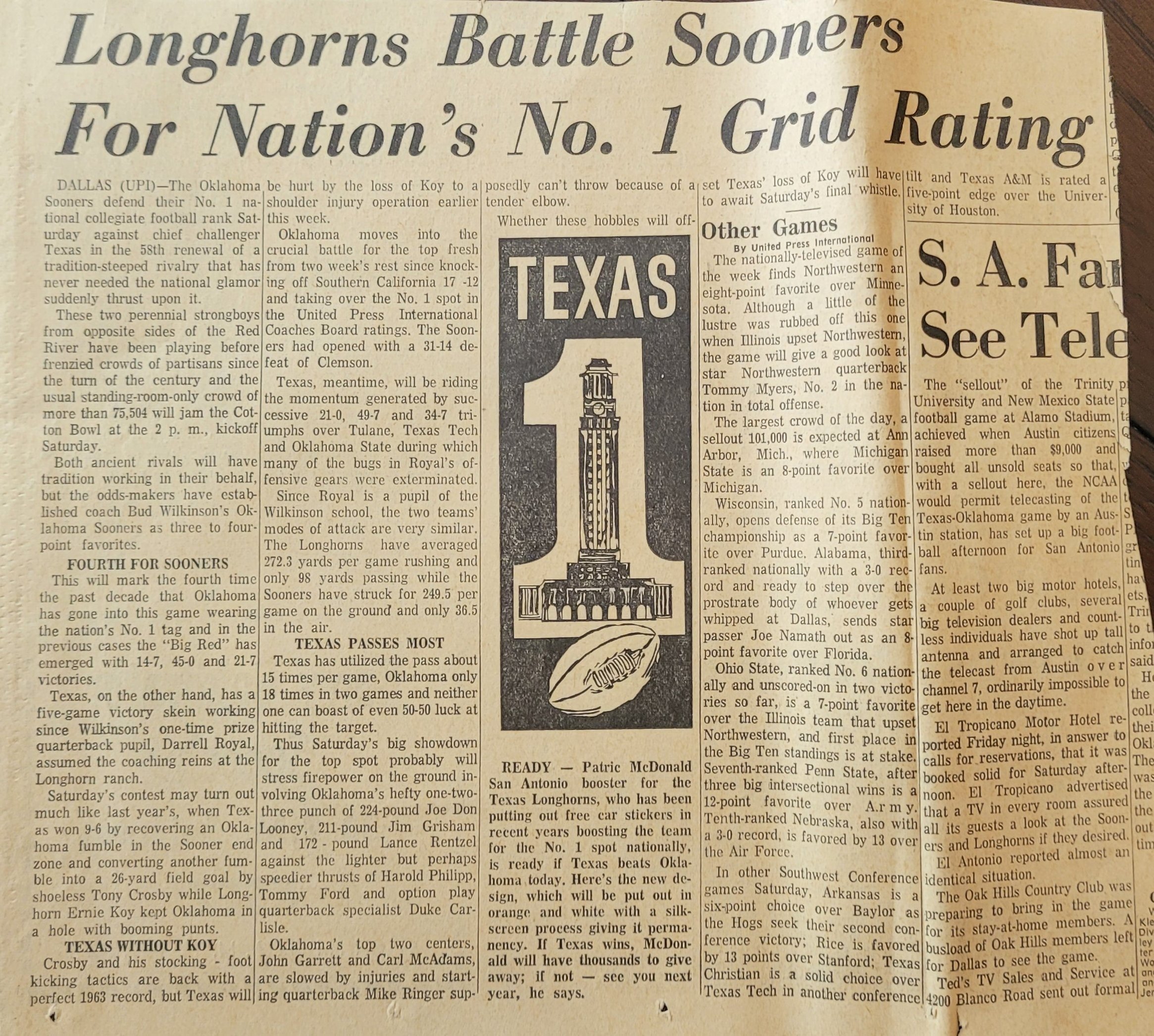
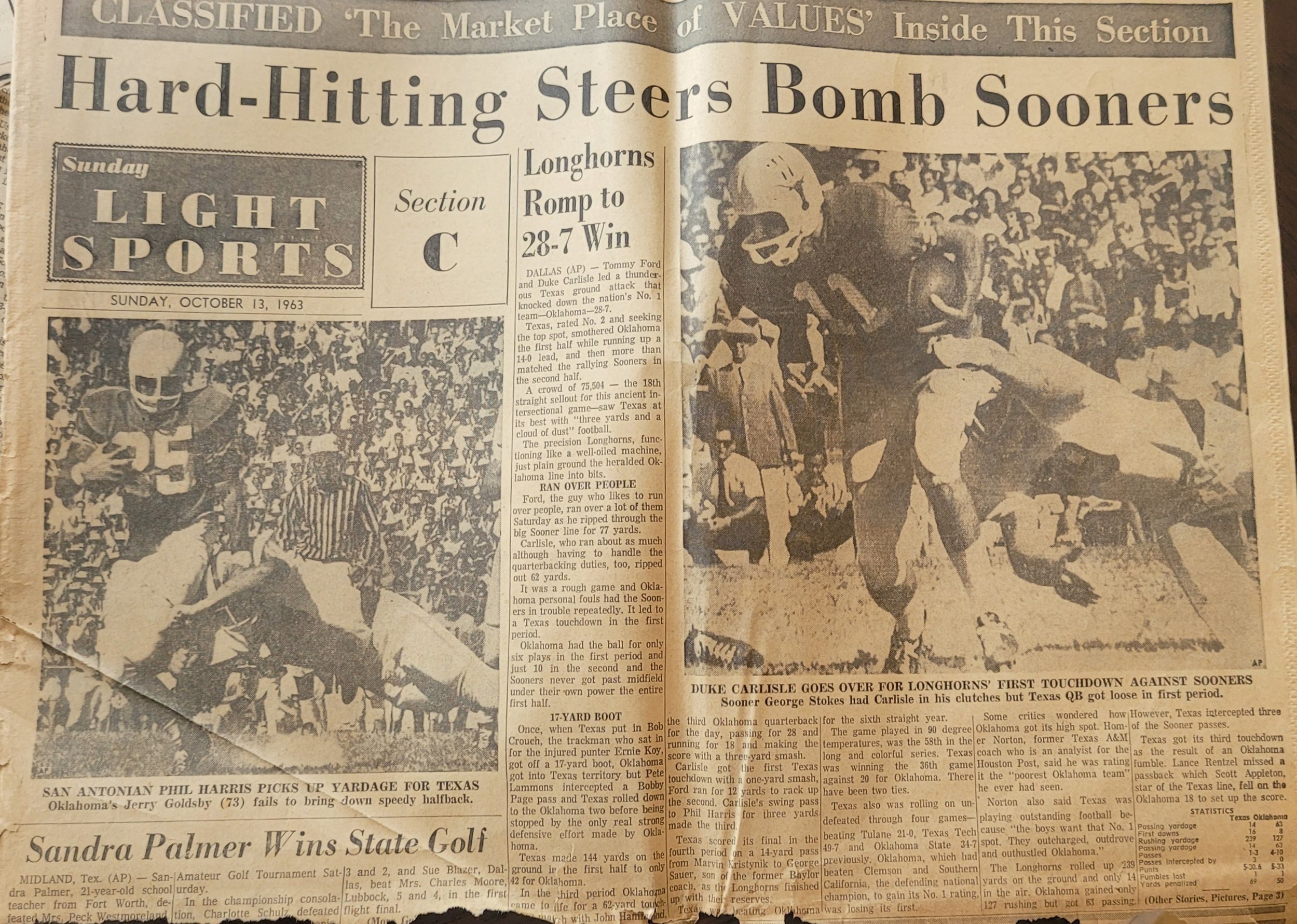
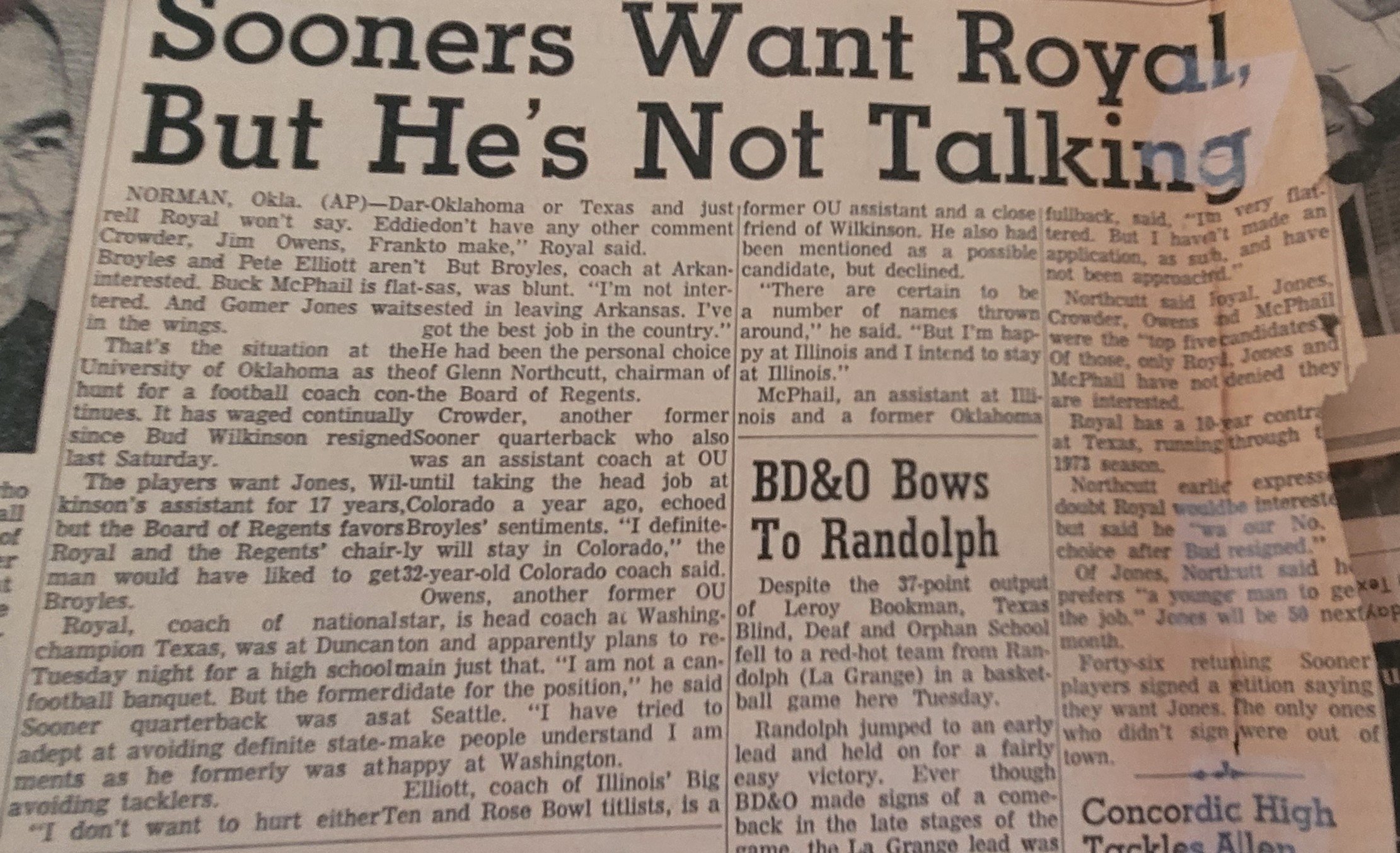
1964• No. Texas 28, Oklahoma 7
The Longhorns forced O.U. to a series-record 8 fumbles.
Tommy Nobis had 25 tackles for Texas in the OU game.
Oklahoma was a soft touch in the years (1964 and in 1965 ) when Gomer Jones was the head coach. Ellington scouted the Sooners for at least ten years, and he knew what to look for. We had their signals during the years Gomer was there, Longhorn Assistant Coach Coffee recalls. Bill Ellington had ‘em down Cold. Bobby Drake Keith gave their signs, and they were pretty simple.
1965• No. 1 Texas 19, Oklahoma 9
Texas led 13-0 in first downs at halftime.
Gary Shaw wrote fiction about Coach Darrell Royal, but his book Meat on the Hoof also shares a story about playing in the Texas-OU game.
Gary Shaw says Coach Royal stands up in the Cotton Bowl’s locker room and says, “alright, men”! I stand up with metal cleats and line up at the door that leads to the tunnel and then to the field. I start down the ramp and can fill the broken rhythm of 100 separate feet. The crowd hasn’t seen us yet. But within a moment, there is a rapid ricochet of cleats, slapped asses, and cracking voices. Let’s get those sons of a ******* horns! Let’s go! I feel like I’m assaulting the sidelines, not just heading towards them. I’m already punishing the grass below me, and the noise above me is hard -a rock band trapped and out of control. And when the Texas cannon explodes, the amps are turned loose.
Hit somebody! Hit Somebody! Those crazy Sooner players are halfway across the field waving their fists and shooting us the finger. T.V. cameras and 75,000 people, concrete, bands, fans, orange cheerleaders, red panties, referees, loud numbers, furious coaches, chalked grass, public speakers, and Royals mouth… Hit! as I lined up for the kickoff, I was ready.
1966• Oklahoma 18, Texas 9
By 1966, after losing to Royal`s Texas teams eight consecutive years, OU knew Royal had a lot more than that going for him. OU officials tried to lure him back to Norman to coach his alma mater and gladly would have given him a colossal contract. Royal quickly decided to stay at Texas. By then, he, Edith, and their three children had deep roots in Austin.
In its only season under coach Jim Mackenzie, who died in April 1967, O.U. snapped Texas’ eight-game win streak with four field goals by Mike Vachon of Amarillo and the passing of Bob Warmack, who ran for 69 yards and a T.D. and threw for 220 yards.
Chuck Fairbanks was promoted to head coach.
Due to injuries, Bill Bradley, the starting Longhorn quarterback, and eight other starters missed the O.U. game. Texas had four turnovers in the game inside its 30, which were converted into four field goals.
Andy White is the first quarterback in Longhorn football history to debut as the starter against the Oklahoma Sooners.
1967• Texas 9, Oklahoma 7
Chuck Fairbanks is the new O.U. Coach and the players enjoy playing for him. Fairbanks recruited more blacks, cared little about dress codes, and he allowed his players to have a good time. Like Switzer, winning was what it was all about.
With the Longhorns trailing 7-0 at the half, Royal told his team, “There’s a helluva fight going on out there. Why don’t you get in on it?” The media gave Royal credit for his inspirational speech. Still, Royal disagreed that he used magical words, saying, “I’ve said it many times, if I had the ability (for inspirational speeches), I wouldn’t be saving it till halftime. I’d have used it Friday when they were dead and listless.”
Joel Brame gets hurt, and Corby Robertson replaces him. On Corby’s 5th play in the game, he hits future Heisman trophy winner Steve Owens to save a touchdown. Thus, the start of a love affair between the coaching staff and Corby ends with Corby making the Football Writers Associations All American list.
Texas rallied in the second half behind quarterback “Super Bill” Bradley and O.U.s three turnovers. It was an ugly game with a beautiful ending for the Horns.
1968• Texas 26, Oklahoma 20
Texas is behind 20-19 with 2:37 left on the clock and Texas on offense. The goal of the offense was to get Happy Feller close enough to kick a field goal. Happy had already kicked 29, 40, and a 53-yard field goal. However, The Horns did not need Happy Feller’s field goal services as Worster provided the necessary yardage and a touchdown to win the game.
Royal said the Wainscott played a great defense highlighted by stripping the O.U. quarterback of the football to set up a 35-yard touchdown drive. Royal said, “Loyd was the bell cow of the whole shooting match. He played absolutely the most outstanding football game we’ve had a lineman play against Oklahoma.”
Emory Bellard creates a three-back formation dubbed by sportswriter Mickey Herskowitz as the wishbone-T.
Photo – Captains Gilbert, Bradley, and Robertson.
After a 1-1-1 start, Texas wins a seesaw battle with the Sooners, marching 85 yards in the final 2:37 and scoring on Worster’s seven-yard run with 39 seconds to play.
1969• No. 2 Texas 27, No. 8 Oklahoma 17
DKR says, “they were on us like white on rice, and that’s completely covered.”
Jack Mildren and Steve Owens led O.U. to a 14-0 lead, but Texas mixed the wishbone with James Street’s passing, who threw for 215 yards, including 160 yards on eight catches by Cotton Speyrer. Owens went on to win the Heisman Trophy, but Texas won the national championship.
1970• No. 2 Texas 41, Oklahoma 9
Fairbanks switched to the wishbone before the 1970 Texas game but foundered 41-9.
During OU’s off week, O.U. Coach Chuck Fairbanks accepted the suggestion of assistant coach Barry Switzer that the Sooners switch to the wishbone. Texas, however, had the better wishbone this day, rushing for 310 yards and setting a school record for points against O.U. en route to UPI’s version of the national title.
Julius Whittier is the first black scholarship athlete to make the varsity. 14 years after O.U. signed their first black recruit.
1971• No. 8 Oklahoma 48, No. 3 Texas 27
In 1971, however, the Sooners returned to Dallas with Jack Mildren quarterbacking a souped-up version of the wishbone, and Oklahoma won a 48-27 track meet. Royal had beaten Oklahoma for the last time.
Eddie Phillips is not able to play due to an injury. Donnie Wigginton had one of his best games as a Longhorn but had to leave the game in the 3rd quarter due to a torn rib cartilage.
With a year running the wishbone under their belts, the Sooners rolled up 435 rushing yards, the most allowed by a Royal-coached team at Texas. Greg Pruitt of Houston ran for 216 yards, and Mildren, from Abilene, ran for 111. It was only O.U.’s second win in the series since 1957.
O.U. received a “private reprimand over high school recruiting.
1972• No. 2 Oklahoma 27, No. 10 Texas 0
The only thing hotter than the temperature (estimated at 105 degrees at field level) was the O.U. defense, led by the Selmon brothers, and its intelligence-gathering apparatus. Texas suffered eight turnovers, and the game turned on a blocked quick kick that Lucious Selmon recovered for a T.D. O.U. assistant coach Larry Lacewell later acknowledged the Sooners picked up the quick kick formation after spying on Texas practices.
Sooner All-American Derland Moore fell on a Texas fumble in the end zone, blocked a punt that resulted in a touchdown, and was named National Lineman of the Week.
Because of recruiting violations, O.U. was forced to forfeit eight games including the Sugar Bowl.
1973• No. 6 Oklahoma 52, Texas 13
O.U. found a winning formula to victory but got caught altering the transcripts of two players from Galveston. O.U. was placed on NCAA probation for two seasons but managed to convert illegal recruiting and the hiring of a Texas Coach to decimate the Horns this year. It was the worse defeat since a 50-0 loss in 1908. O.U. remains the third worse violator of college recruiting rules, but the breaches did help O.U. build its program.
Here are the teams with the most infractions, according to the NCAA.
SMU, 10
Arizona State, 9
Oklahoma, 8
1974• No. 1 Oklahoma 16, No. 17 Texas 13
Texas is ranked #17 and was a 21-point underdog. The Horns had not scored a TD on the OU starters since 1971. O.U. linebacker Rod Shoate set a record that still stands against Texas with 21 tackles and recovered an Earl Campbell fumble that led to Tony DiRienzo’s game-winning 37-yard field goal with 5:25 to play. The game was not shown on TV because O.U. was on probation for recruiting violations. The irony is OU, a team that was punished economically for illegal recruiting, was still crowned national championship by the AP. The UPI coaches refused to crown OU national champions and instead crowned USC, a cleanly run organization, national champion.
1975• No. 2 Oklahoma 24, No. 5 Texas 17
O.U. was put on probation from 1973-75 for improper inducements as well as for a fraudulent transcript for Galveston, Texas, high school player Kerry Jackson.
Joe Washington was the key running back for O.U. but on this day Horace Ivory’s 33-yard T.D. run with 5:31 to go gave O.U. its fifth consecutive win over the Longhorns. The Sooners went on to win another national championship.
All-American Sooner Jim Elrod set a season record of 44 tackles for a loss. He is credited with hitting Earl Campbell so hard he fumbled that cost the Horns the game.
Against O.U., two Texas starters miss the game, and six others are injured during the game. David McLeod is lost for the season, and Gordon leaves with a scratched eyeball. In addition, Texas lost 4 of 5 fumbles against O.U.
In 1958 -Cheating Was Running Rampant, And The Media And Fans Celebrated The Cheaters. Don Faurot Tells The Saturday Evening Post, “The Nation’s Press Could Help By Ceasing To Glorify The Successful Lawbreakers. According To When Football Becomes War By Robert Heard, O.U. Is The Worst Violator. Don Faurot And Robert Heard Have Legitimate Points. As Of 2019, 7 Of The 13 Universities That Broke NCAA Rules Have Winning Programs. O.U. is one of them.
Coach Royal complains that O.U. coming off of probation was allowed to play with players who were the reason for the punishment. In addition, it did not sit well with Royal that O.U. had a “monster team” in 1975 recruited through illegal tactics.
TEXAS-OU Week Flashback: Big Defense in Big D, 1976-77
by Larry Carlson
LOVING COLLEGE FOOTBALL AS I DO, I wistfully look back almost every week to the lost art of defense. Like most of my heroes — George Washington, Davy Crockett and Elvis, to name a few — defense is gone but hardly forgotten. And when it’s Texas-OU week, my mind re-focuses on what I consider to be the Longhorns’ two greatest defensive games in this nasty street fight of a series.
The masterpieces came in back-to-back years, 1976 and 1977. In spite of largely the same cast of characters in uniform, the outcomes of the games and seasons bear no resemblance. But the Texas defense dominated both contests.
In October of forty-five years ago, a much-maligned Texas team limped into Dallas, having been shocked in their opener. Since Doug Flutie was only an eighth-grader, many Texas fans likely presumed that a small, private school with affiliations to the Catholic church but not named Notre Dame, would lead to a blowout win. But Marty Akins, after three seasons of guiding the wishbone offense, had graduated. In his place as the starter was a walk-on quarterback. Texas had star wishbone FB Earl Campbell, but the Tyler Rose was not in full bloom, nagged by hamstring injuries. The Horns barely beat puny North Texas, 17-14, before burning Rice en route to the State Fair matchup with the Sooners.
Darrell Royal, whose Texas squads had beaten his alma mater in 12 of 13 battles between 1958-1970, had hit a dry hole against the Sooners, losing five in a row. Royal was consumed with the notion — and new evidence that would later prove him right — that the Okies had been spying on UT practices in recent years. His accusations had gone public, as had his description — unintended for public consumption — of Barry Switzer and his staff as “sorry bastards.” Loud, cursing OU fans rained taunts and boos upon Royal in pre-game activities.
Iron Mike
Royal might not have had a veteran QB or a healthy Earl but he did have the Campbell who was still with him in his twentieth season at the Forty Acres. “Iron Mike” Campbell steadily fielded motivated units with talent and discipline. Oklahoma, ranked third, would be missing senior QB Dean Blevins but speedy sophomore Thomas Lott was a much bigger running threat. He would pilot OU the rest of the season, taking them to the Fiesta Bowl. His backfield included three runners who could break for TDs at any time — Horace Ivory, Elvis Peacock and Kenny King — and formed the most feared ground attack in America.
What happened that day is unimaginable in today’s wide-open college football. Texas and OU dueled in the proverbial phone booth (also gone from contemporary America) for 60 minutes. The Longhorns got a Russell Erxleben field goal to end the first half and added another to start the final period. Coach Campbell’s Texas defense was absolutely impenetrable. For almost 55 minutes, OU was stunned and stopped on every play. Longhorn senior Lionell Johnson had a ridiculous 23 tackles. And he got plenty of help from everyone in white, including Bill Hamilton, Brad Shearer and freshman Lance Taylor who had five solo stops in his first Red River Bloodfest.
One more UT first down would likely ice the game. But a Texas running back fumbled at the Horns’ 37 yard-line on third and short. At this point, the Okies had charted just two first downs. Let that stat settle in. Two first downs.
But OU rallied now somewhat against the exhausted Horns defense. In ten more gut-wrenching plays, the Sooners inched their way to three first downs, then a touchdown.
“We felt like we controlled the game,” Taylor told me this week from Tulsa, of all places, where he is in the software business and heads the local Texas Exes chapter. “Then one mistake and it’s tied. I think everyone was in shock.”
Oklahoma kicker Uwe von Schamann trotted on the field confidently. He had hit 140 straight PATs. But his long snapper had seemed shaky that day. Lionell Johnson, the Louisiana senior having his finest day as a Longhorn, reportedly leaned in close to the snapper for a few cautionary words of prophesy. Taylor told me that teammate Dwight Jefferson later said that Johnson did, indeed, tell the center he would snap the ball over his holder’s head. Was Taylor sure that it wasn’t an apocryphal story? I had to know. Dutifully, Lance tried to contact Dwight, now known as the Honorable Dwight E Jefferson. But the Judge, now retired, was out. So Lance called Morgan Copeland, Longhorn linebacker-turned-lawyer. And Copeland confirmed. Yes, Lionell Johnson uttered the magic, hexing words.
So now you know, as Paul Harvey would say, the rest of the story. The snap sailed over holder Bud Hebert’s head. He scrambled after the ball and heaved a desperation pass that was picked off by UT’s Steve Collier. You couldn’t return errant PAT attempts in ancient times, so the whistle blew. What had reliably looked like a Texas win, then suddenly a certain OU victory, was stuck at 6-6.
Texas only moved the needle just a bit and got a roughing penalty when Erxleben punted. But nothing much worked and UT lost nine yards on a sack right when it appeared Texas might get manage a long-range attempt for Erxleben. The official game clock was malfunctioning and Royal did not want to lose now on a fluke fourth down gone wrong. From the Texas 47, Royal chose to punt. The Sooners weren’t taking any chances, either. Erxleben blasted one sky high into the end zone and the gun sounded on the dissatisfying tie. Nobody was celebrating. Ted Constanzo, UT’s backup quarterback that day, told me several years ago that it was the strangest scene he witnessed in football. “When that punt landed and the game was over, it just went quiet,” Constanzo said of the previously quaking Cotton Bowl, shaking his head. “It was eerie.”
Like the two teams of weary warriors, seventy-five thousand very avid, vocal fans were spent. Some slumped in disbelief for a few moments. Others shuffled away into the jarring disconnect of the midway’s whir of whimsy and fried delights.
Darrell Royal’s reaction expressed what most witnesses on both sides likely felt. He bent over and dry heaved on his way to the locker room and the post-game post-mortem with reporters. He would later recall this: “I never felt as sick about a game as I did that one. I wanted that game more than any I competed in or coached in.”
Two months later, he would retire at 52. Mike Campbell, recommended by DKR to succeed him, was passed over by the UT Board of Regents for young Fred Akers, Campbell, the best assistant coach ever at Texas, would turn in his keys the day he got the news, finished with coaching.
TEN LONG MONTHS LATER, Akers and a revitalized band of Longhorns were college football’s most pleasant surprise. The Horns had avenged Boston College, 44-0, annihilated Virginia, 68-0 and threshed Rice, 72-15. Yes, Oklahoma was ranked second in the country but UT had soared from unranked in the preseason to number five in early October.
The 1977 Texas-OU showcase turned out to be another defensive brawl. Covering the series for the first time, I was astonished by the almost unimaginable ferocity of the hitting. I recall the noise of the collisions when two dozen or so Sooners would wrestle Earl Campbell down near the Texas sidelines. The cacophony of pounding shoulder pads and helmets really did seem to drown out the crowd noise. Even the Sooners’ infamous trash-talking soon began to ebb after tackles. Nobody wanted to be caught counting their change while multiple bodies were flying at full speed. It was hard for me to believe that people were getting up from those smoking demolition derby crashes on every play.
It didn’t take long before not all the combatants were able to rise. Texas QB Mark McBath went down in the first quarter with a season-ending broken ankle. Then his replacement, Jon Aune, a strong-armed soph with great potential, was shelved by torn knee ligaments, an injury so severe that it effectively ended Aune’s career.
The offensive story would be authored by Cinderella’s male counterpart, Randy McEachern. He would answer the call that afternoon and then steer the Horns to a magical season, enabled greatly by an uber-successful Heisman campaign from the peerless, and now sleeked-down Campbell, even more dangerous at 225 pounds than at 248..
But as it had been in ’76, this October day was owned by the defense. And by the excellence of All-America punter/placekicker Russell Erxleben. The junior from Seguin had scored all of UT’s points the previous year and kept OU at bay with nine punts for a 49-yard average.
Now, a year later, thanks to Erxleben’s 64-yard missile of a field goal and a TD run by Earl, Texas led 10-3 at intermission. Oklahoma added a field goal in the third quarter. But with eight minutes left to play, Erxleben answered with a 58-yard FG and Texas was up by seven again, 13-6. Too much time, though.
Now OU made its strongest, longest push, eating clock and driving from their 20 to the UT 14-yard line.
Three plays scraped out nine more yards to the five. Fourth and one.
Middle linebacker Lance Taylor looked back this week to that moment, and reminded me that the ’77 “D” utilized multiple fronts under coordinator Leon Fuller. The call this time was for the Flex.
“The weakest point for that defense is option to the weakside,” Taylor explained. “So I’m thinking that if (QB Thomas) Lott goes weakside I have to fly outside and make sure he doesn’t beat me outside.”
Sure enough, Lott started to his left. Taylor followed the plan to fly outside, “but as I got there, he planted.” and cut back inside. “I looked back and there’s Johnnie Johnson and Brad Shearer, meeting him in the hole.”
Johnson, headed for All-America honors at safety, hit Lott high while Shearer, soon to claim the Outland Trophy as the nation’s premier lineman, hit him low. No gain. Texas ball. “Johnnie always gives me credit for turning him back in,” Taylor said, “but I was sure glad they were there.”
Now, could the Horns, on the brink of their first series win in seven years, run the clock out? Nope. One yard in three tries. The Horns had made the last of their nine first downs.
Erxleben had to back himself deep in the end zone to punt with a few minutes still on the clock. He coolly bombed OU with a 69-yard punt. It was returned nine yards, and the burnt orange defense — Shearer, Taylor, Johnson, Copeland, Churchman, McMichael and company — continued its blue-ribbon day, shutting down four more plays. Texas ran out the clock on a 13-6 knockout. For the Longhorns and their legions of fans at the Cotton Bowl and at their TV’s, it was bliss.
1976• No. 3 Oklahoma 6, No. 16 Texas 6
What started in the early years of the O.U. conflict that was intense but respectable, had disintegrated into a sordid affair- personal, ugly, and hate-filled. Earl was hurt and Lam Jones and Johnnie Johnson were hurt.
1976- Al Eschbach, columnist for the Oklahoma Journal, accused Texas of being just as guilty as the Sooners of players scalping tickets. O.U. assisted the players financially by distributing 1 155 tickets to the players for the OU-Texas game. Royal did his research and stated the Texas players had either received or paid for a standard allotment of 365 tickets. The matter was dropped after this revelation.
Russell Erxleben gave Texas a 6-0 lead on 37 and 41 yards on field goals, and the Longhorns’ defense throttled the Sooners until Ivey Suber’s fumble at the Texas 37 with 5:31 left led to O.U.’s only T.D., a one-yard run by Ivory with 1:38 to play. However, O.U. missed the PAT after a bad snap, and the game ended in a tie.
Royal, embittered by O.U.’s acknowledged spy tactics and a bitterly fought defensive battle, was photographed dry-heaving in the tunnel leading to the Cotton Bowl dressing rooms. He retired after the season with a 12-7-1 record against the Sooners.
Royal remains the winningest coach in the history of this series. He is the only coach on either side to win at least 10 coveted “Golden Hat” trophies, and he is the only coach to win eight in a row. All told, Royal took part in 24 Texas-OU games.
1976 TX-OU: A bitter, mean end of an era – Barking Carnival
1977• No. 5 Texas 13, No. 2 Oklahoma 6
Texas beats O.U. for the first time in 5 years, and Randy McEachern lives the dream he shared with his mother and father at the start of the 1977 season.
Randy McEachern’s Dream
Randy McEachern’s Dream
During the previous six years, Texas’s record against O.U. was 0-5-1. However, in 1977 Texas finally beats the Sooners.
In the book Oklahoma vs. Texas, the author Robert Heard chronicled the O.U. and Texas game in 1977. History will show that Randy McEachern was 4th team quarterback, not 3rd team quarterback when he helped pull off one of the most significant momentum-changing games in U.T. football. However, before the season quarterback, Ted Constanzo underwent knee surgery for a racquetball injury, so Akers decided to move Randy from defense to 3rd team quarterback.
“A month before the O.U. game, Randy told his parents about “his crazy dream.” Randy says, “I dreamt the quarterback got hurt, and we were behind, and I went in and won the game.” Robert Heard continues his story. He says that Randy’s parents were listening to the O.U. game, and when McBath went down, his mother and father looked at each other. “When Aune went down,” Randy’s father got a sheet of paper and wrote in big letters, “Randy’s dream.” When the Horns won the game, Randy’s father took that piece of paper and completed the sentence, “Randy’s dream comes true.”
Texas lost two quarterbacks, Mark McBath and Jon Aune, who left the O.U. game in the first quarter with injuries. Third-team quarterback Randy McEachern replaced them. Randy made no critical errors in the game, leaning on Erxleben’s kicked field goals of 64 and 58 yards, Steve “Two-play” Hall’s blocking, and Campbell’s 124 yards running to win the game.
Taylor remembers a jubilant charter flight back to Austin that night, and he and his teammates were amazed to find hordes of Texas fans at the airport, clamoring for their Longhorns. “One of the reasons I went to Texas was for the OU game,” said Taylor, an El Paso Coronado blue-chipper. “Morgan Copeland and Bill Hamilton said the first time you walk out of that tunnel, you’ll feel like you’re floating on air.”
Soon, it would be time to remember the lyrics from West Texas troubadour Joe Ely, who famously sang, “Have you ever seen Dallas from a DC-9 at night….well, Dallas is a jewel, Dallas gives a beautiful light…”
Lance, who would become only the second UT linebacker to make first team All-Conference as a soph (Tommy Nobis came first and only Derrick Johnson, in ’02, has duplicated Taylor’s feat) was later hit by injuries, first to a shoulder, then to a knee. But he vividly recalls fans cheering wildly and beating on the team buses as they left the airport. “The bus took us to The Drag on the way to the stadium…the sidewalks were packed with fans and cars were everywhere, honking and cheering,” Taylor summed up the fond memory this way: “You would’ve thought we were conquering heroes coming back from overseas.”
For Texas fans, a seven-year war to beat its most hated rival had ended in victory. And UT’s big “D” was back from Big D. The next week, they would journey to Fayetteville and again not surrender a touchdown to another top ten team. But that magical ’77 season, in full, is another story for another day.
Steve Hall immortalized himself to the Texas Longhorn faithful in his fourth game as a freshman backup tight end in 1977. In the open field, Hall delivered a smash-mouth block on OU defensive back Terry Peters, enabling Earl Campbell to circle left into the end zone for a touchdown. It was the only one in the game. Texas won, 13-6, breaking an O-5-1 drought at the State Fair. And Hall, who enjoyed a solid career and would even snare a TD pass in another Texas win over OU two years later, would become part of Longhorn lore. The drawling, 6-3 215-pounder hailed from the Tulsa suburb of Broken Arrow, OK, and became only UT’s second letterman from Oklahoma since World War II.
1978• No. 1 Oklahoma 31, No. 6 Texas 10
Sooner Daryl Hunt against Texas had 18 tackles, one interception, and one sack in one game against the Horns. He set the Sooner career record with 506 tackles. Sooner Reggie Kinlaw
Billy Sims of Hooks had 131 rushing yards for the Sooners en route to the 1978 Heisman Trophy.
Sooner Reggie Kinlaw caused a Longhorn fumble, and had 10 unassisted tackles and 5 assisted tackles in the Oklahoma win.
OKLAHOMA FOOTBALL: A POWERHOUSE THAT BARRY BUILT
College coach Barry Switzer is king in Oklahoma. Here’s a disturbing glimpse at how he has kept his team number one
DECEMBER 51978 PHILIP TAUBMAN
Oklahoma’s varsity program is grossly out of control. It’s a story of football madness. The coach and team are running away with the university.
OU’s winning tradition has always had certain trademarks. Powerful running. A tough defense. Consistent kicking. And the coaching staff cheats.
The Bud Wilkinson Complex is a great help in signing high school players. Oklahoma isn’t selling education. It’s selling football, pure and simple.
Whether winning or sinning, Barry Switzer is the talk and toast of Oklahoma. The coach’s reputation as a ladies’ man fuels all kinds of rumors.
College coach Barry Switzer is king in Oklahoma. Here’s a disturbing glimpse at how he has kept his team number one
Philip Taubman
Rodgers and Hammerstein never envisaged an Oklahoma like this. Down I-35 we come, barreling south from Oklahoma City like a runaway express train. A state police car leads the way, lights flashing and siren wailing. I’m tucked in behind the car in a Hertz Oldsmobile, followed closely by two silver-and-white buses rolling along at seventy miles per hour. It looks like the President of the United States is on the move. Actually, it is the University of Oklahoma football team. After spending Friday night in a hotel away from the distractions of the campus, in Norman, Oklahoma, the team is heading home to play Kansas State.
The highway ahead narrows to two lanes, both jammed with game traffic. There appears to be no way through the congestion. The state trooper doesn’t agree: In a maneuver that would cost anyone else his license, the lawman brakes momentarily, then cuts between the lanes of traffic. Startled drivers on either side veer to the shoulder as our caravan wedges past. It is like the Red Sea parting for Moses. Just at this moment, the trunk of my car pops open. My view to the rear is blocked, and the clothes and papers I tossed in the trunk are surely flying all over the road. A hell of a way to drive in a motorcade. I wave plaintively to the trooper. He takes one look at my problem and signals back a message that roughly translates, “You must be crazy, buddy, if you think the Oklahoma football team is stopping so you can rescue your laundry.”
After a week in Oklahoma, I should have known better than to ask. The University of Oklahoma (OU) Sooners do not yield to anyone. It is no accident that they travel to games like royalty— in Oklahoma, they are. The state is infatuated with football, and Oklahomans spare nothing for their team. They want glory and will pay any price. They lavish the Sooners with attention, money, and facilities that would make a pro team weep with envy. They brook no criticism and treat anyone who questions the OU football program as a traitor. Most of all, the folks of Oklahoma revel in the success of the Sooners. The team puts the state on the map every autumn. It generates pride and helps people forget the dust bowl and its legacy of inferior Okies. When the Sooners are winning, everything is okay in Oklahoma.
One result of this intense devotion is the winningest record in contemporary college football. Under Bud Wilkinson in the Fifties, Oklahoma won forty-seven consecutive games and three national championships. After sputtering through the Sixties with more mortal seasons, the Sooners have jumped back to the top in the Seventies. Since 1971, Oklahoma has won eighty-one,
Philip Taubman is a roving editor of Esquire magazine.
lost seven, and tied two, winning national championships back to back in 1974 and 1975. This year, they were undefeated, still number one going into the final games of the season, another national title within reach.
The other result of Oklahoma’s football fever is a college football program grossly out of control, a team and a head coach running away with a university. It is football madness, with a vengeance. OU is where the university president once said, “We want to build a university the football team can be proud of.” And he wasn’t kidding. Today, Oklahoma is the quintessential example of an academic institution warped by an athletic team. It is the story of how a football program, when unchecked, can grow into a corrupt and corrupting empire. But it is mainly the story of a head football coach—Barry Switzer—who has become a king, not only of his campus but of his state, overshadowing everyone from the university president to the governor. This season, King Switzer’s court has rivaled that of Louis XIV of France: Rabelaisian tales of cuckolds and scandals on the OU coaching staff and board of regents abound, stories that have left Oklahomans breathless to hear the latest rumor about infidelity.
Sometimes it is hard to know whether to cry or laugh about the football fanaticism of Oklahoma, it is so outrageous. One sad fact is certain, though: Oklahoma is not alone. It may do things on a bigger scale than most, but Oklahoma is part of a breed. At places like Ohio State, Alabama, Texas, Notre Dame, USC, Michigan, and Oklahoma, they’ve all forgotten football is just a game. It has become a big business, completely disconnected from the fundamental purposes of academic institutions. The goal of college ball is no longer for young men to test and strengthen their bodies, to learn about teamwork, and to have a good time. All that matters is winning, moving up in the national rankings, and grabbing a bigger share of the TV dollar that comes with appearances on NCAA’s game of the week on ABC. To achieve these aims, schools and coaches not only bend and break the National Collegiate Athletics Association (NCAA) rules governing college football but, far more destructively, violate the intellectual integrity and principles of the American university system. What I saw in a week at Oklahoma was a reflection of excesses and abuses at other schools. It was a disturbing, often frightening glimpse of what it takes to be number one in the nation.
THE PLANT
“Hey, man, you got no hassles with regular students. ”
A visitor can tell what the priorities are at Oklahoma U even before stepping onto campus. As you approach the town of
Oklahoma’s varsity program is grossly out of control. It’s a story of football madness. The coach and team are running away with the university.
Norman, one building stands tall and clear above the rest— Oklahoma Memorial Stadium. It is located in the middle of campus and features a new upper level and press box that alone cost $9 million. The sumptuous press box, with its five levels and comfortable furnishings, is more like something you’d expect to find at the plush Superdome in New Orleans.
Across the street from the stadium is a complex of four redbrick buildings. Officially, it is called The Bud Wilkinson Complex. Around Norman, it is better known as the Sooner Hilton. Better accommodations Conrad Hilton himself could not provide. Three of the buildings are dorms—for athletes only— housing a total of 217 Oklahoma varsity players. Football ranks even here, however, and the nucleus of Coach Switzer’s team Stays in the newest of the three buildings, a $ 1.5-million luxury residence that is the galleria of student dorms in America. While normal Oklahoma students are accommodated two to a room, with a communal bath down the hall, the football heroes of the new athletic dorm are assigned two per suite. Each suite contains a bedroom, living room, and private bath. For entertainment, residents have a choice of eight pool tables in a large, carpeted poolroom on the first floor or a TV room with a six-foot screen and theater seats.
The fourth building in the Wilkinson Complex is the dining hall. Anyone who has ever eaten a dormitory meal would instantly appreciate the miracle of this place. The food is excellent and plentiful. Athletes walk away from the buffet area with plates piled high with steaks or prime ribs. The reason is quintessential
Oklahoma: the Sooner Beef Club. The beef club consists of over 200 individuals and businesses who support football by donating one steer annually to the athletic dining kitchen.
The dining hall, not surprisingly, is off limits to everyone but Oklahoma athletes. Other students are not welcome. Nor professors. Parents are welcome only on game days. Add to that the location of the complex—far from other student housing in Norman—and the result can be four years of segregated living and eating by Oklahoma athletes. Elvis Peacock, a star running back for the Sooners who now plays for the L.A. Rams, told me that the separate but unequal isolation was something he and his fellow players liked: “You don’t have to mess around with other students. You get no hassles.”
If spending four years closeted with fellow athletes is a definition of a college education, it’s news to me. I thought the whole idea of a university was exposure to different kinds of people and ideas. But Oklahoma isn’t selling education to high school football prospects—it’s selling football, pure and simple. By these standards, the Wilkinson Complex is a great help in signing up the best players. As Coach Switzer says, “I believe in first-class facilities for my players. I think they should be able to live together, play together, win together, and lose together.”
The extravagance of the football plant understandably irritates Oklahoma faculty members: OU is by no means a wealthy institution. The state of Oklahoma places thirtieth in its support of higher education, and the university has to share that meager funding with twenty-six other colleges and universities in Oklahoma, a glut of campuses only the state’s politicians try to justify. As a result, OU has spartan academic facilities and a large out-ofstate student body; its library is hurting; and faculty salaries are the lowest in the Big Eight. The football program is entirely selfsupporting—ticket revenue and donations exceed expenses by a wide margin—but that doesn’t make faculty members any happier. “It’s nice to have a football team,” fumes assistant political science professor Jean McDonald. “But this is, after all, supposed to be a university. Our priorities are skewed. Football fever here has gotten to the point of obscenity.”
Another way to put that is to count the number of books in a football player’s suite. I could find only fourteen books, most on business management, in one suite. This was the total library for two guys who have been enrolled for two years each.
THE SHARKS
“Probation is a way of life at Oklahoma.”
The winning football tradition at Oklahoma has always had certain trademarks. A powerful running attack, for one. Oklahoma has produced star backs like Greg Pruitt, Steve Owens, Joe Washington, Horace Ivory, Elvis Peacock, and, this year, Billy Sims. The Sooners also play tough defense year after year. They always have great depth. Two, sometimes three top players for every position. The kicking game is generally consistent. Plus Oklahoma does one other thing well—it cheats.
The NCAA has put Oklahoma on probation three times since 1955, one of the worst records among major universities in the nation. In 1955-57, it was for making improper inducements to high school prospects. In 1960-61, for an athletic slush fund maintained several years earlier. In 1973-75, for improper inducements again as well as for a fraudulent transcript for Galveston, Texas, high school player Kerry Jackson. Two years ago, the NCAA conducted still another investigation, this time looking into ticket scalping by OU players. No public action was taken, but OU was told to stop letting players sell their season tickets at huge premiums to OU rooters. Even so, it is hard to spend any time at OU without hearing stories about continued scalping and huge profits raked in by coaches selling off large blocks of OUTexas tickets. Priced at $10, those seats sell for as much as $300 on the black market. The revenue is supposedly plowed into illicit payments to players for such items as cars and clothes.
Oklahoma has not been content with just recruiting violations. Several years ago, OU was caught spying on the opposition.
Though technically not a violation of NCAA rules, the spying was unethical as hell. And comically clumsy. Before an OU game against California, four Sooners rooters drove down to Dallas to sneak in on a Cal practice at Texas Stadium. Questioned at the gate, they claimed to be interior decorators working on the Lincoln-Mercury Dealers’ Association box in the stadium. I met two of the spies when I was in Oklahoma, and less likely interior decorators it’s hard to imagine. They’re both heavy, roughlooking jocks. Officials let them in, but one stupidly signed his name in the security log. When rumors started spreading, newspapermen had no trouble unraveling the case.
Other espionage schemes were tried. One spy infiltrated a Nebraska practice by posing as a painter. Another planned a more complicated alibi. He took a girl friend to the stadium with him and if caught was going to tell authorities they had merely been screwing in the bathroom.
All of this took a nasty turn when Oklahoma and Texas reporters started to write about it and the NCAA ticket-scalping investigation. Unfavorable publicity is not something Oklahoma rooters tolerate. After Oklahoma City Times reporter Frank Boggs broke the ticket story, he was subjected to the kind of harassment most Americans thought went out with the witchhunts. Dozens of death threats were phoned in to him and his family. Fellow reporter Jack Taylor got home one day to find police guarding his house. His editors told him that the Times had received thirty threats against Taylor and Boggs that day.
Barry Switzer diplomatically says he doesn’t condone the hysteria, but he sums up the local feeling about Sooners football and its excesses when he says, “If you’re a reporter, be neutral or be for us, but don’t be against us. I don’t know why anyone would want to be against us.”
THE KING
“That’s one shrewd son of a bitch.”
Barry Switzer is a multiple exposure. The more time you spend with him, the more personalities you see.
There is the coach. At age forty-one, with stylishly long blond
OU’s winning tradition has always had certain trademarks. Powerful running. A tough defense. Consistent kicking. And the coaching staff cheats. Barry has a big smile and a contagious laugh, he is anything but an intimidating, arrogant football boss. In his white shirt and Oklahoma-red polyester pants, he hugs the ground on the sidelines during games, kneeling, crawling, always watching the flowing action, always tethered to the bench by the wires running to his headset. In the office, he is loose, gregarious, puffing on a fat cigar, ordering aides about, telling jokes. His record is unmatched: 59-5-2 since taking over Oklahoma in 1973. His method is simple: Recruit the best players; hire the best assistant coaches; build the best facilities; and, using his own superior football instincts, refine the wishbone attack at Oklahoma into the most formidable offense in the nation.
There is the public personality. Monday-noon press lunches— paper-thin ham steaks and rubber beans—at the Holiday Inn in Norman, where he parries questions from thirty reporters, giving them good lines to quote by being disarmingly frank but little else. Question: “Did you lose the Orange Bowl last year because there was too much partying?” Answer: “What the hell are you supposed to do after seven P.M. in Miami? Tell the players to go to bed?” Twice a week he appears on TV. First on Sunday nights in an hour-long show that reviews the previous day’s game. Then on Thursdays at 6:30, when he stars in The Barry Switzer Show, a breezy thirty-minute mix of commentary about the upcoming game, interviews with players, and analyses of the previous Sunday’s results. The first TV show is broadcast around the Midwest and Southwest: Dallas, Houston, Amarillo, New Orleans, St. Louis, Kansas City, plus Tulsa and Oklahoma City. Boosters
The Bud Wilkinson Complex is a great help in signing high school players. Oklahoma isn’t selling education. It’s selling football, pure and simple.
around the state pick up the tab when advertisers won’t. “We do it,” says Switzer, “because it’s a great recruiting tool.” Finally, there is a daily five-minute radio program aired in Oklahoma.
On all these shows, Switzer is engaging, amusing, and extremely articulate. He projects like a seasoned movie star, never stumbling or hesitating. When something comes up on the monitor he is not prepared for, he improvises brilliantly.
There is the entrepreneur. Switzer earns only $42,000 as a football coach, but he probably makes five times that as a businessman. Some of the income comes from the TV shows. Some of it comes from local investments, such as an apartment house in Norman called Switzerland (after the coach, not the country). Oklahoma rooters in the oil business steer Switzer toward good investments in the oil fields. And he has even earned money by endorsing cars and air conditioners. It burned up OU faculty to see him on the air selling products in his Sooners jacket or cap.
Then there is the good ol’ boy. Switzer grew up in tiny Crossett, Arkansas, and has never shed some of the flamboyant, fun-loving tastes he acquired at parties and bars. He loves to drink, especially beer. Give him forty minutes in a bar, and he’ll consume three or four cans of Coors. He likes to visit Las Vegas and New York, gambling a bit in the former, going to shows in
the latter. He likes to be around attractive women. When the show A Chorus Line was playing in Oklahoma City, Switzer had the actors down for a look at football practice, having joined them previously at the opening-night cast party. Switzer is married, with three children, but that seems hardly to have cramped his style.
His reputation as a ladies’ man has fueled all kinds of rumors around Oklahoma, particularly during the last year. Last spring, a member of the team’s staff told friends he discovered that Switzer was having an affair with his wife. The man said Switzer had paid him $25,000 hush money. Switzer vehemently denies the story, saying, “It’s all a fabrication.” Switzer’s accuser now refuses to discuss the matter, saying, “I just don’t want to hurt anyone.” Nevertheless, the story has persisted and flourished in the hothouse atmosphere of Oklahoma. You can’t set foot in the state these days without hearing someone talk about “Peyton Place at OU.” Switzer isn’t the only target. Another story holds that a member of the august board of regents is involved with an assistant coach’s wife.
Whether winning or sinning, Barry Switzer is the talk and toast of the state. He is king of Oklahoma. When he walks into restaurants, people give up their table for him. When he sets foot in stores, shopkeepers refuse to take payment. Between Switzer and newly appointed Oklahoma president William S. Banowsky, a charming but uncharismatic man, there is no contest about who is big man on campus: Switzer, by a football field. Significantly, it was Switzer who introduced Banowsky to the people of Oklahoma by asking the president to be a guest on The Barry Switzer Show. Banowsky, a realist, accepts his fate. “Given the intense devotion of the fans and the expectations of the board of regents,” he says frankly, “it’s much easier to be president when we’re 8 and 0. If it was the other way around, both Barry and I would be looking for other jobs.”
THE HUNT
“We’ve got to sign up ten to fifteen running backs. ”
When Barry Switzer says he has no budget for recruiting— “costs never concern us”—he means it. I learned that firsthand on a sixteen-hour recruiting swing through Texas with Switzer. We left Oklahoma City at 9:30, flying to San Antonio. Not on Braniff or American. We traveled south on a private, gleamingwhite Lear Jet, loaned to Switzer by OU alumnus Steve Jernigan, now a wealthy oilman. In San Antonio, we traded in the jet for a prop King Air so we could land at small-town Texas airports. The King Air was borrowed from Jakie Sandefer, another oilman who played halfback at Oklahoma in the 1950s.
It turns out the two planes are part of Oklahoma’s “Big Red Air Force,” a fleet of over sixty jets and prop aircraft that Sooner supporters make available to Switzer and his staff for recruiting trips. The coaches use the fleet freely, heading out every other week to hit high schools throughout the Southwest. In January, when prospects make visits to Norman, the best are flown in on a private jet. “People ask why we don’t have our own planes,” Switzer told me as he settled back into the soft, brown-leather seat of the Lear Jet. “Hell, why should we when we’ve got access to planes like these? They aren’t doing anybody any good when they’re sitting on the ground.”
In San Antonio, we were met at the airport by OU assistant coach Rex Norris, the man responsible for recruiting in south central Texas. Our first stop was John Jay High School, where Switzer wanted to meet one of the state’s top running backs. Switzer, at his easygoing best, gave the prospect a sales pitch about the advantages of playing at Oklahoma: exposure on TV, appearances in bowl games, visibility for Heisman Trophy voting, modern facilities, and, of course, a winning team. The kid seemed impressed, probably not yet having heard the same thing from fifteen other college coaches.
From the high school, we drove to a junior high where the prospect’s mother teaches homemaking. There, in the midst of sewing machines and screaming kids, Switzer repeated his num-
ber. The exercise was critical to recruiting. A coach must win the hearts and minds of parents to sign up the son.
Next stop was Luling, Texas, a dusty hamlet of about 5,000 located between San Antonio and Houston, which looked as if it were the set of The Last Picture Show. We set down on a narrow, undulating airstrip that was overgrown with weeds and seemed far too short for takeoff. The local high school coach drove us into town. Everything was fine, until he couldn’t locate the player Switzer wanted to see. The coach, already unnerved by the presence of Barry Switzer in Luling, showed signs of incipient panic. Luckily, he bought time by taking us to the local barbecue joint where Switzer gorged himself on ribs, beef, and greasy sausage. Switzer was in his element, scarfing down the food without knife or fork, biting huge chunks out of a raw onion.
The Luling coach finally found his running back driving around town and chased him down. Switzer immediately jumped into the front seat of the kid’s souped-up Aspen, looking ridiculously out of place in his blue blazer and tie. Meanwhile, the luck of the high school coach wasn’t getting any better: When he started up his movie projector to show us films of the back in action, the projection lamp blew out. Then, in a tizzy, he answered his phone at home with the greeting, “Coach’s office.”
When we finally left Luling, lifting off the ground no more than ten yards before the end of the runway, Switzer couldn’t stop laughing at the misfortune of the Luling coach. “The poor bastard,” howled Switzer. “He didn’t even know where he was.”
After a brief stop in Rosenberg, Texas, another small town, this one located outside Houston, we took off for nearby Columbus to see Eric Dickerson, one of the most coveted high school running backs in the nation.
Great, except that it was now dark—the Columbus airport had no lights. Diverted, we landed at a forgettable airport called Eagle Lake, a crop duster strip in the middle of nowhere. Fortunately, we found three crop duster pilots working on the engine of a beat-up pickup truck, and in exchange for $20 one of them drove us to Columbus.
San Antonio, Luling, Rosenberg, and now Columbus. I felt as if I were running for governor of Texas. We still had to hit Houston, where the Lear Jet would be waiting to take us back to
Whether winning or sinning, Barry Switzer is the talk and toast of Oklahoma. The coach’s reputation as a ladies’ man fuels all kinds of rumors.
Oklahoma City. Switzer was tired, but he pumped himself up for one more recruiting performance. It was a bust. Young Dickerson, clearly bored by yet another college football coach, listened with only one ear, interrupting Switzer to talk to several female fans. Switzer dutifully ordered himself a glass of milk. As soon as he left Dickerson and the Columbus Cafe behind, he emptied two cans of Coors.
We got back to Oklahoma City at 1:30 Saturday morning. Game day. In nine hours, the motorcade would be leaving for Norman. The hunt for new players was over, until the next week. “We got to get us a few running backs,” said Switzer as he headed off to his hotel room. That means three or four, I thought. “If we get ten or fifteen, we’ll be okay,” he added.
Fifteen running backs. That is absurd. No team can possibly use that many. What Switzer was saying was that he’d bring in fifteen, pick the best two or three, then discard the rest or turn them into defensive backs. Who cares about the kids or their education? The idea is to amass the best football talent. Get the cogs that will keep the machine running smoothly.
When you rule an empire, you can do that. No one in Oklahoma is going to stop Barry Switzer. President Banowsky is cowed, the faculty is powerless, and the board of regents loves to have the number-one football team in the nation. The notion of a balance between academics and athletics has been completely abandoned, and these professional football bureaucrats do what they please to enhance their reputations. They’ve got a lot of nerve calling it college football. 4H-
1979• No. 4 Texas 16, No. 3 Oklahoma 7 (pending more information)
1980• No. 3 Texas 20, No. 12 Oklahoma 13
1980 -Robert Heard says, “ football has given Oklahomans what they asked -national recognition and respect. The respect referred to here is not that of admiration, however. It is the respect an outlaw gunfighter commands. Or a mad dog or a rattlesnake. “ Abe Lemons from Oklahoma City University files a complaint against OU alleging NCAA rule infractions. The Sooner nation was upset, but Lemons said: “was I the only one to report them?” “There is no one thing that triggers an investigation. It’s a series of things over a series of years.” Abe Lemons and DKR finally got the SWC to use a polygraph test to question coaches concerning recruiting violations.
Barry Switzer got involved in a get-rich-quick illegal pyramid scheme and was reprimanded for soliciting business by using university stationery.
Texas squandered a 10-0 lead and trailed 13-10 before Rodney Tate’s one-yard run and John Goodson’s 40-yard field goal in the fourth quarter.
John Goodson was a walk-on barefoot field goal kicker that impressed Akers with his talents. Akers eye for talent resulted in Goodson’s 3 for 3 against Oklahoma. A familiar phrase from Akers those days is “Thank goodness for Goodson.”
Two Freer Texas players for the Horns – Steve McMichael and Bill Acker- played brilliantly in the game. Michael with 10 tackles and a forced turnover and Akers with 7 tackles and a fumble recovery. McMichael said “When the ball moved, we moved. “It was all pretty simple.” Texas simple defense allowed the Horns to play instinctive football. Acker’s said, “They rely on blocking us tackles, and they didn’t do it.” Through it all, Texas Strong Safety
Rodney Tate
Former Beggs star Rodney Tate is one of the few Oklahoma high schoolers to head south of Red River
by ADAM KEMP Published: Thu, October 4, 2018 5:40 PM Updated: Thu, October 4, 2018 5:41 PM
BEGGS — Rodney Tate doesn’t know what his star ranking was as a recruit coming out of Beggs High School in 1978.
He doesn’t know if there even were rankings back then.
But he does know he was important enough that when he announced his decision to go to the University of Texas, then Oklahoma Gov. David Boren called his home to try and change his mind.
“Am I in trouble?” Tate said he remembers asking his mother, Wallina, who took the call with Boren.
“No,” she said. “He just wanted you to reconsider going to OU.”
Tate is one of the few in history to leave Oklahoma and go on to play football for the Longhorns.
With Oklahoma and Texas set to square off Saturday for the 113th matchup between the two schools, it appears to be a fairly even contest once again as both teams come in ranked for the first time since 2012.
But in the history of the two schools, the recruiting battles in each other’s states have been a mismatch.
The Sooners regularly have dozens of Texas high school recruits on the roster. This year alone, Oklahoma has 41 players from the Lone Star State.
In the past 40 years, Texas has had just 18 players from Oklahoma.
This season, the Longhorns have two with former Newcastle quarterback Casey Thompson, the son of former Sooner football player Charles Thompson, as well as former Jenks tight end Reese Leitao on the roster.
For Tate, his choice of Texas wasn’t an easy one, but it wasn’t necessarily tough either.
Oklahoma grand jury now involved in Epic Charter Schools investigation
NEWSUpdated: Mar 8, 2021
Coming from Beggs, a town of less than 4,000 people at the time, every recruiting visit he made felt like a grand adventure.
Tate was recruited by teams across the country but used his four official visits to see Arkansas, Oklahoma, SMU and Texas before ultimately signing his letter of intent with UT.
“I came back home from each visit and told my mom that’s where I was going,” Tate said. “Texas just happened to be the last of my visits, and I was blown away with everything there.”
In the town of Beggs, Tate said he got nothing but love and support. But anytime he’d travel away from home, he heard it from ‘Horn haters.
“How could you choose Texas?” Tate said was the first question asked. “‘People would say, ‘You are an Oklahoma boy, born and raised right? How can you leave?'”
That all stopped once he got to Austin. Tate played four seasons for the Longhorns as the change-of-pace running back.
In 1982, he was a fourth-round draft pick by the Cincinnati Bengals, where he played three NFL seasons before returning to Texas to finish his degree.
Tate, 59, is back in Beggs now. He’s worked for the past 13 years helping coach track and football. Last season he was on the sideline as Beggs went all the way to the Class 3A state title game.
Former OU football coach Bob Stoops takes new job with Fox pregame show
SPORTSUpdated: Mar 9, 2021
The week of OU vs. Texas is still one he gets excited for. He hears it from Sooner friends and co-workers, and he answers them all with a Hook ‘Em Horns.
Tate says he’s always intrigued when an Oklahoma high schooler commits to Texas, curious what swayed him to leave the state for such a heated rival, and excited that it adds to the list of Oklahoma Longhorns.
“I always have my eye out for the next one,” he said. “I think it takes some courage to make that decision here in the state. But it’s one I think they’ll look back on with pride hopefully.”
Millwood senior De’Mariyon Houston is one that’s set to join the list. The 6-foot receiver announced over the summer that he was committing to Texas.
1981• No. 3 Texas 34, No. 10 Oklahoma 14
In a school record that still stands, the Texas defense did not allow a single passing yard in the game. Zero yards. Zero completions. Sooner quarterback Kelly Phelps was under intense pressure all day long, especially from All-American defensive tackle Kenneth Sims, who tallied 12 tackles, 1.5 sacks, and a key fumble recovery.
Texas scored 31 unanswered points en route to a 34-14 rout of the rival Sooners and a consensus No. 1 ranking. The 20-point margin of defeat was the biggest ever inflicted on a Barry Switzer-coached Oklahoma team.
Rick McIvor and Jam Jones on offense and a wall for a defense led the team to a win.
The offense struggles this year and depends on the field goal kicker Raul Allegre to win some important games, such as the SMU game with marquise players Eric Dickerson, Craig James, and Lance McIlhenny.
1982• Oklahoma 28, No. 13 Texas 22
O.U.’s heralded freshman Marcus Dupree had 98 yards, including a 63-yard T.D. Texas set a O.U. series record of allowing only 2 pass attempts from the Sooners.
1983• No. 2 Texas 28, No. 8 Oklahoma 16
Barry Switzer makes the news again for insider trading in an energy firm called Phoenix Resources.
1984• No. 1 Texas 15, No. 3 Oklahoma 15
Jeff Ward
O.U. was held to 177 yards and Texas to 170 on a rainy afternoon. It featured one of the most controversial calls in series history — O.U. defensive back Keith Stanberry’s apparent interception in the end zone on Texas’ final possession.
However, the play was ruled an incomplete pass, and Texas’ Jeff Ward kicked a 32-yard field goal as time expired to tie the game. Ironically, it was an Oklahoma football that Ward said was so waterlogged that “it must have weighed 10 pounds.”
#1 Oklahoma vs. Texas: The 10 Greatest Red River Rivalry Games
Click on the link below for Jeff’s oral history
JEFF WARD – THE GAME CHANGER (squarespace.com)
By Malcolm Moran, Special To the New York Times
-
Oct. 14, 1984
Credit…The New York Times Archives
About the Archive
The archive is a digitized version of an article from The Times before its online publication in 1996. To preserve these articles as they originally appeared, The Times does not alter, edit, or update them.
Occasionally, the digitization process introduces transcription errors or other problems; we are continuing to work to improve these archived versions.
The 32-yard field goal by Jeff Ward of Texas, with zeroes on the clock at the end of a rainy, zany, slippery, mistake-filled afternoon, left the numbers tied on the scoreboard at 15.
But when it was time to leave the Cotton Bowl and head to the Texas State Fair, the emotions on the field, where Texas Longhorns leaped, and Oklahoma Sooners sat sadly, and in the stands, where a celebration began on one side and obscenities were screamed from the other, bore little resemblance to the final score.
History will show that the 79th Texas-Oklahoma game ended in the fourth tie of the series, but emotional memories will say that Texas won, 15-15.
“It feels like a loss to me,” said Keith Stanberry, the Sooner senior defensive back whose apparent interception on the next-to-last play of the game was ruled an incomplete pass that gave Texas a chance to tie.
“This is a lot better than losing,” said a Texas senior, Rob Moerschell, who controlled a high snap on the last play and made the placement for Ward’s game-saving kick.
The top-ranked Longhorns (3-0-1), who had led by 10-0 at the half, benefited from two penalties and the disputed incompletion that went against the Sooners (4-0-1), who had been ranked as high as No. 2 in one of the most recent news-agency polls and with the help of an Oklahoma decision to take an intentional safety with 2 minutes 10 seconds to play rather than punt from its end zone, Texas avoided the fourth defeat of a No. 1- ranked team this season.
Until the final moments, that defeat had seemed inevitable. The Sooner defense had stopped the Longhorns for four straight plays after facing a first-and-goal situation from its 2-yard line, giving Oklahoma the ball with 3:51 to play. But the Sooners moved just 5 yards, and the intentional safety, a high snap over the head of the punter Mike Winchester, cut the Oklahoma lead to 15-12. The free-kick gave the Longhorns the ball at the Texas 44 with 2:04 to play.
“I think it was the call, no doubt about it,” said Barry Switzer, the Oklahoma coach. “I’d rather kick from the 20 than punt from the back of the end zone with a rush coming at us.”
“I was pleased that he did it,” Akers said.
What happened next can only fuel the debates that have grown since the series began in 1900. First, Switzer claimed that the first-down pass for 3 yards to Jerome Johnson should have been ruled a fumble. Instead, a pass-interference call against the Sooners gave Texas a first down after Todd Dodge’s third-down pass for Brent Duhon had fallen incomplete. Then, an offside penalty against the Sooners on third-and-10 from the Oklahoma 41 gave the Longhorns the ball at the 36, with just 5 yards needed for the first down.
A 15-yard pass to the tight end William Harris and an 11-yard pass to Bryant moved the Longhorns to the Sooner 10 with 19 seconds to play. However, an illegal-motion penalty moved Texas back to the 15.
Then, on Dodge’s last pass, the senior Bill Boy Bryant was double-teamed in the right side of the end zone by Stanberry and Andre Johnson, a freshman. The ball appeared to be intercepted by Stanberry with five seconds to play.
“It was an interception,” Stanberry said. “I went up to one official, and I asked him. He said I didn’t catch the ball. Another official said, ‘You caught the ball, but your feet weren’t inbounds.’ “
Just a few moments before, the Sooners had seemed sure of a victory after taking advantage of several Texas mistakes and setting aside their deceptive option offense to keep the ball between the tackles.
The sophomore Sooner punter, Winchester, set up the only Texas touchdown, a 25-yard pass from Dodge to Bryant when he could not handle a snap in the first quarter. But Winchester began Oklahoma’s third-quarter comeback with a 48-yard punt downed at the Texas 2-yard-line. The Longhorn senior fullback, Terry Orr, fumbled two plays later at the 6. When Stanberry recovered the ball, the game had taken its turn.
Steve Sewell, a senior running back who did not carry the ball in the first half, went straight ahead from the 5 for the score that brought the Sooners within 10-7. Foul on the Kickoff
A dead-ball foul on the kickoff sent Texas back to its 10-yard line. On fourth-and-12 from the 18, Terry Steelhammer, the Texas snapper for punts, sent the ball high over John Teltschik’s head and out of the end zone for an Oklahoma safety that cut the Texas lead to 10-9.
Following the free-kick, the Sooners converted three third-down situations and drove 71 yards for the score that put them ahead. Sewell, who had made two catches on third-down plays to keep the drive going, bounced off a tackler and went to the left for a 12-yard touchdown that gave Oklahoma a 15-10 lead.
But when the Sooners attempted a 2-point conversion, a looping pass for Sewell was tipped away by Steven Braggs, a sophomore defensive back, and the Longhorns were still within 5 points near the end of the third period.
With less than five minutes to go in the game, Texas had its chance to go back ahead when it drove to the Oklahoma 2-yard line. Orr gained a yard on the first down but was stopped on the next two plays. Nelson took a pitchout to the right on fourth down, but Stanberry and Andre Johnson were there. Nelson slipped, and Texas was stopped for what seemed to be the last time.
That is, until the last time, the moment that will inflame future conversations at future state fairs.
“If we were the No. 1 football team,” said Danny Bradley, the Oklahoma quarterback, “we wouldn’t have gone for the tie.”
“Generally, you don’t like a tie,” said Fred Akers, the Texas coach. “But this is not generally.”
A version of this article appears in print on Oct. 14, 1984, Section 5, Page 1 of the National edition with the headline: TEXAS TIES OKLAHOMA, 15-15. Order Reprints | Today’s Paper | Subscribe
MARTHA COPPOCTOBER 8, 2011
No. 1 Texas met No. 2 Oklahoma in this iconic game. Mack Brown was on the opposite sideline, as he was Oklahoma’s offensive coordinator. The rain poured, and Sooners’ coach Barry Switzer sported a “Beat Texas hat.”
Oklahoma was down 10-0 at the half, but they came back with two touchdowns by running back Steve Sewell. The Sooners were ahead 15-12 with just 10 seconds on the clock. Texas quarterback Todd Dodge hailed a pass into the end zone, only to be intercepted by Oklahoma.
That is until officials called the pass incomplete. This controversial call angered fans, and Texas kicked a field goal with five seconds remaining.
1985• No. 2 Oklahoma 14, No. 17 Texas 7
En route to another national title, O.U.’s defense held Texas to minus-27 yards in the second half and 70 for the game. Coach Switzer considered abandoning the wishbone to take advantage of Troy Aikman’s incredible arm, but Troy got hurt early in the season, so Barry stayed with the wishbone. Texas only had 4 first downs and negative yardage in the second half of this game. Switzer said this was O.U.’s greatest defensive performance in his 20 years coaching for the Sooners.
1986• No. 16 Oklahoma 47, Texas 12
O.U.’s defense was rock solid again, holding Texas to three first downs in the first half while building a 31-0 lead. According to the book
“Down and Dirty- The Life and & Crimes of Oklahoma football” by Charles Thompsons and Allan Sonnenschein, starting in 1986 and ending in 1988 under Barry Switzers, watch some of the O.U. players on separate occasions were accused of shootings, stealing, rape, and drug distribution.
Charles Thompson says that out of all these events, “Everything worked out, but I learned the first lesson every football play learns at O.U.—nothing, but nothing, is more important than the football team.”
1987• No. 1 Oklahoma 44, Texas 9
Favored by 31 points, O.U. beat the spread after leading 13-6 at halftime. The Sooners rushed for 420 yards, and Texas suffered a school-record seven interceptions. In the book “Down and Dirty- The Life and & Crimes of Oklahoma Football” by Charles Thompsons and Allan Sonnenschein, Charles says, “I was always told by my coaches that they would take care of me. All the guys I played with were told that, and maybe that’s why we carried on as we did—thinking that they’d take care of it, pick up after us. “
1988• No. 10 Oklahoma 28, Texas 13
Anthony Stafford’s 86-yard T.D. run keyed a 344-yard Sooners ground attack. It was the last Texas-Oklahoma game for Switzer, who resigned after the season due to O.U.’s continuing problems with the NCAA.
The drug-related arrest of quarterback Charles Thompson, Bookies, shootings, and alleged rapes of a 20-year-old woman by three Sooner football players rocked Norman.
Jamelle Holieway and Charles Thompson were called to Coach Switzer’s office to discuss each associating with a bookmaker. The irony is that Coach is the one who introduced us to the bookies.
William Morris, a writer for Southern Living Magazine, has a unique spin on Texas and O.U.’s rivalry. He quotes Texas sportswriter Gary Cartwright, who suggests a more profound and perhaps ominous significance in the rivalry between the two universities. Oil and football, he contends, shape the two universities’ characters and, to a degree, the states. Texas and Oklahoma are neighbors only by a quirk of geography. Gary says, “They were separated by the Red River, which used to separate New France from New Spain. “What separates them is a century and a half of history—the Alamo as opposed to the Dust Bowl. When you hear a Texan or an Oklahoman called the other neighbor, it just means they share ownership in an oil well. They are like tribes connected by a common hatred, two people who look on one another with a special loathing usually reserved for cannibalism.”
1989• Texas 28, No. 15 Oklahoma 24
Texas had not beaten the Sooners since 1984.
Of course, Coach Gibbs’s primary responsibility was to clean up the Sooner image after Barry Switzer was forced out after a series of misdeeds under his watch. Sooner great Gary Gibbs was 44-23-2 in his tenure at Oklahoma but was 1-5 against Texas.
Enter Peter Gardere. The redshirt freshman quarterback from Houston Lee moved the Longhorns 66 yards in seven plays to a game-winning 25-yard T.D. pass to Johnny Walker with 1:33 to play. Wayne Clements kicked two field goals, and Mical Padgett picked up a fumbled punt and ran it back 44 yards for a touchdown.
1990• Texas 14, No. 4 Oklahoma 13
On fourth-and-seven from the OU 16 with two minutes to play, Gardere’s TD pass to Keith Cash capped a 91-yard drive and gave Texas the lead. Butch Hadnot was the main cog in the running game.
1991• Texas 10, No. 6 Oklahoma 7
Gardere was at the helm once more, but Texas’ only touchdown came on Bubba Jacques’ 30-yard fumble return in the fourth quarter.
1992• Texas 34, No. 16 Oklahoma 24
Gardere went out in style with yet another big play. Even though the Longhorns lined up in the wrong formation for the lay called in the huddle, Gardere scrambled away from pressure and found Jason Burleson for a 31-yard TD pass in the second quarter that gave Texas a lead it never lost. Gardere became the only quarterback in series history to go 4-0 as a starter with the win.
1993• No. 10 Oklahoma 38, Texas 17
The Sooners scored on their first four possessions of the second half to end Texas’ hopes of another comeback rally.
1994• No. 15 Texas 17, No. 16 Oklahoma 10
Shea Morenz gets hurt in the previous game, and James Brown gets his first start as a Longhorn quarterback against O.U.
2 OF 11
No. 13 Oklahoma and No. 15 Texas went into this game with a lot on the line.
Texas stayed ahead, and Oklahoma drove down the field with minutes remaining.
The Sooners looked like they were going to score. With the seconds ticking down, it was fourth down on the one yard line. Quarterback Garrik McGee handed James Allen the ball. Allen tried to push into the end zone, but defensive lineman Stoney Clark stopped Allen and saved the game.
The Sooners’ hopes were dashed as they watched the final seconds count down, and it became Texas’ ball.
In one of the most memorable defensive plays in series history, linebacker Robert Reed and lineman Stonie Clark stopped OU running back James Allen a yard short of paydirt with 43 seconds to play. Sports Illustrated chose this play as the defensive play of the year.
https://youtu.be/9y4xqSfWTfw (outlook.com)
1995• No. 13 Oklahoma 24, No. 18 Texas 24
Texas led 21-0 midway through the first quarter but squandered the lead. OU kicker Jeremy Alexander missed a 42-yard field goal try with 31 seconds left. With the advent of the Big 12, this was the final non-conference edition of Texas-Oklahoma.
1996• Oklahoma 30, No. 25 Texas 27 (OT)
OU came from 11 points down in the fourth quarter to tie the inaugural Big 12 matchup score. Then, Allen, who had been stopped short of the goal line in 1994 by Reed and Clark scored the game-winner.
Oklahoma vs Texas: The 10 Greatest Red River Rivalry Games
MARTHA COPP OCTOBER 8, 2011
1996: Oklahoma 30, Texas 27
3 OF 11
Thankfully, the NCAA adjusted the rules for overtime earlier that year.
It was a good thing, because the 1996 Red River Rivalry needed it.
Running back James Allen helped lead the Sooners’ comeback in the last 10 minutes of the game. Jeremy Alexandar kicked a 44-yard field goal to tie the game at 24.
In overtime, Longhorn Phil Dawson showed just how reliable he could be, kicking a field goal to put Texas ahead 27-24. However, Oklahoma answered back with a two-yard Allen run for the win.
Though the win was huge, the season was not. Both teams were mediocre at best in 1996, as Texas went on to lose against Penn State in the Fiesta Bowl that year. Coach Bob Stoops would not appear until 1999.
1997• Texas 27, Oklahoma 24
Oklahoma’s De’Mond Parker ran for a record 291 yards against Texas, and Texas’ Ricky Williams ran for 223. Parker’s rising record was just 3 yards short of Greg Pruitt’s single-game rushing record. Mary Akins was the Texas quarterback.
1998• Texas 34, Oklahoma 3
Ricky Williams in 1998 (139 yards and two touchdowns), Texas won 34-3.
The longest Longhorn pass record against the Sooners was a 97-yard touchdown from Major Applewhite to Wane McGarity.
1999• No. 23 Texas 38, Oklahoma 28
THE Leach fake dummy script game
O.U. Assistant Coach Mike Leach dropped a fake script for the Texas-O.U. game. Graduate assistants Tom Herman and Oscar Giles “found it” and the coaching staff fell for the bogus O.U. game plan. Texas was down by 17 points before quickly but came back from a series record 17 points down as Applewhite threw for 328 yards, and Hodges Mitchell ran for 204.
2000 • No. 10 Oklahoma 63, No. 11 Texas 14
OU took a big step toward an eventual national championship, outgaining the Longhorns 534-154 and scoring on five of six first-half possessions. OU running back Quentin Griffin of Aldine Nimitz set a school record and tied the Big 12 mark with six rushing TDs.
Quarterbacks Major Applewhite and Chris Simms were ineffective in the game.
If game perfection is possible, Quarterback Josh Heupel did it against the Horns.
Oklahoma vs Texas: The 10 Greatest Red River Rivalry Games
The Longhorns set a O.U. series record with 174 yards in kick-off returns.
MARTHA COPPOCTOBER 8, 2011
This game looks lopsided, yes. However, it is one of the most memorable Red Rivalry games because of Oklahoma running back Quentin Griffin.
Griffin set an NCAA record with six touchdowns that game. Texas recorded a stunning -7 rushing yards that game, as fans watched the Sooners dominate.
Oklahoma would continue to go undefeated that year, winning its first national championship in 2000.
2001 • No. 3 Oklahoma 14, No. 5 Texas 3
In another Texas-Oklahoma defensive play for the ages, OU safety Roy Williams sealed the win by leaping over a blocker and hitting Chris Simms’ arm in the end zone. Linebacker Teddy Lehman intercepted the off-target ball at the two and returned it for a clinching TD.
Oklahoma vs Texas: The 10 Greatest Red River Rivalry Games
MARTHA COPPOCTOBER 8, 2011
5 OF 11
In 2001, the Red River Rivalry was all about defense. Both teams were held to under 100 yards of offense, a stunning feat on both sides.
The Sooners led 7-3 throughout most of the game when placekicker Tim Duncan faked a field goal attempt and punted instead. Texas was confused and ended up downing the ball at the three-yard line.
With just over two minutes remaining, Texas quarterback Chris Simms threw a pass that was deflected by Roy Williams. The pass bounced into the hands of Teddy Lehman, who simply walked into the end zone and gave Oklahoma the score.
Fans watched and rewatched the replay, as it all happened so quickly. Williams’ infamous leap was coined the “Superman play,” as it looked like he was flying through the air.
Oklahoma took the win 14-3.
2002• No. 2 Oklahoma 35, No. 3 Texas 24
Texas led 14-3 at the half, but OU took control in the second half when Griffin, who ran for 248 yards, snapped up a fumble by Sooners receiver Will Peoples and scored the go-ahead TD.
2003• No. 1 Oklahoma 65, No. 11 Texas 13
Jason White cemented his Heisman Trophy credentials by throwing for 290 yards, and Mark Clayton set a school record with 190 receiving yards on eight catches. Six Texas turnovers led to 31 Oklahoma points, and OU’s 52-point margin and 552 yards were school records for the series.
Chance Mock started for the Horns but, after some early interceptions, was replaced by Vince Young, who passed for a respectful 135 yards and ran for 127.
Derrick Strait recovered two fumbles, intercepted a pass, deflected three others, and had 11 tackles.
2004• No. 2 Oklahoma 12, No. 5 Texas 0
OU freshman running back Adrian Peterson ran for 225 yards as Texas suffered its first shutout since 1980. Texas quarterback Vince Young was sacked three times and lost two fumbles. It was the first time in 282 games that the Horns were shut out. 80,000 fans broke the 100-year attendance record.
Bill Little, Texas Media Relations
-The final one minute and 39 seconds of the game would provide a picture of how emotional and physical the game was. Tucker’s kickoff sailed over the Oklahoma front line, and as the Longhorns desperately chased the free ball, it rolled into the end zone for a touchback. On the second play of the Sooners’ drive from their own 20, Emmanuel Acho forced a fumble by OU quarterback Landry Jones. The scramble to try to get the ball rolled about three inches out of bounds before Texas corralled it–and Oklahoma retained possession.
2005 Texas 45–Oklahoma 12- Redemption day
Royal knew O.U.’s winning mindset because he played for them. So, in his early years as the Longhorn coach, he shared his secret to beating O.U.
In 1958, Royal said, “When Texas gets tired of losing to O.U. and is good enough to do something about it,” they will win, and Royal added, The only way anybody’s going to beat Oklahoma is to go out there and whip ’em jaw to jaw.
2005-2006 William Winston football
Royal said when O.U. “gets a yellow dog running downhill, they’ll strap them pretty good. The thing I want to see (from Texas ) is that they (O.U.) earn what they get with bumps and bruises. Texas has to develop a football tradition. It had one once but lost it.” Fortunately, the 1958 team beat O.U. and brought the Longhorn’s winning tradition back. Under Royal, the ghost of the old yellow dog disappears, and Bevo returns.
In the years 2004-2005, it was evident that these two crucial factors mentioned by Royal to beat O.U. were present. According to Rod Wright, who was part of both teams, even though the 2004 team lost to O.U., they made it to the Rose Bowl and ended the season 11-1. This was because Greg Robinson and Dick Tomey reintroduced old-school toughness to Texas. Rod states that both teams were mentally and physically tough. By 2005, Texas was tired of losing to O.U. and good enough to win it. The players had made up their minds to win. A national championship followed.
Oklahoma vs Texas: The 10 Greatest Red River Rivalry Games. This was the 100th meeting of the two teams.
Brian Robison crushed Oklahoma quarterback Rhett Bomar, causing a fumble. Wright scooped it up and ran 67 yards for the score.
MARTHA COPP OCTOBER 8, 2011
This game is memorable simply because Texas finally broke its five-year cold streak against the Sooners. This 100th meeting between the two teams set the magnitude of the event, as Texas coach Mack Brown was well on his way to leading the Longhorns to a national championship. No. 2 Texas was meeting the unranked Sooners.
Texas went on to be undefeated that year and took home a 41-38 victory over USC in the 2005 Rose Bowl.
Highlights from the game, with the Great One, Keith Jackson, are in the link below.
https://youtu.be/Ms2EV70Q7X8 (outlook.com)
Vince Young in 2005, Game No. 100 in the RRS, breaking an ugly losing streak with a 45-12 win, throwing for 241 yards and 3 touchdowns (including a 64-yard TD bomb to Billy Pittman), and aided by 116 yards on 9 carries from Jamaal Charles (an 80-yard touchdown run helped)
Staying on defense, Big Man Touchdown. In 2005, after Bomar gets clocked fumbles and Rodrique Wright picked up the ball and rumbled for a 65-yard touchdown for the score. It was a Longhorn record for a fumble return against O.U.
Prior to the game, UT was favored by 14 points. They took an early 7-point lead and led for the rest of the game. Although the score was close for the first quarter, Texas eventually won the game by 33 points, tying the biggest margin of victory for the Longhorns (a 40–7 victory in 1941) in the 100-game history of the rivalry. For Mack Brown, beating Oklahoma for the first time in five years allowed him to “get the monkey off his back” and shed his reputation as a coach incapable of winning the most important games.[
2006-2007 Texas 28- Ou 10
2006 – 2007 Robert Killebrew Texas-o.u.
Here are the teams with the most infractions, according to the NCAA.
SMU, 10
Arizona State, 9
Oklahoma, 8
Oklahoma: In 2006, quarterback Rhett Bomar was dismissed from OU’s program after accepting payment for work he didn’t perform In The Form Of A Weekly Paychecks For A Total Of About $7,000 From A Booster For A Job He Never Did. OU Only Lost Four Scholarships.
The year prior, Bomar had thrown for 2,018 yards and 10 touchdowns as an 11-game starter.
In college, sports cheaters are glorified by the media and many fans. Abe Lemons and Leon Black know this for a fact.
In 1958 -Cheating Was Running Rampant, And The Media And Fans Celebrated The Cheaters. Don Faurot Tells The Saturday Evening Post, “ The Nation’s Press Could Help By Ceasing To Glorify The Successful Lawbreakers. According To When Football Becomes War By Robert Heard, O.U. Is The Worst Violator. Don Faurot And Robert Heard Have Legitimate Points. As Of 2019, 7 Of The 13 Universities That Broke NCAA Rules Have Winning Programs.
The Longhorns and the 2006 Oklahoma Sooners football team met at the Cotton Bowl in Dallas for their annual rivalry game known as the Red River Shootout. This was the 101st meeting between the schools. Texas came into the game leading the series 56–39–5 overall.
A redshirt freshman who watched Young from the sideline last
year, McCoy overcame a slow start by throwing two perfect touchdown
passes in the third quarter to turn a 10-7 halftime deficit into a
21-10 lead. Ross did the rest, following his head’s up play with a
pair of interceptions that ended the Sooners’ final two drives.
McCoy’s numbers were mediocre — 11-of-18 for 108 yards, plus 11
more rushing — but his poise was off the charts. He overcame an
awful second quarter and never turned the ball over.
“When we’ve come out of this game with a huge deficit, it’s
usually been because of turnovers,” Texas coach Mack Brown said.
“Today, they lost five and we lost none. And that’s why the game
got to where it is.”
2007- Texas 21 O.u. 28
Bradford set the NCAA freshman record with 36 touchdown passes beating Texas by throwing 3 touchdowns.
Oklahoma vs Texas: The 10 Greatest Red River Rivalry Games
MARTHA COPPOCTOBER 8, 2011
In 2007, Sports Illustrated called this game one of the best matchups of the year.
The game was close the entire time, with both offenses firing back at each other. The most notable aspect was that fans saw future NFL stars Colt McCoy, Jamaal Charles, Sam Bradford, Jermichael Finley and Jermaine Gresham play that year.
The game was filled with excitement and suspense. Sooner tight end Gresham caught a pair of passes in the end zone. Charles fumbled at the five yard line. Running back Demarco Murray ran 65 yards to give Oklahoma the lead. Sam Bradford threw a pass midway through the fourth quarter to receiver Malcom Kelly to seal the win.
It was a star-studded game with players headed to the NFL shortly after.
2008 texas #5 45 o.u. #1 35
Sam Bradford set a new record for the highest number of passing yards in a single game in the UT and OU series. He threw 28 completions, 5 touchdown passes, and amassed 387 yards.
Oklahoma vs Texas: The 10 Greatest Red River Rivalry Games
MARTHA COPPOCTOBER 8, 2011
Chris Ogbannaya in 2008.
No. 1 Oklahoma faced off against No. 5 Texas in an offensive shootout. Neither team had been held to under 35 points that year, and fans were eager to see touchdown after touchdown.
They weren’t disappointed.
Quarterback Sam Bradford threw three touchdowns in the first half alone. Colt McCoy answered with three scores of his own in the second half, with two touchdowns within the game’s last eight minutes.
This was the highest-scoring game of the Red River Rivalry and was the most viewed, as a record 92 182 fans packed the Dallas stadium.
ESPN analyst Ivan Maisel called the game “one of the best college football games of this or any season” and said, “If you went to see your team play Saturday, if you didn’t have the good fortune of wearing burnt orange or crimson in Fair Park on a sunlit fall Saturday if you made the mistake of watching some other game, get thee to YouTube. Buy, cheat, or steal your way to a copy and watch No. 5 Texas beat No. 1 Oklahoma 45-35.”
Austin American-Statesman sportswriter Kirk Bohls said, “The win is the third-biggest of Brown’s 11-year stint at Texas, trailing only the landmark victories over Ohio State and the unbeatable USC Trojans in the magical 2005 season.”Sportswriter Cedric Golden, writing for the same paper, said UT’s offensive coordinator Greg Davis called the best game plan of his career. Golden said Davis’ plan for this game was even better than the game plan in the 2006 Rose Bowl, in which Texas won the national championship.[58]
2009 Texas 16, Oklahoma 13
McCoy joined Peter Gardere and Bobbly Layne as the only Texas quarterbacks to beat the Sooners at least three times.
Aaron Williams knocked Sooner quarterback Bradford out of the game in the first quarter.
Colts tackle to save the game.
9 OF 11
After watching both teams rack up score after score, the 2009 Red River rivalry was an anomaly.
Texas was held to only one touchdown and three field goals, whereas the Sooners only had one touchdown and two field goals.
After being plagued by a shoulder injury, Oklahoma quarterback Sam Bradford left the game. Colt McCoy only threw for a measly 127 yards that game, and the running backs only rushed for an additional 20 yards.
If anything, this game is memorable for its unusual lack of offense and explosiveness; this was not what fans had grown accustomed to.
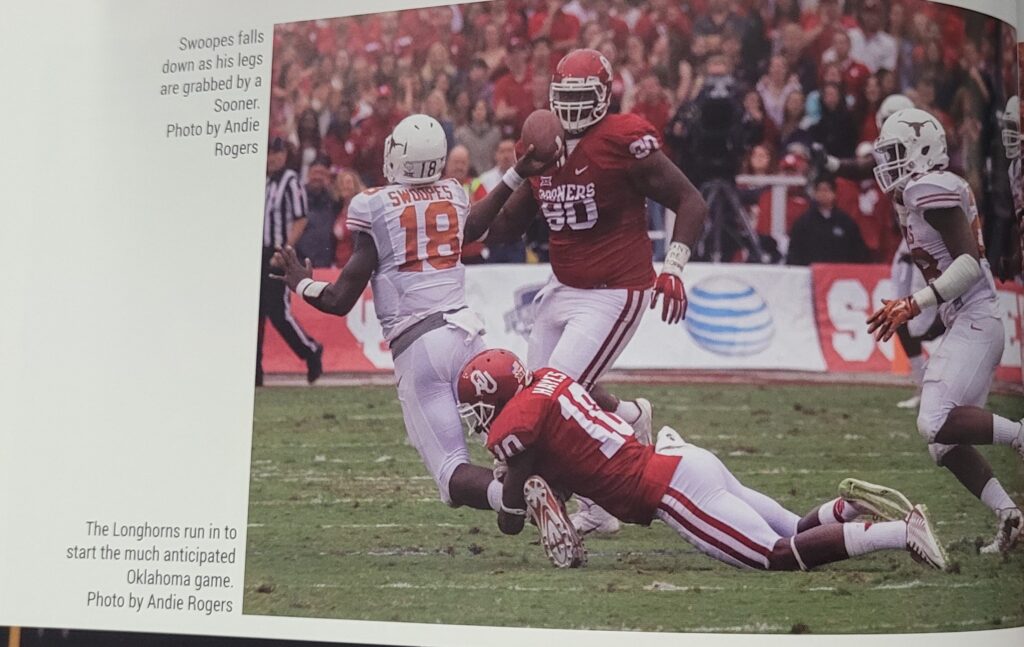
2013-2014 football Swoopes vs sooners 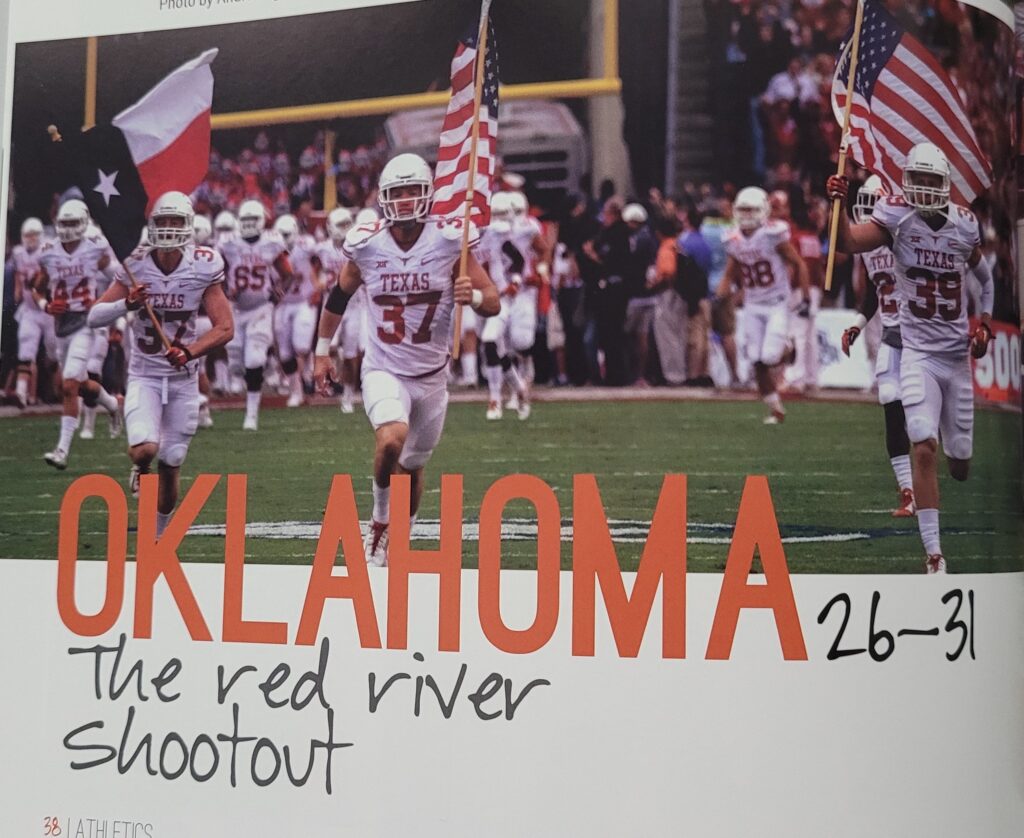
2013-2014 Texas-Oklahoma football 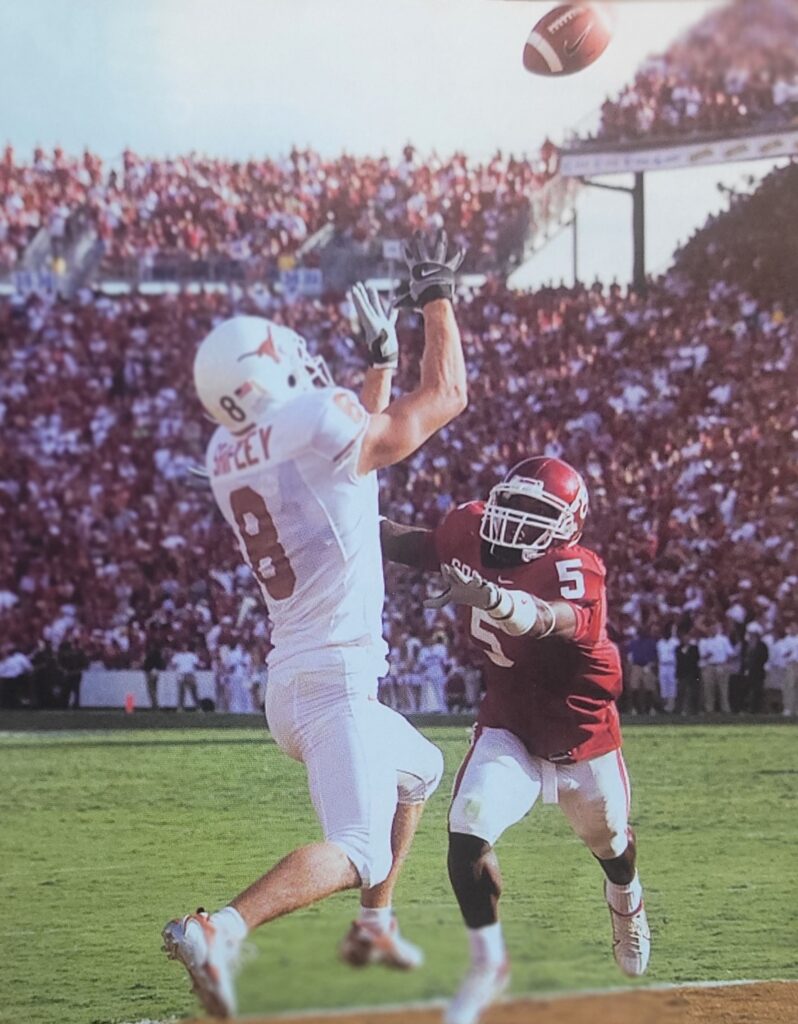
jordan Shipley – Sooners 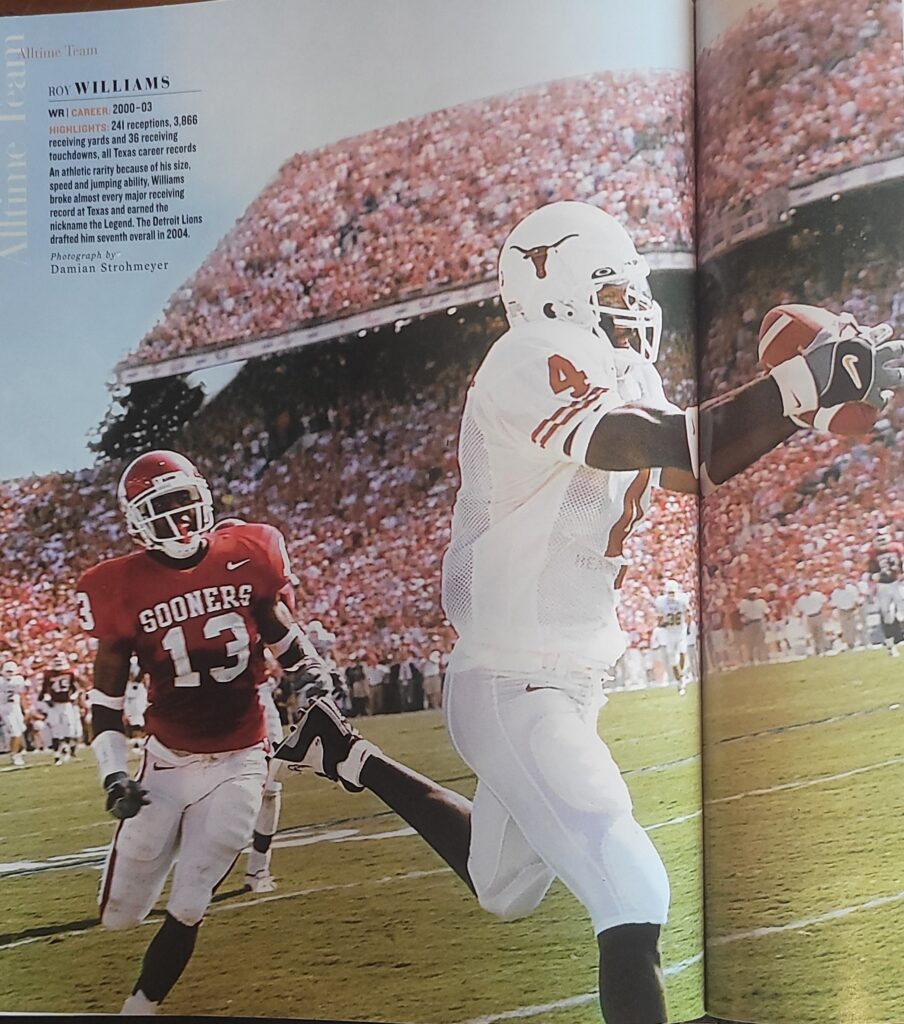
2002 Roy Williams vs. O.U. Sooners 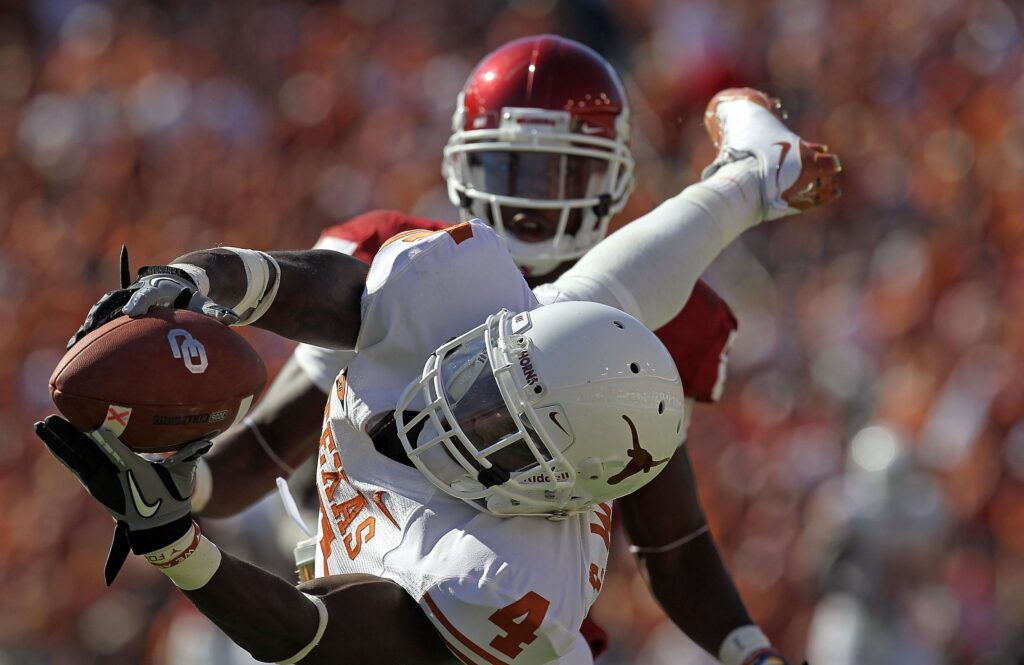
2008 Aaron Williams Cotton Bowl 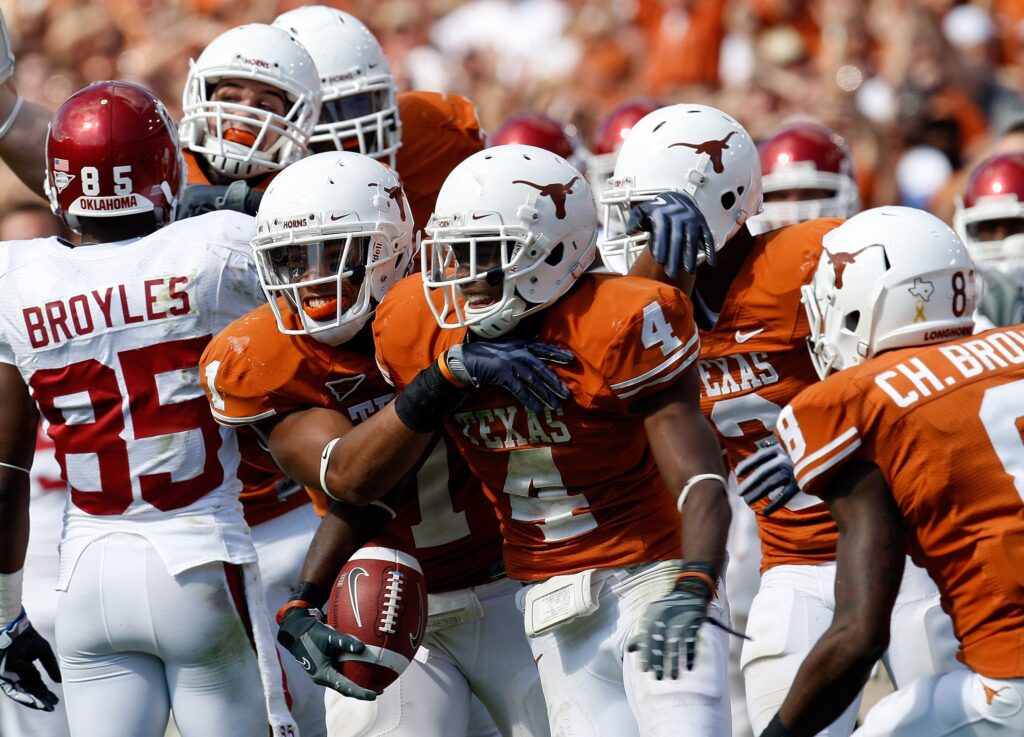
2008 Cotton Bowl Aaron Williams 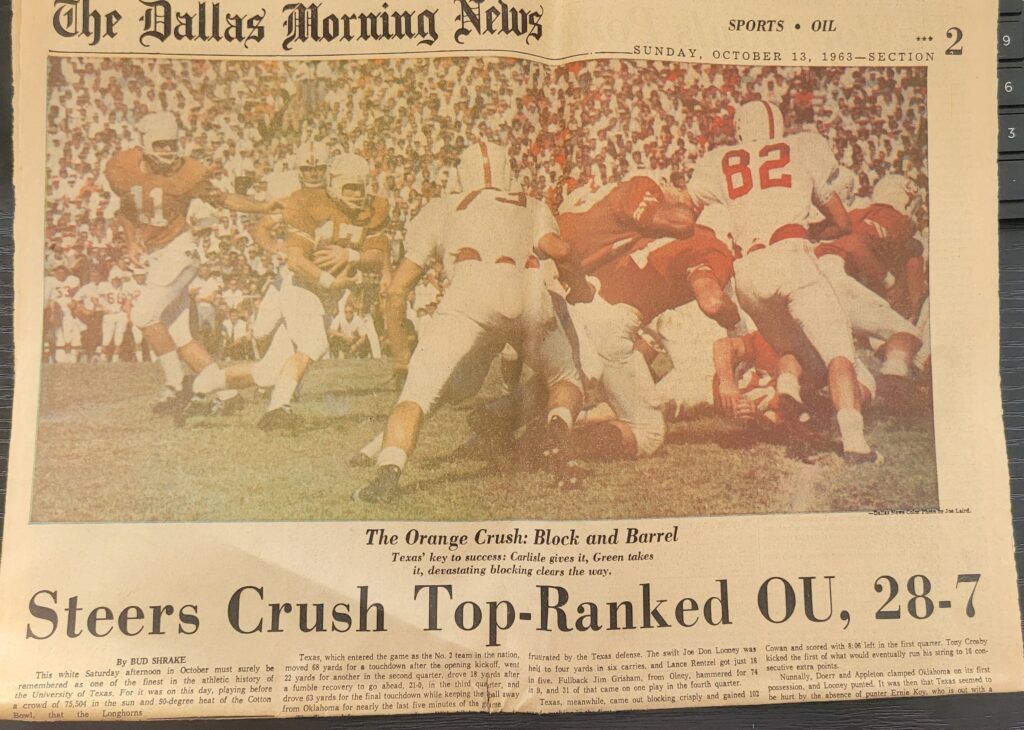
1963 Cotton Bowl Sooners 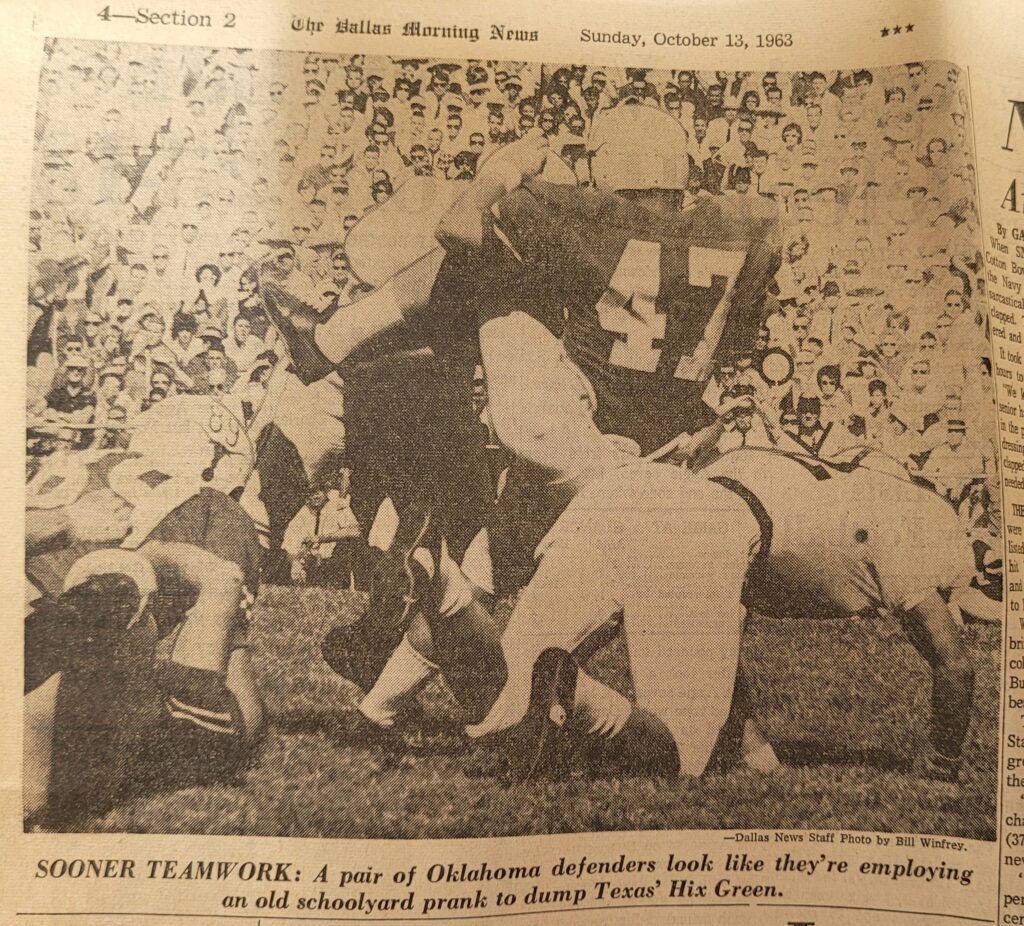
1963 Hix Green
